Councils addressing the rental crisis

Reimagining how councils design cemeteries
From where you’d rather be: WA’s booming blue economy
EXCLUSIVE INTERVIEW WITH ALGA PRESIDENT


Councils addressing the rental crisis

Reimagining how councils design cemeteries
From where you’d rather be: WA’s booming blue economy
EXCLUSIVE INTERVIEW WITH ALGA PRESIDENT

While traditional trade publications have quality audiences and high levels of trust, they can lack the full range of services to guarantee a return on your investment. And while traditional marketing agencies offer the latest marketing techniques, they don’t have the audience or the industry understanding the B2B sector needs.
Monkey Media is the missing link that brings together a trusted brand and powerful audience, with a complete agency offering.

As we delve into the colder and darker months of the year, I’m sure I am not the only one feeling slightly envious of those in the warmer LGAs –such as the City of Cockburn depicted in our sunny cover image.
I’ve found with much of life it’s all about your perspective, with this idea helping to form the underlying theme of this issue – new ways of solving old problems by looking through a fresh lens – finding glimmers of hope from new vantage points, and warmth even in the coldest days.
There is a lot of change happening in the sector at the moment, and a lot of pressures being felt not just by the local government sector, but across the country, as the cost of living bites down and the rental crisis deepens. As many of you know, it is councils too who are being forced to make do with less, with rising prices making service delivery and community upkeep more difficult as 2023 passes by.
However, as with the many challenges the local government sector has faced in recent times, stories of hope, resilience and community are rife. In June, I was privileged to be able to attend the Australian Local Government’s (ALGA) National General Assembly (NGA) for 2023, with discussions taking place that I’m sure gave many hope of an easier future.
The sector discussed pressing topics, such as the Voice, the housing crisis and preparing for future disasters, and featured many notable speakers. I also sat down with ALGA President Linda Scott to discuss these issues deeper,
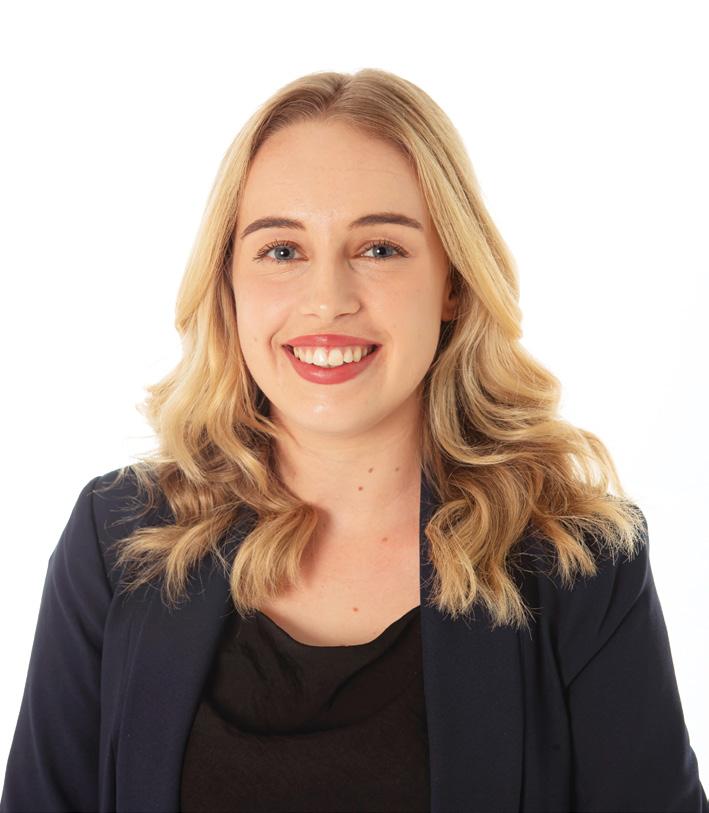
and find out what the NGA 2023 theme of ‘Our Communities, Our Future’ means to her.
We also had a candid interview with Local Government Professionals (LGPro) President, Liana Thompson, on LGPro’s case report on councillor misconduct to the Victorian Minister for Local Government.
I was also lucky enough to have some excellent help making the magazine (and every Council Magazine for that matter), this is my first issue with my newly appointed Assistant Editor Stephanie Nestor. Stephanie has been working as a journalist for Council Magazine and its sister magazines for over a year now, and had so many good ideas (and our contributors loved her so much!) that I had to ensure Council had her undivided attention full time.
I hope you enjoy this issue and I look forward to connecting with you all through the latter half of the year. April Shepherd
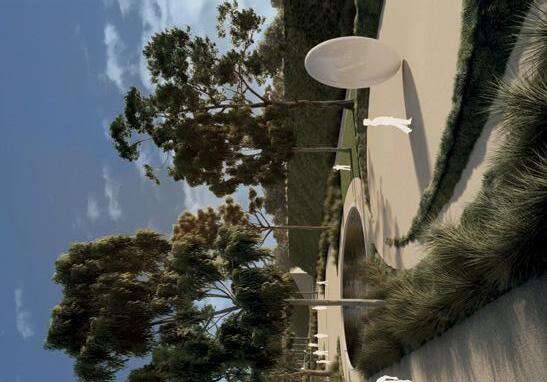



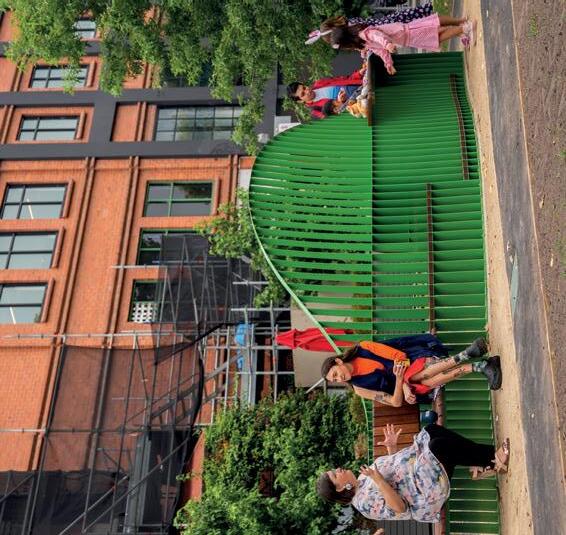

Every job has its challenges, but every worker has the right to a safe, and healthy workplace. For councils, the exceptional cases of poor-behaving councillors negatively impact workplace culture, decision-making, and the health and safety of employees. With Council Standards of Conduct and the Local Government Act now blurring how to report poor behaviour and inadequate ramifications of misconduct, the Local Government Professionals (LGPro) have consulted to submit a case report on councillor conduct to the Victorian
For millennia, resource sharing between jurisdictions has been in play, from crops to armies, unrelated regions have come together for the greater good of their communities. So why are councils stopping short of the big payoff when it comes to shared services?
In a traditional sense, a cemetery is a place for the dead to rest, but as Australia’s population increases in metropolitan regions, large areas of land cannot be reserved solely for the dead – cemeteries must also be gathering places for the living.
Australia is currently experiencing a record-level rental crisis, attributable to a period of incredibly low vacancy rates and rising rental prices. Many have pointed the finger at the growing number of shortterm rentals as a reason behind the lack of available homes, with some councils taking action to deter or restrict their presence, amongst other initiatives to curb the wider crisis.
At this year’s NGA Council Magazine Editor, April Shepherd, sat down with ALGA President Councillor Linda Scott to talk about future challenges, championing First Nations voices, and what the NGA’s 2023 theme of ‘Our Communities, Our
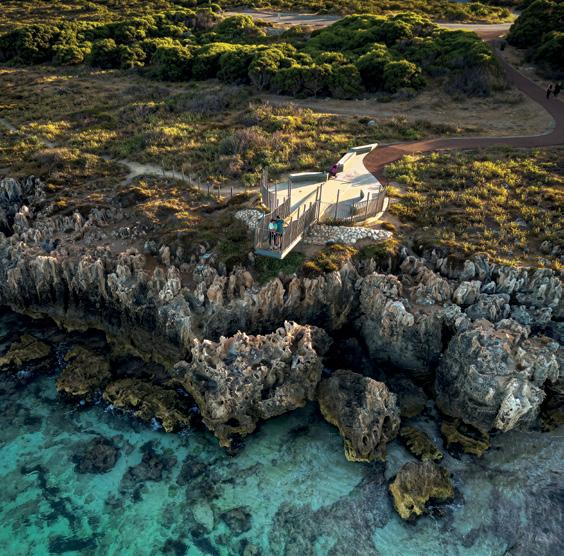

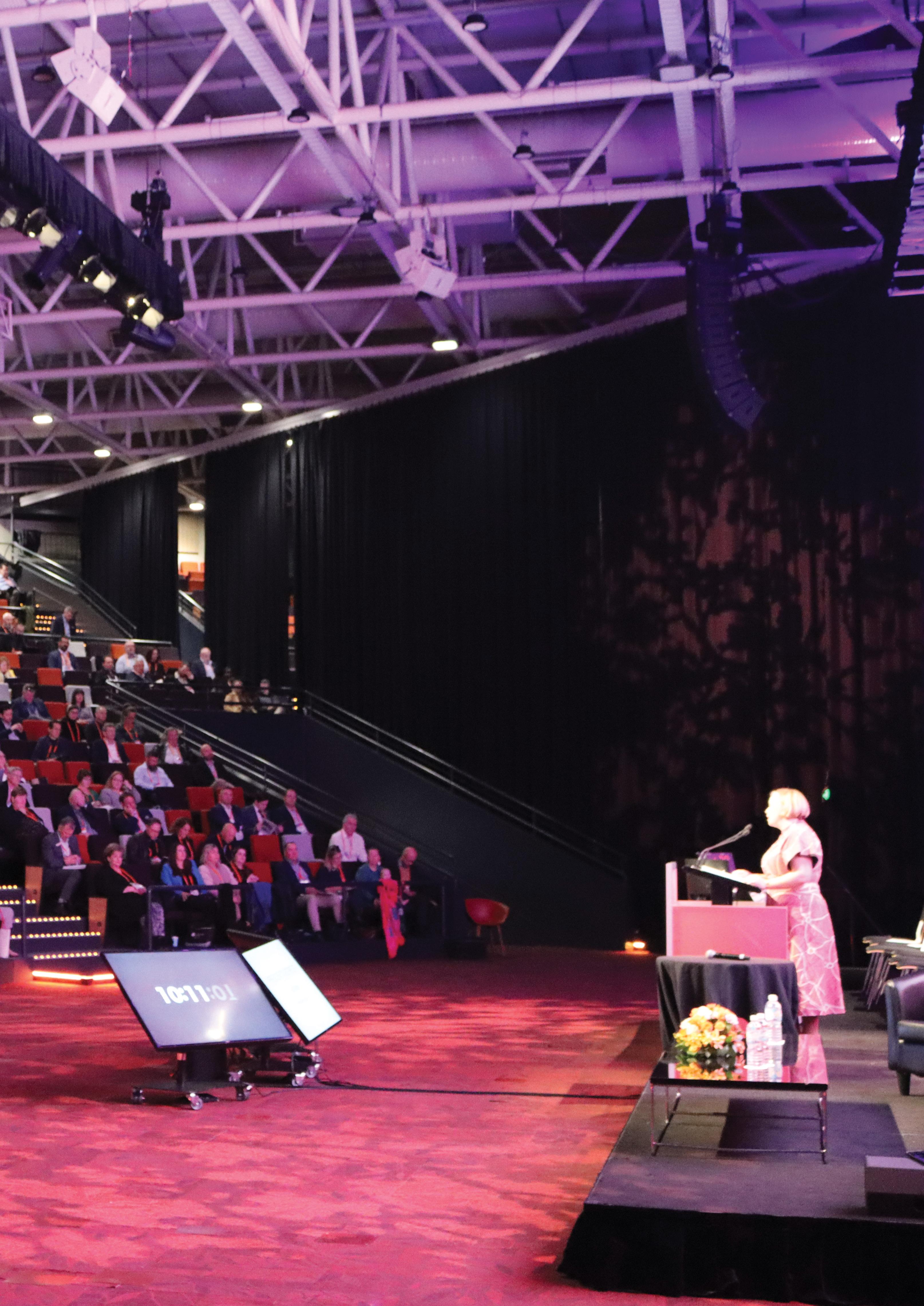 By Council Magazine Editor, April Shepherd
By Council Magazine Editor, April Shepherd
Every year the nation’s executive local government staff, councillors and mayors congregate in Canberra for the Australian Local Government Association’s (ALGA) National General Assembly (NGA), featuring numerous exhibitors, keynote addresses, panels and most importantly, networking opportunities. This event allows the sector to problem solve, collaborate and share ideas and solutions to build more inclusive and productive councils, and in turn, more functional communities that are prepared for future challenges.
At this year’s NGA Council Magazine Editor, April Shepherd, sat down with ALGA President Councillor Linda Scott to talk about future challenges, championing First Nations voices, and what the NGA’s 2023 theme of ‘Our Communities, Our Future’ means to her personally.
Every June the streets of Australia’s capital city fill with a different group of government professionals – the local government sector – with representatives from Australia’s 537 councils converging on the city for the NGA. This year, the event featured a timely theme of ‘Our Communities, Our Future’, highlighting how the sector must work not just together with fellow councils, but with all levels of government.
This year’s event, held at the National Convention Centre from 13-16 June 2023, kicked off with the Regional Cooperation and Development Forum; with the official NGA program beginning on the 14th.

The event featured addresses from the following influential people, offering insight into the theme, their communities and how councils can face future challenges together:
∞ Federal Minister for Infrastructure, Transport, Regional Development and Local Government, the Hon Catherine King MP
∞ His Excellency Vasyl Myroshnychenko, Ambassador of Ukraine
∞ Leader of the Opposition, the Hon Peter Dutton MP
∞ Comedian Jimmy Rees
∞ Brendan Moon AM, Coordinator General, National Emergency Management Agency
Many mayors also presented and weighed in on panel discussions with the following panels showcasing a variety of opinions and thought-provoking commentary: A Conversation About the Voice, Cyclones, Fires and Floods, Australia's Affordable Housing Crisis, Cyber Security and Local Government and The Future of Local Government, to name a few.
The program also included some comedic relief from comedian Jimmy Rees, who first became famous from his decade-long stint on the children’s television show Giggle and Hoot, and now is a well-known social media entertainer and influencer.
We brought together the nation's 537 local governments to share innovation and allow us all to take home ideas to our local communities about the work of other councils. We also want to be able to speak with one voice to the Prime Minister and the Federal Government about the things that local governments need to support our communities for the future.
Our sessions are on everything from the provision of affordable housing to climate change, the Voice, and cybersecurity. And, of course, we hear from the Federal Government and the Opposition on a huge range of opportunities for councils to share innovations.
Like our communities under pressure from rising inflation, local governments are being asked to do more with less – so for the future, sharing innovation and seeking more support from the government are our real priorities in the face of that really significant financial challenge.
We see councils working together in so many ways, such as to jointly procure or provide services across a region in a way that's very collaborative – such as a shared library network.
So something that's worked for one coastal council to prevent a disaster may very well work in another coastal council on the other side of the nation. We are seeing councils being given awards by the Federal Government – a whole smorgasbord of great ideas that other councils can be led to.
I'm very proud to represent my own community in the City of Sydney – which makes me realise that the Governor General's description of local government as the level of government that ‘looks people in the eye’ is very accurate.
Like all councillors, I get stopped by my community and neighbours who ask me for support to get a new tree planted, rejuvenate a playground, build a new skate park or improve our City of Sydney library services. Every day, my community is very engaged with me as a councillor and I find a deep sense of reward from undertaking that work at a local level.
Nationally, our goals at ALGA over the next 12 months are to ensure that all councils can be sustainably funded to be able to support our communities.
We know as families face increased cost of living pressures from inflation, they will come to rely on the free or low cost services that councils provide more. We saw in the COVID-19 pandemic, for example, many councils resorted to feeding communities, providing Wi-Fi access and ensuring people had open spaces to play and exercise.
These activities that are free or subsidised by local governments become even more important in the current economic climate. It's our goal to ensure that the Federal Government is supporting local governments to be financially sustainable enough to support our communities through these times.

ALGA is very proud to be a signatory to the Closing the Gap agreement with the Federal Government and the states and territories. Many councils have their own Closing the Gap plans or reconciliation plans with a huge series of proactive actions that local governments are taking, whether it be to increase Indigenous employment, or to increase procurement from Indigenous businesses. This, for example, could ensure that our pools in remote and regional areas are able to support Indigenous healthcare needs, allowing children to swim at a low cost regularly, to have fun, swim and prevent ear infections.
There's a huge amount that councils are doing to play our part in Closing the Gap.
We acknowledge, like every other level of government, that the progress on Closing the Gap targets is not acceptable. The gap between Indigenous Australians and nonIndigenous Australians is not closing fast enough, and in some cases it's headed in the wrong direction.
- Linda Scott, ALGA President
So like every other level of government in Australia, we understand the deep responsibility to look intently at what more we can do to close the gap.
The Federal Government made a commitment at the last election to fair funding increases for Financial Assistance grants. Seeing those delivered by the Federal Government is a real priority for ALGA, and that will be a key message that councils are pushing for.
At the Australian Council of Local Governments, we have celebrated being given a seat back at the National Cabinet, at the Council of Federated Financial Ministers and all the treasurers. We've celebrated the reestablishment after more than a decade of the Australian Council of Local Governments.
It's great to have a local government truly back at the table working in partnership with the Federal Government.
But to truly collaborate and succeed as governments, we need to see fair funding increases to financial assistance grants delivered to ensure councils are able to support our communities in the way that we need. We have a council in Western Australia that is 97 per cent dependent for their income on federal assistance grants. We have another council I met recently in Western Australia, literally crowdfunding for their airfield. We have councils trying to support incredibly marginalised communities in very remote parts of Australia with a very small rate base. We have councils in New South Wales and Victoria rate capped, and the increases in their expenses are in no way keeping up with inflation and the caps that are being placed on rates.
As we look to the future, we hope a stronger partnership with the Federal Government and a fair funding allocation of Financial Assistance grants will be able to be delivered.
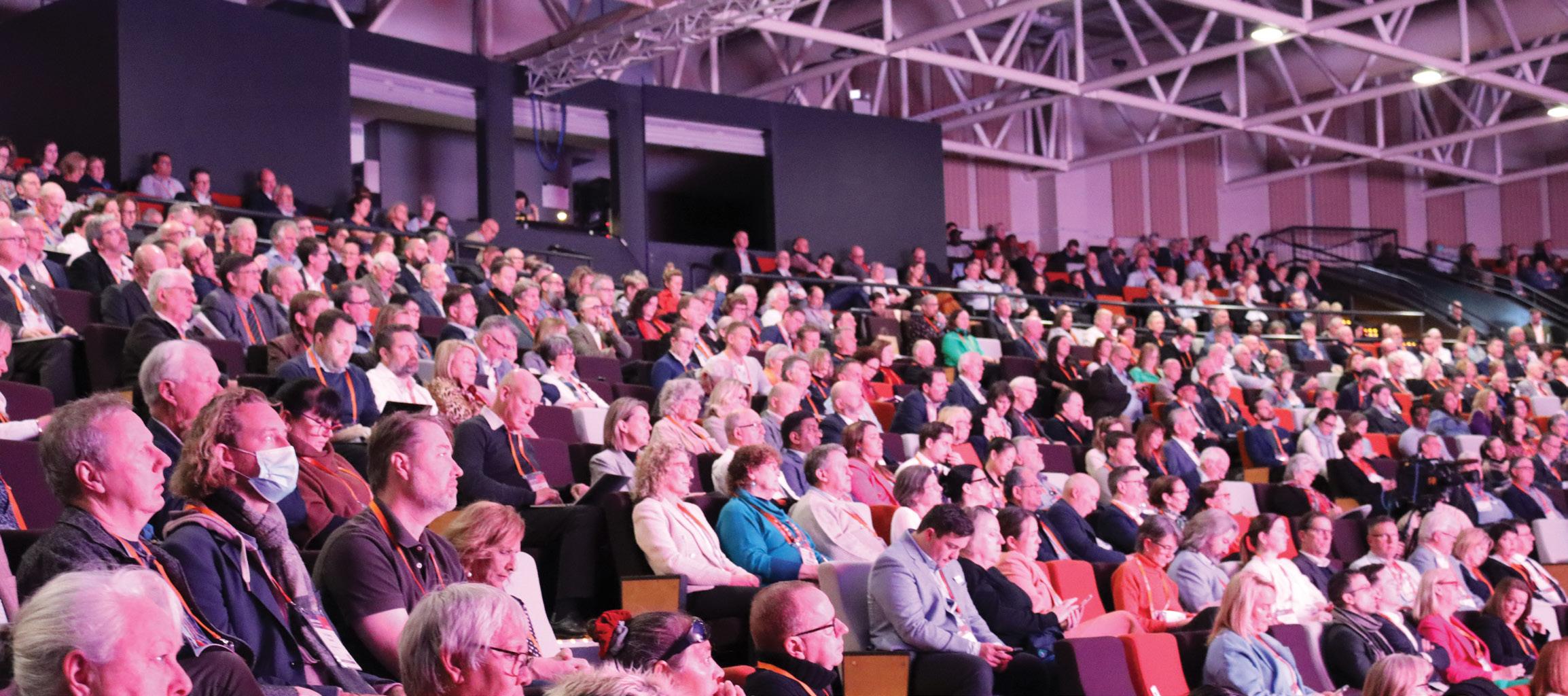
The Victorian Government is rolling out new bins across the state for recycling glass, with many councils taking up the initiative.
Acting State Minister for Environment, Lily D’Ambrosio, visited the City of Merri-bek in May 2023 to announce that the new purple-lidded bins will be rolled out to residents across the municipality in July.
“The four-stream recycling system will work alongside the new Container Deposit Scheme to make it easier than ever for Victorians to recycle their glass, so that it can be turned into new products,” Ms D’Ambrosio said.
“Our new household recycling services will maximise our recycling capacity, create new jobs and divert 80 per cent of waste from landfill by 2030, while helping to reduce emissions by 50 per cent.”
By separating glass, Victoria will be able to recycle more glass into new products and re-use more materials from the yellow mixed recycling bin due to reduced contamination from glass. The glass bin will work alongside Victoria’s new container deposit scheme, CDS Vic, which commences on 1 November 2023 – making it easier for Victorians to recycle their glass whether they are at home or out in the community.
The City of Merri-bek will become the 13th early-mover council to complete the rollout of its kerbside glass service, joining Ararat, Whittlesea, Colac Otway, Hobsons Bay, Horsham, Macedon Ranges, Moyne, Pyrenees, Surf Coast, Warrnambool, City of Yarra and Yarriambiack, with other councils continuing to prepare for their rollout.
City of Merri-bek Mayor, Angelica Panopoulos, said, “We’re proud to be a
leader in sustainability and early adopter of the four-stream waste service, and this funding will help us ensure the transition is as smooth as possible for our community.”
The State Government has invested $129 million to support all Victorian councils to buy new bins, improve drop-off facilities, deliver education campaigns and ensure they have the infrastructure in place to roll out these reforms.
The four-stream recycling system is a key part of the government’s waste and recycling reforms, ensuring that it meets its goal of diverting 80 per cent of all material away from landfill by 2030, including 20,000t of glass.
The government said the reforms will create nearly 4,000 new jobs for Victorians and boost the state’s economy by up to $6.7 billion by 2030 –backed by its $515 million investment to deliver the biggest ever transformation of the waste and recycling sector in the state’s history.
This investment includes $380 million to deliver the circular economy policy, Recycling Victoria: A new economy, which will further reduce waste, boost jobs and establish a recycling system Victorians can rely on.

CREATING CYCLES. FOR LIFE.


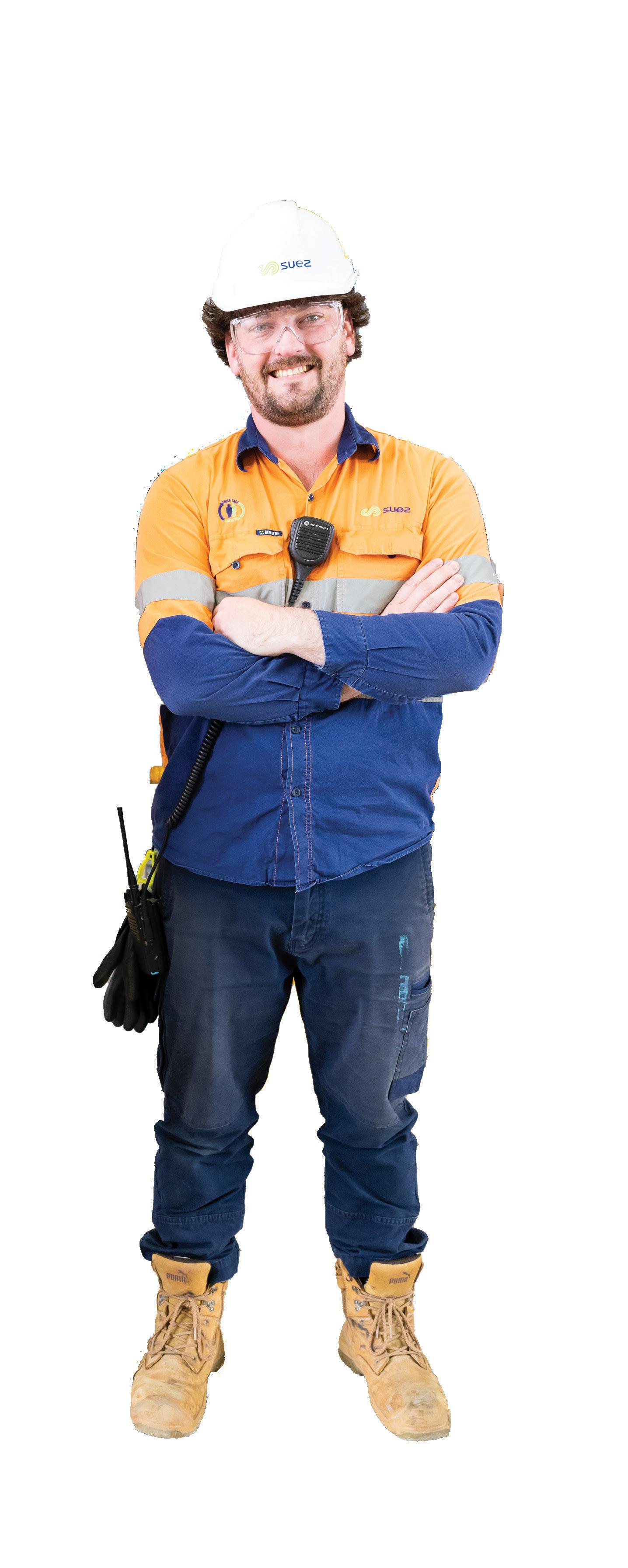
Shoalhaven City Council has endorsed the Federal Government’s plan to deliver a $40 million road improvement package to the region.
The decision to commit to a Program, Project Management and Engineering (PPME) partnership model to complete upgrades to several major roads in Shoalhaven will progress the improvements committed to as part of the 2022 Federal Election.
Shoalhaven Mayor, Amanda Findley, said reaching this agreement enables Council to deliver these significant road works projects while maintaining the works program already planned to improve other roads across the region.
“This is a positive result for everyone involved and clears the way for us to go to market for a delivery partner to plan, design and manage construction of these roads through to completion,” Mayor Findley said.
The roads include Forest Road, Callala Beach Road, Callala Bay Road, Culburra Road, Coonemia/Currarong/Callala Bay intersection and Greenwell Point/Worrigee Road intersection.
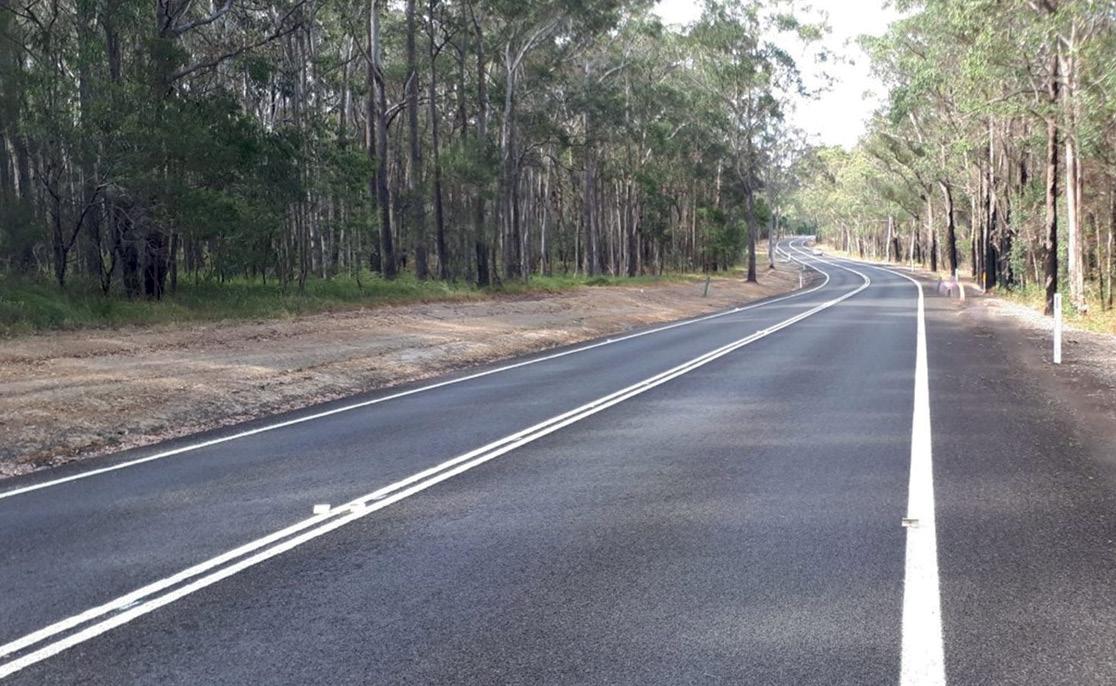
Member for Gilmore, Fiona Phillips, said, “I’m excited to see that the Albanese Government’s $40 million commitment, delivered in the October 2022 Federal Budget, to improve these local roads, will be realised through a sensible delivery model that doesn’t compromise other necessary road works.
“I will always work constructively with Shoalhaven City Council to provide funding where possible to help Council fix local roads. Like you, I’m looking forward to more local roads being fixed,” Ms Phillips said.
Council has been working with the Federal Government and Transport for NSW to finalise a milestone payment schedule that will include an initial payment at the commencement of the project to fund the scoping and design phases.
Once a Partner Consultant is appointed, scoping and design will commence with a view to having packages of work roll out progressively through 2024, 2025 and into 2026.
Featured image: Callala Beach Road. Image Shoalhaven City Council.

You’re invited to Australia’s premier climate and clean energy event for elected officials and chief executives.


When: September 6-8, 2023
Where: RMIT Storey Hall, Melbourne
Program and Events
✔ Electric Vehicle Showcase and Drive Day
✔ 2.5 days of learning, discussing and networking
✔ Plenaries, panels and breakouts
✔ Meet climate experts
✔ Awards Gala dinner at the State Library
✔ City walking tours
Book your ticket
If you’re an elected official or chief executive, use discount code COUNCILMAG and get $350.00 off your All-inclusive Regular Ticket.

The Municipal Association of Victoria (MAV) has announced the appointment of its next Chief Executive Officer (CEO) following a national recruitment process.
New CEO, Kelly Grigsby, has extensive experience in local government leadership roles. Ms Grigsby is currently the CEO of the City of Hobart and was formerly CEO of Wyndham City Council (2015-2021).
Ms Grigsby’s background includes city shaping, organisational transformation, service reform – and through her work as a respected sector leading CEO – is experienced in intergovernmental influencing with experience at state, national and international levels.
Ms Grigsby is also a Senior Honorary Fellow at the Melbourne School of Government and a member of the Committee for Economic Development of Australia (CEDA) State Advisory Council.
MAV President, Councillor David Clark, said Ms Grigsby was selected
Toowoomba Regional Council (TRC) has announced it will transition its fleet to electric vehicles (EV), endorsing a strategic plan to provide a pathway to sustainable fuel assets.
The Fleet Transition to Sustainable Fuel Action Plan was adopted by Council at the Ordinary Meeting on 16 May 2023 and will provide a blueprint for the strategic transition to sustainable fuel assets.
TRC Infrastructure Services Portfolio Chair, Cr Carol Taylor, said the adoption of the plan was a key step in Council reducing its carbon footprint.
“Sustainability is one of the five goals of TRC as an organisation under our Corporate Plan and to deliver on that commitment back to our community, we must look at all avenues to become more sustainable, which includes
by the Board after an extensive and highly competitive national recruitment process.
“The MAV Board is excited to have secured someone of Kelly’s calibre and experience, who will bring a contemporary approach to leading the local government sector into a new era in Victoria over the coming years,” Cr Clark said.
“Kelly is well-recognised in the local government sector as an innovative, result-focussed and visionary organisational leader. We look forward to welcoming her back to Victoria.”
Ms Grigsby has been appointed for a term of five years and will commence in the role on 24 July 2023.
“I am thrilled to welcome Kelly to the role of CEO at the MAV and am confident that her leadership will help the MAV continue to deliver exceptional outcomes to the local government sector and their respective communities,” Cr Clark said.

transitioning our fleet to alternative fuel sources over time,” Cr Taylor said.
“Council has approximately 700 light and heavy vehicles and 1,100 earthmoving, mowing and other equipment assets that may be suitable for transitioning to sustainable fuels in the future. The Action Plan Council has adopted will be incorporated into the Fleet and Logistics Business Plan and provide the framework for assessing the feasibility of transitioning each fleet asset.
“Council has begun the transitioning journey with work currently underway trialling electric vehicles, mowers and various other equipment. The lessons being learned from these initial introductions will assist Council with the overall transitioning of fleet assets to sustainable fuel sources.
“In the modern world, Council simply can’t sit on its hands when it
comes to having a more sustainable fleet and we are using feedback and benchmarking from the broader industry and many other local government areas from across Australia to implement a robust plan that will ensure we continue to deliver the services the community expects while reducing our carbon footprint.
“The plan is not just about electric vehicles, there will be other technologies implemented as the plan unfolds over the next decade or more.”
The strategic plan will also involve the roll-out times for installing charging infrastructure across Council facilities and the updating of a number of internal Council policies and procedures aligned to use of these vehicles and plant items.
Featured image: Toowoomba Regional Council.
Pipeline Plant Hire provides innovative solutions increasing Safety and Productivity


Fully equipped heavy plant hire
One call - problem solved
1300 367 046
PIPE HANDLING?
Australian Designed and Built industry leading VacLifts and Pipe Handling systems deliver more features and benefits than any other machine available. Made by Pipeliners’ for Pipeliners’. Your machine or ours, our extensive range of VacLift equipment covers from poly pipe to large diameter steel pipe weighing 15Tonne.
WE CAN ENGINEER A SOLUTION TO SUIT YOUR PROJECT NEEDS
Not just a hire company, our extensive industry experience will match the best equipment to your project needs. We are continually adding new machines to our fleet broadening the type, range and quantity.
www.pipelineplanthire.com.au
ANew South Wales Council has been recognised for its innovative projects in disaster recovery and environmental protection, winning two awards at the 2023 Local Government Professionals NSW Awards.
Byron Shire Council won two categories of the prestigious awards:
∞ The Mullum Flood Recovery Centre was the winner of the Community Partnerships award
∞ The Main and Clarkes Beach Dune Recovery project took the honours in the Environmental Leadership category
Byron Shire Council Mayor, Michael Lyon, said the awards were well deserved recognition for the amazing work being done by Council staff and the Mullumbimby and District Neighbourhood Centre.
“The centre, that was set up at the Mullumbimby Civic Hall, provided people with support, information, resources and access to state, federal and other agencies and organisations working in the recovery area,” Mayor Lyon said.
“It’s an award that recognises the amazing work of not just our staff, but everyone involved, including the Mullumbimby and District Neighbourhood Centre whose staff and volunteers make an incredible difference to our community every day.

“From March to August last year support was provided at the Recovery Centre to people and businesses on more than 8,000 occasions, in an environment that was safe, nurturing and reflective of our special community."
Coordinator of Coast and Biodiversity, Chloe Dowsett, accepted the award for Environmental Leadership which recognised the success of the Main and Clarkes Beach Dune Recovery project.
“Just over six months ago we brought in heavy equipment to move sand from the tidal zone up the beach to artificially rebuild the badly eroded sand dunes,” Ms Dowsett said.
“This sort of sand scraping project mimics the work done by nature, but much more quickly and the impact on the dunes has been very positive with native vegetation growing, wildlife returning and the dune system continuing to rebuild.
“Severe beach erosion like we recently experienced at Byron Bay’s Main Beach is a natural process and it has been so rewarding to see the success of this recovery project,” Ms Dowsett said.
“It is just terrific to see the innovative work of Council acknowledged at such prestigious awards which are a showcase of some of the best work being done at local government level in NSW,” Mayor Lyon said.
The City of Melville has revealed that it has been working with Whadjuk Traditional Owners and Elders to develop a plan to revitalise Goolugatup Lowerlands into a space that celebrates the cultural significance of the site.
The City marked a major milestone in the revitalisation of Goolugatup Lowerlands, with the Whadjuk community, City staff, residents and wider community coming together for a smoking ceremony, storytelling, music and design reveal on 20 May 2023.
More than 250 people attended Karla Boodja Bilya Djinda (Fire Land Water Stars), which kicked off a public program of exhibitions and talks throughout May and June.
City of Melville previewed designs to transform Goolugatup Lowerlands from an under-used foreshore site into

a community, recreation, and natural space that brings reconciliation into focus by celebrating the culturally significant site and its heritage.
The designs are a culmination of more than 12 years of work and consultation with Traditional Owners and Elders, heritage site informants, the community and key stakeholders.
The revitalisation will reconnect and unite Goolugatup Lowerlands with the cultural and heritage precinct Goolugatup Heathcote through landscape and interpretation design.
The upgrades include new barbecues, an outdoor kitchen, a large stairway with landing lookouts, seating, toilets, lighting, planting and cultural storytelling through signage and trails.
City of Melville Mayor, the Hon. George Gear JP, said the Goolugatup Lowerlands renewal project is an exciting
community driven initiative with a long history of consultation.
“This is a project that has reconciliation at its heart, with the Whadjuk Traditional Owners and Elders collaborating and guiding its development,” Mayor Gear said.
“It is an example of how we’re working to meaningfully support reconciliation in action well beyond one week a year.
“As this project develops, we are looking forward to creating new places for families and friends to gather and cook barbecues, learn about the history and culture of the site, and enjoy our unique plants and animals on the banks of the river.
“We are delighted to be a step closer in the revitalisation of this special site to fulfil its enormous potential.”
From head to toe protection, lifting equipment or working at heights, we protect you.

Ipswich City Council has updated its historical flood mapping tool, giving the public access to a visualisation of the February 2022 flood via Council’s website.
Flood information previously available to the public has for years been limited to historical property scale flood mapping reports – showing the 1974 and 2011 estimated flood extents and indicative levels – and the 2006 Planning Scheme flood overlay.
Ipswich Mayor, Teresa Harding, said Council now had a mapbased tool that can be used to visualise historic flood events, as well as provide individual property data.
“This new, user-friendly tool will allow residents to look over the entire council area and choose to see the estimated flood levels for not just the 1974 and 2011 floods, and for the first time publicly provides the estimated 2022 flood levels,” Mayor Harding said.
“This update does not change the flood lines that we use for planning purposes as identified in the Ipswich Planning Scheme – it is simply a helpful tool to give residents an indication of the extent of the city’s three major historical flooding events.
“The February 2022 flood peak of 16.7m, while causing significant damage, was well below both the 1974 peak of 20.7m, and 2011 flood peak of 19.4m at the David Trumpy Bridge.
“Council is committed not just to effective flood and disaster management, but also to ensuring residents have the latest information and advice to help them plan and prepare for future events.
“This is also a critically important source for people being aware of the history of flooding in our city, especially to help inform their decisions in buying, selling or moving.
“Our draft new Planning Scheme, Ipswich Plan 2024, set to go out to public consultation shortly, will contain the most up-to-date flood mapping of our flood modelling updates, providing the best available information to guide future development in our city.”
Flood mapping for the February 2022 extent in some rural parts of the Ipswich local government area is limited due to data availability.
The flood mapping tool may be updated following future major flood events.
Growth, Infrastructure and Waste Committee Deputy Chair Councillor, Paul Tully, said the newly updated council mapping website provided extensive flood information to residents.
“Previously, Council’s flood mapping tools only generated individual documentation for properties, or major flood information for the 2011 and 1974 floods,” Cr Tully said.
“This new tool modernises Council’s flood mapping by allowing residents to pan and zoom across the entire city and apply the three major floods as overlays, demonstrating Ipswich’s recent major flood history.”
Following the February 2022 flood, Council resolved to investigate the city’s response to the floods.
An independent consultation report, the Ipswich Flood Review, found Council had the necessary resources and structures in place to effectively manage disasters, praised response and recovery efforts, and made 47 recommendations for further improvements.
The review included community participation through listening tour sessions, providing invaluable feedback including a desire from residents for more up-to-date and modern flood mapping.



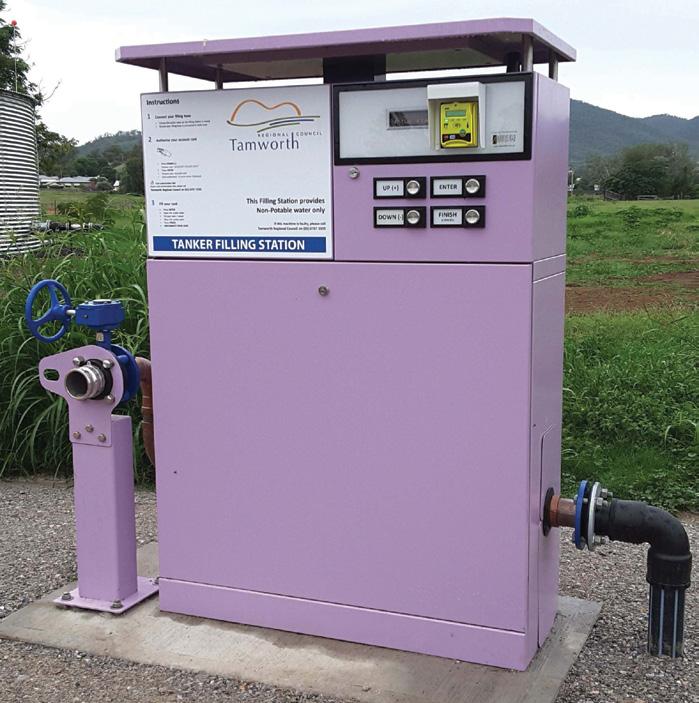
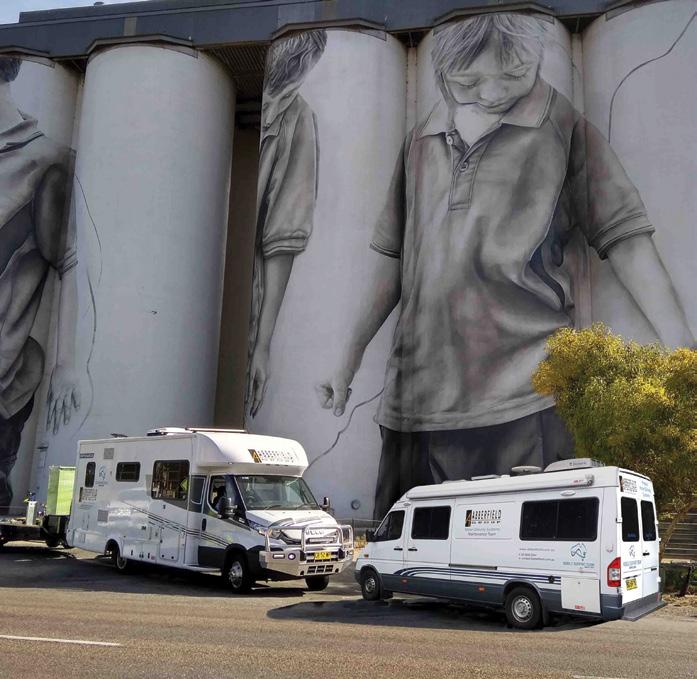

Abberfield’s place of business for decades past, finally owned by Abberfield Industries.

Designed & manufactured by Australians for Australian conditions.
n Highest quality for the lowest whole of life cost.


n Potable Water
n Recycled Water
n Bore Water
n Any Water
Designers & Manufacturers of specialist products since 1968.

The Colyer Family & the next generation
n Owner managed.
n Continuity & support assured.
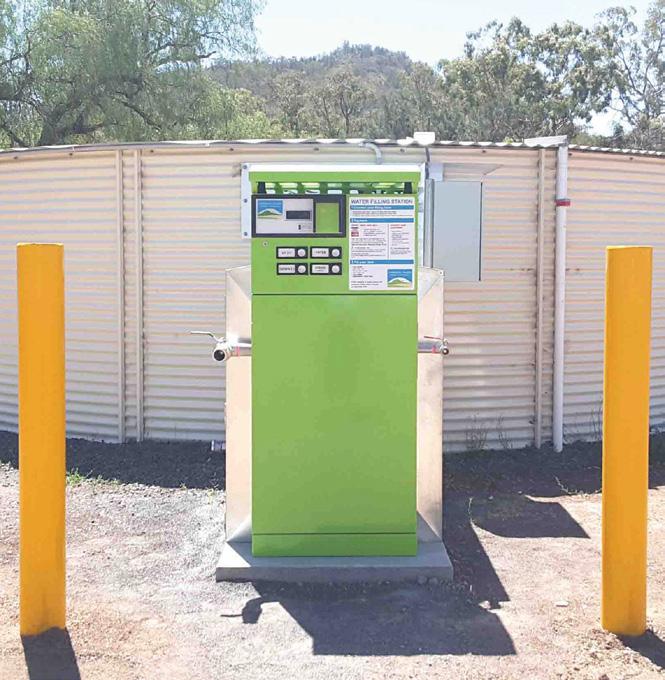

“You can buy petrol any where around Australia... but you can’t buy water!”... Yet. Abberfield’s mission is to change that statistic.

Whole of life support.

Every job has its challenges, but every worker has the right to a safe, healthy workplace. For councils, the exceptional cases of poor-behaving councillors negatively impact workplace culture, decision-making, and the health and safety of employees. With Council Standards of Conduct and the Local Government Act now blurring how to report poor behaviour and inadequate ramifications of misconduct, Local Government Professionals (LGPro) have consulted to submit a case report on councillor conduct to the Victorian Minister for Local Government.
Council Magazine spoke to LGPro President, Liana Thompson, who has 25 years in local government, and is currently Director City Life at Wyndham City Council.
Ms Thompson said that while it's only a very small portion of councillors behaving badly, when one’s poor behaviour goes unreported or unreprimanded, it has a ripple-effect on the rest of council and its community.
“There were a lot of things feeding into the poor behaviour, but the changes in the Local Government Act seemed to exacerbate an outcome where councillors were behaving poorly to each other and then the bar to actually take it through a complaint process was pretty high,” Ms Thompson said.
The LGPro case to the Victorian Minister for Local Government, Melissa Horne, Councillor Conduct: the case for legislative reform, highlighted several current issues with the Standards of Conduct. This includes the “high level of generality”, the “limited insight into the conduct expected of Councillors” and “lack of appropriate context” within the Standards. The case also spoke in-depth regarding the inadequate or “disproportionately light” penalties for proven misconduct and the lengthy reporting process itself.
The Councillor Conduct review called the application process “wholly unsatisfactory”, “far from user-friendly” and “frustrating and unrewarding”.
The LGPro case said the vagueness meant no breaches of Standards of Conduct were found when one councillor called another councillor a “bloody moron”, and no breach was found when a councillor used “colourful” and “inappropriate” language1 to a member of the community.
The complaint process can take anywhere from six to 12 months for it to be seen by the Local Government Inspectorate or for any penalties to be administered (if any misconduct was found at all). Councillors said this often left them deterred rather than encouraged to submit an application.
The long timeframe means that arbiters have been reported to deny following through a complaint application due to too much time passing. This means poor councillor behaviour continues unreprimanded.
Councillors also stated the poor behaviour they were attempting to resolve and penalise would continue throughout the application and review process, leaving themselves “without remedy when a Councillor acts inappropriately towards them”.
Ms Thompson said the poor complaint process has created unpleasant situations.
“The process has been difficult for the elected representatives, but also difficult for council officers to operate in that environment as well,” Ms Thompson said.
“It is a councillor's job to make decisions. When the conversations and the debate don't happen in a respectful way or people don't feel able to participate fully, it has an impact on good decision making. It has an impact on the reputation of the council because people are looking from the community, and are watching how things are running. It has an impact on officers and just having free, frank conversations with councillors about policy matters.”
The current legislative definitions of misconduct and serious and gross misconduct hinder and restrict positive progress and leave council Chief Executive Officers (CEO) unsupported in addressing poor behaviour, and sometimes unable to fulfil their occupational health and safety obligations to their employees.
Reflecting on her long experience in local government, Ms Thompson has seen the negative effects of the poor systems first-hand.
“It's hard to turn up every week and participate at your best in a negative workplace environment,” Ms Thompson said.
“We had people who were on stress leave. We had people who could not go to functions for fear of seeing one of the elected representatives there because that elected representative had abused them in public. We had elected
“It is a Councillor's job to make decisions. When the conversations and the debate don't happen in a respectful way or people don't feel able to participate fully, it has an impact on good decision making. It has an impact on the reputation of the council because people are looking from the community, and are watching how things are running. It has an impact on officers and just having free, frank conversations with councillors about policy matters.”

Liana Thompson, LGPro President and Wyndham City Council Director City Life

representatives who would stand up in council meetings and berate council officers.
“It is not a workplace where you can give your best fearless and frank advice as an officer. The impact on you and your career, your reputation, your mental health; it's really significant.”
To combat the long-standing issue of councillor misconduct and poor review processes, LGPro have worked to advocate for legislative reform and ensure council CEOs have the legal authority to influence Councillor misbehaviour and better support the health and safety of the councillors.
The LGPro case goes further into potential review outcomes, including reprimands, apologies, suspension and other penalties. A new process, with relevant detail, context and a streamlined review of councillor misconduct would support not only a positive and safe workplace, but benefit the future of councils.
“We want a really strong participatory democracy system and that's really important. Having that robustness from our elected representatives is important, but there has to be consequences for those few people who decide to behave badly,” Ms Thompson said.
Ms Thompson said the poor behaviour, often publicised across media platforms, narrows the representation of and the ability for local governments to flourish. Ms Thompson also expressed the concern that the spreading of bad behaviour would restrict the likelihood of good councillors staying for longer, as well as impede future candidates.
“Like any sort of system where people don't feel able to speak out, we might lose really good councillors and good candidates for future elections,” Ms Thompson said.
“How do we get more diversity onto our councils when candidates are looking at this behaviour as an environment to work in? We really want to encourage women to put up their hand to be councillors.
“We want to have different voices at the table because we want to make sure that we are building communities for all, and you can't build communities for all if you've only got a very narrow band.”
News of bad behaviour spreads faster than good, and can even negatively affect people continuing or wanting to start their local government careers.
“These poor examples (of councillor behaviour) are so obvious and people think that that's widespread and that's certainly not the case.
“The essence is, poor councillor behaviour undermines the role of the elected representatives.
“We've got a lot of diverse people in every local government area in Victoria. I want to see that reflection and the ability for people to determine that local government is a great place for them to be able to make a contribution to their community and not to be fearful of that.”
Ms Thompson said that while she understood the timeframe for any changes to the process to be implemented could reach into 2024, June’s future election period would be a good marker.
“Any changes to the system by June 2024 would enable any person who was thinking of putting up their hand to be a candidate in upcoming elections to do so, understanding that the Act is there to support them and the system – if something went awry – was there to back them up.”
LGPro are dedicated in their advocacy for the legislative reform to be considered and help make councils safer, more encouraging and supportive places to work and to provide for their local community.
“There's a shared vision that local government is a really important part of a governance framework, and we want to make sure that it is a safe space for people to participate; for councils to make good decisions, and that we can also get really great candidates who represent community to be able to participate also in councils.”
The viability of sewage services for small communities and the urban fringe is a key challenge facing Australian utilities – often existing municipal sewage infrastructure is too far away or at capacity. Additionally, the cost to provide a small standalone municipal type Sewage Treatment Plant (STP) to service a small population is restrictive.
True Water specialise in designing and installing highquality, small-scale, treatment plants to service small communities, satellite communities, and the urban fringe (500-5000Ep). True Water’s decentralised and semi-decentralised technologies provide utilities a long-term infrastructure solution that is profitable, simple to manage and secures compliance.
Dr Stefan Holler, Water & Wastewater International said, “Currently, the management of sustainable infrastructure is one of the most pressing global issues as urban centres continue to expand.
“Ensuring basic human services, such as water supply and wastewater treatment, is one of many challenges faced by researchers and managers in the 21st century.”
Development in coastal and regional areas throughout Australia has placed pressure on traditional sewage servicing methods; with government, and utilities, often seeking a change in approach to meet regional demand. The challenge arises when finding a solution for smaller regional communities or new developments on the urban fringe.
Septic and aerated systems are crude and the poor-quality effluent they produce poses a high risk to public health and the environment.
A large municipal plant is often the most effective and economical way to deal with wastewater in a large town or city. Likewise, a simple septic or aerated system has been sufficient for managing wastewater in low density rural settings.
However, if you try to scale either method to a suitable size for a small community, you quickly run into problems.
Many existing regional STPs servicing small towns operate at a high cost per head of population and would be not viable without subsidisation. The scale, complexity, and maintenance requirements of municipal scale STPs present critical challenges to smaller communities.
These older models for sewage services are not cost effective or sustainable for small-to-medium sized communities. Sustainable options must combine reliable technology with economic feasibility.

Thanks to recent technology developments, leading global manufacturers offer small-to-medium scale STPs that address all economic and operational requirements. This has made the implementation of decentralised or semi decentralised services a suitable solution.
Decentralisation and semi decentralisation involves the collection and treatment of wastewater within small catchments. Where in the past cost per capita was too high, modern technology allows high-quality treatment without complex treatment plants.
The treatment processes involve very few moving parts and minimal chemical dosing, reducing the operational and management costs, and removing daily or weekly site management. Key objectives include economic viability, scalability to meet future need, proven technology, and securing compliance.
PROVIDING SOLUTIONS FOR:
• Municipal Sewage Treatment
• Commercial & Industrial Estates
• Government Projects
• Residential Developments
• Urban Subdivisions
• Resorts & Caravan Parks
• Mining Accommodation
• Airports & Infrastructure
• Service Stations
• Defence Assets

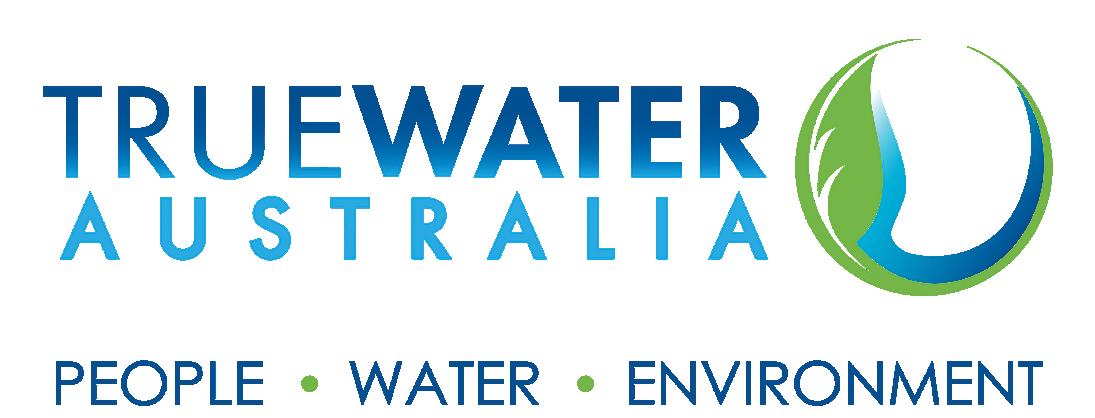

With their low maintenance costs and lack of carbon emissions, electric vehicles and maintenance equipment are a clear path forward for councils striving to reduce their carbon footprint and reach net zero. But how does the total cost of ownership compare to traditional machinery, and how do councils go about adopting a more sustainable solution?
In the context of a looming climate crisis, local government continues to demonstrate its commitment to the cause, with many councils considering – or on their way to –transitioning their vehicle and maintenance fleets to electric.
Despite the preconceptions some hold regarding electric machinery, the reality is that electric maintenance vehicles do provide an option that is both economically and environmentally sustainable.
For councils contemplating making the switch to electric, a crucial first step is considering the total cost of ownership, which refers to the entire cost of owning and operating a vehicle across its lifetime.
Some of the factors to consider when calculating the total cost of ownership include the upfront cost, machine maintenance and fuel requirements as well as replacement and disposal costs.
Electric vehicles and equipment often have a higher initial purchase price than traditional machinery, due to the costs of the battery and electric powertrain, however this should not deter councils from considering electric as a viable option.
Due to their electric parts, electric maintenance vehicles have lower fuel and maintenance requirements than their petrol-powered counterparts, reducing costs and resulting in more operational time for the machinery.
Over time, these savings offset the higher initial cost of electric maintenance vehicles. This means that in the long run, electric maintenance vehicles have a lower total cost of ownership than traditional maintenance machinery, making them a worthwhile investment.
This is all without considering the environmental benefits – many would be surprised to learn that a petrol-powered

lawn mower emits the same amount of air pollution in a singular hour as a petrol-powered Toyota Camry driving from Melbourne to Canberra.
In comparison, EcoTeq’s commercial mowers, compact sweepers, high-pressure pavement washers and litter collection vacuums are 100 per cent electric, offering powerful torque, battery life and durability – all while producing zero emissions.
Unsurprisingly with the low total cost of ownership, electric solutions continue to gain popularity in local government.
For a successful transition to electric maintenance vehicles in a local government setting, there are a number of key steps and considerations.
Firstly, it is important to pinpoint the council’s specific needs and objectives and calculate the costs and benefits for both existing machinery and the proposed electric-powered maintenance vehicles, for comparison purposes.
The next step is to research and evaluate the available electric machinery and their features. At this stage, it is important to test drive wherever possible, and consider the charging infrastructure and requirements.
Then comes the establishment of clear procurement strategies, including selecting suppliers. Following this is the implementation and management of the procurement plan in which the electric maintenance vehicles are purchased.
Finally, once councils have successfully implemented electric-powered maintenance machinery, they must ensure compliance with the procurement policies and procedures, such as providing adequate training to staff and monitoring the performance and total cost of ownership of the new electric machinery.
To learn more about total cost of ownership of electric landscaping & street cleansing equipment, or to read the electric vehicle procurement best practice guide, visit the EcoTeq website: https://www.ecoteq.com.au/
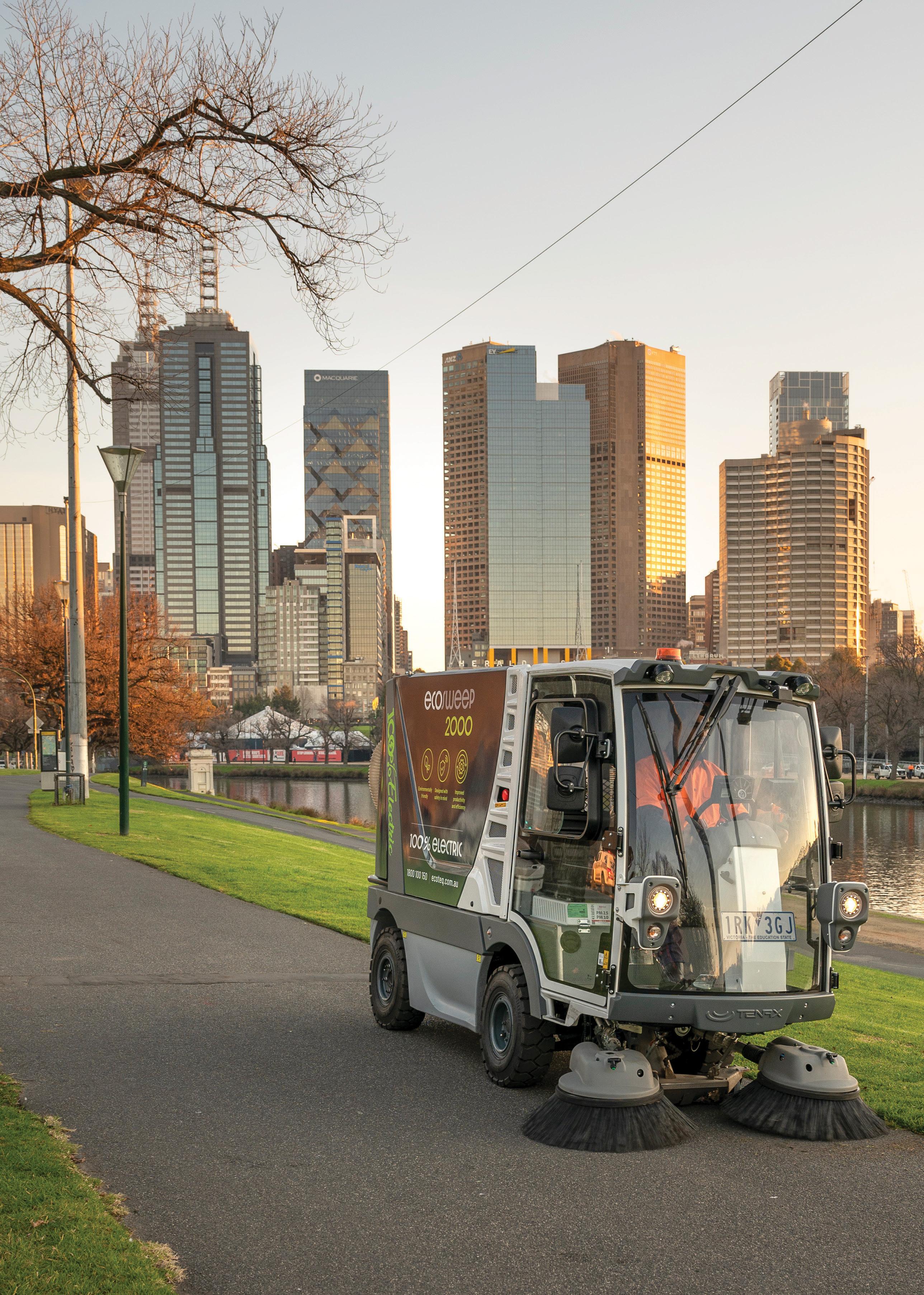


For millennia, resource sharing between jurisdictions has been in play, from crops to armies, unrelated regions have come together for the greater good of their communities. So why are councils stopping short of the big payoff when it comes to shared services?
As councils across Australia strategically plan for their future, one item high on their agendas is alleviating the numerous pressures on their bottom line, without affecting the quality of the services provided to their community.
One option that remains mostly unexplored – that offers perhaps the greatest cost saving of all – is a shared services model that includes the sharing of technology and staff.
Shared services over the last couple of decades have appeared on most councils’ short list for cutting costs. As early as 2008, the Victorian Government set up a model to help councils navigate joint procurement processes while eulogising the benefits of shared services across the board.
However, a report published in 2016 about this initiative called Local Government Victoria and Collaboration Councils: An Evaluation 2008-2016, laments that the type of wholesale resource sharing hoped for did not materialise, stating that, “The barriers that exist are primarily organisational and cultural”.
The University of Technology in Sydney, in the same year, published a research paper of its own called Review of Resource Sharing Arrangements
Between Kentish and Latrobe Councils.
These two Tasmanian councils, under threat of amalgamation at the time, were the focus of this paper
outlining the many benefits and how far resource sharing could be taken. Now sharing a general manager, without losing their own identities as unique local government areas, is one of the hallmarks of its success.
So, what do most councils think of when they are looking to utilise shared services? And are the shared services models implemented currently by councils delivering the cost savings they are seeking?
Up until recently shared services for councils involved a loose group of initiatives by neighbouring councils to collaborate on projects when the timing and desired outcomes aligned.
However, these projects usually only involved the procurement process; going to market together but purchasing separate versions of the technology. Taking this to the next logical step –sharing the technology and staff, which is where the greatest cost savings lie, has remained challenging for most councils.
The pressures that are championing this new model are multipronged, with financial being the obvious one. But costs and benefit analysis for amalgamations is not going to go away, making this the perfect opportunity for councils to not be the victim of the process but actively drive the change themselves.
Librarians have been ahead of the game when it comes to properly sharing services, creating consortia models where smaller libraries gladly outsource all back-end processes to a larger library,
paying only a small percentage of the IT costs. This model has other benefits, especially for borrowers who enjoy an expanded shared catalogue all while keeping their identities and feeling secure in the knowledge that their local library’s viability is not under threat.
When it comes to government programs designed for councils to share services, the Victorian State Government remains ahead of the curve, with the announcement in 2022 for a new program called the Rural Councils Transformation Project (RCTP).
The intention of this program is to help rural councils collaborate and implement new technologies that improve council services for their rural communities. Several projects are already well underway, ranging from a couple of councils to collaborations of up to four or five councils.
One of the projects successfully being implemented under the RCTP initiative involves Northern Grampians, Southern Grampians and Queenscliff Shire Councils.
A major overhaul by any standard, these Councils have come together and navigated the procurement and implementation process for a swathe of Software as a Service (SaaS) based products, while standardising the processes for how these products will be used by staff across these three Councils.
“There’s no limit to what can be achieved when councils work together. The most difficult part is not the technology – it’s the stuff between people’s ears. Sharing and collaborating includes compromising – a key component of living a better life.”
Vaughan Williams, Director of Corporate and Community Services, Northern Grampians Shire Council.

Vaughan Williams, Director of Corporate and Community Services, Northern Grampians Shire Council, has been part of the Council for 18 years and is proud of what this trio of Councils have accomplished.
“So far, the process has been relatively smooth, but this is because we all have our eye firmly on the prize – delivering the best services to our community while reducing the cost of delivering these services,” Mr Williams said.
“It’s a big project that includes our ERP, CRM, budgeting module, records, finance, infringement, payroll and building software. Using multiple vendors as we strive for a best of breed model.
“Our purchasing model is a bit of mixed bag, for example, one of the products we decided on is already owned by our Council so we will bill the other Councils for usage, while other products have been part of a joint procurement process that had one major stipulation – all products must be on a SaaS platform.”
Best of breed was once considered the worst solution back in the day but given the vast variety of SaaS based products
with APIs on the market, the old issues of integration are over as they all talk to each other seamlessly.
Some of the products selected by this group of three councils, such as the one they’re using for planning, building and health, provide built-in templates for ratepayers to use when making applications.
Once these templates are completed there’s no need for a council officer to rekey in this information as the software automatically populates all required internal processes while safely filing it away in the record management system ready for retrieval if needed.
Like many councils, finding staff to service their growing communities
is at times a struggle and Northern Grampians is finding this collaboration is providing a solution for this issue too.
“In rural areas we are operating under the situation of scarcity when it comes to workers,” Mr Williams explained.
“The biggest concern is not losing your job but having a backup if you need to go away or are ill. Having uniform procedures and processes across the three councils means that we can share staff more easily.”
As councils start to take onboard all the benefits provided by SaaS based solutions, they will realise that treating this platform in the same way they did for their customised software residing on on-premise servers is a waste of resources and time.
In the future, councils will make the shift to truly sharing software while playing to each council’s strength. One council may be more proficient at planning, taking on this role on behalf of two or three councils while increasingly becoming subject matter experts – providing a level of service that far exceeds the expertise provided previously.
The biggest inroads councils have made over the last decade in shared services is in the areas of procurement and training, and whilst councils, such as the ones taking advantage of the RCTP initiative, are not common yet, they will be as these models provide proof of concept to councils across both Australia and New Zealand.
As this new trend emerges over the next few years councils may initially find it challenging to make the shift to this new paradigm, but like Mr Williams, I also believe councils are at an exciting moment in the history of shared services, and nothing can hold them back.
Michael Craig has been part of the local government ecosystem for over 35 years, starting out as an administration officer in metropolitan Melbourne.
Mr Craig worked his way through the ranks to become Director of Corporate Services and Finance, holding this position in two regional Councils pre and post amalgamations, before deciding in 2000 to move into IT, to focus on the growing opportunities to improve council service delivery by utilising best of breed software.
His company, Harbour Software, came into being in 2011, after successfully building a fit-for-purpose cloud-based meeting management solution called Doc Assembler.

With a major skills shortage sweeping the country, talent retention has never been more important for Australia’s councils.
Local councils have become fertile hunting grounds for state, federal, and private employers looking to plug their talent gaps.
Nine out of every ten councils are facing job and skills shortages, an increase of 30 per cent from just four years ago. A lack of people inevitably has impacted on councils’ ability to deliver for the community, with two thirds of councils reporting that local projects are either impacted or delayed.
As a result, hanging onto talent has become a burning platform for Australia’s local councils.
AskYourTeam’s data offers insights for solving local government talent retention issues. The company has taken a deep dive into its local government clients’ onboarding and exit surveys to understand the gap between people’s expectations on arrival, versus their feelings after leaving.
It highlights two main areas of focus for retention; psychological safety – feeling safe to tell the truth even when it is unpopular – and manager’s support of their people.
Waiting until people leave to find out how they feel about the organisation as a place to work is simply too late in the game to make a difference. The organisation is likely to repeat the same mistakes with the next crop of new hires. Instead, AskYourTeam recommends asking regularly, and diving deep where issues are flagged.
But getting this information can be challenging, particularly if people aren’t confident to speak up.
Psychological safety is a critical concept in the workplace, for workers and teams, and the people leading them. Giving people permission to be candid – without repercussions – even when delivering bad news, transforms culture, and delivers gold nuggets of insight.
AskYourTeam’s anonymised surveys and reporting can help to close the gap between employee expectations and experience, helping councils hang onto good people. Survey questions are based on factors proven by independent research to drive productivity and wellbeing. Smart reporting and ‘slice and dice’ analytics help identify exactly where the issues are to pinpoint where action needs to be focused. Anonymity ‘bakes in’ psychological safety and gives people the freedom and ability to share their views; particularly important when it comes to sensitive issues such as bullying, harassment, or intimidating behaviour.
While this might seem like a big ask, driving positive change in your council is easier than you think with a partner like AskYourTeam by your side. Over the past ten years it has forged partnerships with 70 per cent of councils in New Zealand, understanding the challenges and supporting leaders at every step of the journey to transform their organisations.
To find out how to get great data to improve retention in your council just AskYourTeam: info@askyourteam.com.


AskYourTeam is the employee experience platform with a difference. There’s no one size fits all with us. Your needs are front and centre, so you get the actionable insights you need to really drive up productivity, wellbeing and retention in your council.
askyourteam.com
It’s easier with the right partner by your side

In order to provide communities with vital services, local governments and utility providers around Australia must maintain water and wastewater infrastructure, which can become expensive and resource-demanding over time. The solution to effective water network management lies in finding new, more circular ways to tackle current problems like aging infrastructure, financial restrictions and environmental concerns.
Regularly maintaining and upgrading water and wastewater assets is an extensive undertaking for any water service provider. Financial and environmental concerns mean budgets and team resources can become strained while striving to keep essential services operational.
Aging infrastructure can lead to large upgrades to modernise or replace existing equipment and assets, especially when it comes to adding new water infrastructure to meet population growth in regional centres. Even with ongoing maintenance, councils and water utilities are often dealing with water leakages, which not only increases costs but results in the loss of treated water.
When it comes to environmental concerns, maintenance and upgrades can be restricted by environmental regulations, as water service providers must take careful consideration to ensure local wildlife and ecosystems are not impacted by works.
Climate change can impact both water assets and resources, with more frequent extreme weather events and changes in precipitation patterns damaging networks and leading to water scarcity as councils struggle to maintain assets.
For both councils and water utilities there is ongoing pressure to provide more reliable and affordable services and ensure their communities are consistently receiving high-quality water supplies to preserve their reputations as dependable essential service providers.
Additionally, non-revenue water (NRW) can pose a great financial risk. NRW refers to water that is lost or unaccounted for in the water supply system before it reaches the consumer.
When water is lost before it reaches the consumer, water service providers are unable to charge for it, significantly impacting their ability to maintain and upgrade water supply infrastructure. Additionally, NRW can result in increased operating costs due to a higher spend on energy and chemicals to treat and pump water that is ultimately lost.
Overcoming these challenges will require local governments and water utility teams to adopt new technologies and methods that can help provide reliable services, while also making maintenance cost-effective and less resource-demanding.
Central Highlands Water (CHW), a water utility company servicing the central highlands region in Victoria, including Ballarat, Maryborough and Daylesford, has entered into a contract with global water management company, SUEZ, to address a number of these challenges. Running over a contract term of 15 years, SUEZ will be working with CHW to supply approximately 75,000 smart meters to the Central Highlands community.
The digital metering solution will allow CHW to remotely gather time-of-day usage data, along with remote meter reading for billing. This data will enable CHW to bill accurately and analyse the consumer water network to identify leaks. Moreover, CHW will be equipped with the tools to proactively
engage with their local communities by identifying leaks, minimising water loss and supporting water conservation.
As a result, CHW will be able to engage proactively with their customer base to educate, communicate and reduce water usage in the long term.
Through this partnership, CHW and SUEZ will upgrade CHW’s existing water meters across the entire service region with fully integrated digital meters. The upgraded technology will be rolled out between 2023-2025.
Jeff Haydon, Managing Director at CHW, said the utility is focused on a digital transformation to support the best outcomes for their customers and community.
“With SUEZ’s help, we can introduce digital metering to revolutionise the way we do business delivering a large number of benefits including leak-detection, minimising water loss and improving the safety of our meter reading team,” Mr Haydon said.
SUEZ’s Business Development Manager, Laurence Daly, echoed Haydon’s comments by highlighting the myriad of benefits these smart meters will provide.
"SUEZ’s digital metering solution provides CHW with a powerful toolset to manage their water assets with greater efficiency, accuracy, and transparency,” he said.
“By embracing this digital solution, CHW will unlock valuable insights, communicate better with end-users, streamline internal processes, and deliver reliable water services to their local communities, as well as recognising significant operational savings."
Finding more sustainable solutions for water networks is critical for councils and water utilities to continue to provide essential services for their communities while facing the challenges of aging infrastructure, environmental regulations and climate change. Particularly, these solutions must assist with efficient water management to ensure water service providers are able to offer reliable water services while efficiently managing resources.
Digital metering is one-way councils can create a strong connection between utilities and communities to help improve services and ensure customer satisfaction.
Innovative digital technologies can offer new ways of understanding how people use water services, how to conserve finite water supplies and how to maintain assets to meet demand.
SUEZ’s strategic plan centres on value creation through implementing proven solutions that increase innovation and strengthen investments, offering circular solutions for councils and water authorities.
As part of the plan, SUEZ is committed to becoming a more agile and customer-focused organisation to support councils to meet their climate and water conservation targets. Exploring emerging technologies, this strategy offers new solutions to existing challenges, and the means to effectively manage water networks.


In a traditional sense, a cemetery is a place for the dead to rest, but as Australia’s population increases in metropolitan regions, large areas of land cannot be reserved solely for the dead – cemeteries must also be gathering places for the living.
Melbourne’s outer suburbs are growing, particularly the outer west. In 2023, the master plan for the new cemetery at Harkness, which encompasses 128ha in the suburb of Melton, was released after years of development.
The new cemetery at Harkness aims to create a modern cemetery that can be used for funeral, memorial, burial and cremation services, while also creating recreational spaces, such as walkways, gardens and sitting areas. This project not only challenges how communities may view cemeteries, but also how they view open spaces.
As Australia's population grows, there is an increasing demand for public land and spaces to be used more wisely to cater for growing communities.
Additionally, for preserving local ecosystems and mitigating the risks of climate change, city planning involves setting aside land to be designated green spaces.
To create open spaces of the future, local governments must look to designing open spaces with sustainability and multiculturalism in mind, to become shared spaces that reflect changing and diverse communities.
Ever since the original plans for Melbourne’s urban green spaces were drawn up in 1929, city planners have known the health, environmental and social benefits of offering people parks to gather in or gardens to observe. Even a hundred years ago, governments knew green infrastructure was integral to creating a livable city.
As Melbourne’s population grew, so did the city, as new suburbs were created to expand the metropolitan region. But often, green spaces were built around the suburbs or retrofitted decades later.
Now in a third population boom, new developments are happening on Melbourne’s fringes and these new suburbs will have green infrastructure included right from the planning stage.
Under the Melbourne Metropolitan Open Space for Everyone Strategy, cemeteries are not classified as open space. However, as 'encumbered' or restricted' public land they can be utilised for a secondary purpose - providing areas for local communities, with social, health and wellbeing benefits as well as the environmental, biodiversity and climate change resilience outcomes.
Open Space for Everyone Program Manager at the Victorian Department of Energy, Environment and Climate Action (DEECA), Fran Horsley, is a member of the Design Review Panel for the new cemetery at Harkness. Ms Horsley said that the new cemetery project offers green space for an expanding suburb from the beginning stages of development by creating a cemetery that has multiple purposes.
“Blue and green infrastructure is essential for livable cities and healthy communities, so we want to emphasise the importance of that," Ms Horsley said.
“While not all spaces can be shared, it's that questioning and challenging of our traditional thinking to say, well, if not, why not?”
The Victorian Government has developed the Open Space for Everyone Strategy, working with 32 councils, State Government agencies and traditional owners to revitalise metropolitan suburbs and create an open space network.
Ms Horsley said, “the vision is very much about having a city in nature that's flourishing”.
This new cemetery project exemplifies this idea of a flourishing green space within a growing suburb.
From the design process, the new cemetery at Harkness was intended to be more than just a place for the dead to rest for the Melton community.
The Greater Metropolitan Cemeteries Trust (GMCT) is responsible for managing 19 cemeteries across Melbourne and developing the new cemetery at Harkness.
GMCT used five themes to guide the project:
1. Sanctuary: visitors will experience feelings of warmth, comfort and peace in a living and continually developing place
2. Inclusivity: visitors will feel welcomed into an accessible local park, not just to remember loved ones but as a community centre where they can experience a range of cultural influences that reflect representation and choice. The space will demonstrate the Aboriginal connection to land and the local stories of Traditional Owners
3. Sustainability: visitors will experience beautifully designed environments with native plants, animals and natural water features. Innovative, sustainable practices will contribute to the growth and development of the natural landscape, and sustainable facilities and processes
4. Innovation: visitors will be able to see a combination of traditional and new memorialisation choices, making it a modern, regional park that inspires people to keep coming back
5. Trust: visitors will be constantly reassured Harkness is organised and administered in a commercially and environmentally sustainable way
Different groups and people contributed their ideas to GMCT during consultation, including the Wurundjeri Traditional Owners of the site, local community members, industry experts, cultural and religious community groups, government bodies, and innovative future thinkers in the deathcare sector.
Andrew Eriksen, GMCT Chief Executive Officer, said, “Cemeteries are one of the few places in urban areas that bring so many communities, histories, belief systems and lives together in harmony, to respectfully reflect and meaningfully celebrate what is important to them.

“It will be expressed in ways appropriate to that landscape, bringing together the mosaic that is Victoria on the canvas that is Country.
“I’m confident that the needs of Victorians for the next century will be met by the design of this new site, which understands the immutable needs while allowing for the unknown.”
Melton is also an area with a growing multicultural community. Melbourne’s outer west is the fastest growing part of Victoria, with almost 40 per cent of residents born overseas, according to the 2021 census conducted by the Australian Bureau of Statistics (ABS).
The master plan process started with an extensive community engagement phase. GMCT and the consortium, which included McGregor Coxall, Architectus, Greenshoot Consulting and Aurecon, actively sought community ideas and feedback on the project via a range of channels to account for the community’s unique needs.
For this multicultural community, it was important to consider various funeral and memorial requirements for different religions and practices, such as burial or cremation. This also meant the areas not used for funeral or memorial services couldn’t disrupt those who are mourning or visiting loved ones.
Ms Horsley said that Melbourne needs more cemeteries and open spaces that accommodate different cultures and religions.
“Having worked with the 32 councils as well as other state managers of open space all the way around Melbourne, everyone is saying that one of their biggest needs is revitalising the quality of open space. It would be beneficial for these designs to be nuanced and considered in terms of differing cultural needs and safety – particularly for women and gender diverse people," Ms Horsley said.
The new cemetery at Harkness will be located on farmland between new housing estates and the Gilgai Woodlands
in the City of Melton, on the traditional lands of the Wurundjeri People.
In a commitment to Treaty and reconciliation, GMCT and the wider Melton community wanted to ensure the site would preserve Wurundjeri values regarding land and how it is used. Members of the public during consultation mentioned the cultural education opportunities for the site, with the possibility of incorporating storytelling elements into the design.
By considering the varying needs of the community, the master plan made allowances for quiet areas, so people could enjoy unique architecture and landscapes, while still prioritising the primary purpose of the space as a cemetery.
Melbourne’s outer west is environmentally unique with basalt plains, shallow volcanic lands and grasslands, and with less canopy, the region is at greater risk of heat islands due to over development and climate change.
Ms Horsley said that creating green spaces is all about understanding the ecological state and needs of a region, instead of assuming all suburbs are homogeneous.
“According to census data, the Western suburbs have higher vulnerabilities of socioeconomic disadvantage and health indicators that may not be reflected the same way as they are in other parts of Melbourne,” Ms Horsley said.
The site at Harkness was previously cleared for farming purposes prior to GMCT acquiring the land, except for a pocket of remnant woodland. The woodlands are of high ecological importance since they are scarce throughout Victoria and act as the habitat for endangered wildlife.
This woodland will form a valuable biodiversity corridor, which connects with Arnolds Creek, while revitalising the creek and woodlands will help support local wildlife and the Werribee River catchment.
During consultation, GMCT heard from groups and members of the public that it was important that the new cemetery be environmentally friendly and protect the native biodiversity of the area.
Despite the innovative approach to open spaces being sites with shared purposes, many people in Australia believe a cemetery should just be a place for funerals and mourning. But in other parts of the world, cemeteries are valuable community spaces.
Ms Horsley said that in Europe, it's a very different culture.
“Cemeteries are tourism sites or local parks because they're places for socialising and recreation,” Ms Horsley said.
“In Australia, we find it a bit more challenging to think about how we can respect cemeteries for their main purpose, while also ensuring they are still beautiful places to visit and socialise in.
Ms Horsley said the new cemetery at Harkness focuses around being a community space.
“The project actually aligns beautifully with the vision, the goals and the objectives of what we're trying to achieve as part of the Open Space for Everyone Strategy, by putting the community at the centre,” Ms Horsley said.
“It's asking what are the community needs and how can we work together to deliver as many of them within a landscape that still respects the main purpose?”
As part of GMCT’s consultation process, community members requested areas that could memorialise the dead and also celebrate life, with green space, trails, native plants that attract wildlife, spaces for sitting and reflecting, picnic areas and water features.
GMCT also considered facilities that could be included over the project’s life-cycle to provide additional services, such as a community garden, cafes, florists, event spaces, or a dog park.
It was also important that all members of the community can access and feel safe within the site, which meant the master plan had to include wayfinding, accessibility and security measures.
For other councils around metropolitan areas, and even regional areas, the new cemetery at Harkness demonstrates the need to involve the community throughout the whole design and consultation process to understand its unique needs.
Ms Horsley said while this approach is about challenging old ways of thinking about open spaces, it’s also about learning from the past.
“It's not all about the future and learning new things, sometimes it's about going back and looking at what was working that we left behind,” Ms Horsley said.
“It's about listening to the community, not barging through. It's important for these conversations to start happening now and to understand that cultural shifts may take some time.”
Learning from this project, GMCT recommends for councils endeavouring to create open spaces that respect culture and prioritise sustainability to:
∞ Work with Traditional Owners to understand their vision and aspirations for the site
∞ Consult with the community and key stakeholders early and often before planning commences
∞ Let landscape and experience lead the design process to drive exceptional place making
∞ Make sustainability, biodiversity and improving the local ecology a priority and build it into the design of the site
∞ Think of cemeteries (or the open space) as a place to be proud of – they can be places to connect with community Even if an open space cannot cater to every community need, the principle behind the new cemetery at Harkness and the Open Space for Everyone Strategy is to build a network of green spaces.
Putting cultural needs and sustainability at the centre of

As the population of Australia continues to grow, increasing pressure is placed on existing infrastructure assets. Maintaining or replacing aging infrastructure presents many challenges for councils, which must operate within tight budgets and limit the impact on communities and the environment. This is why employing non-invasive, economical asset repair and preservation solutions is critically important.

Maintaining infrastructure assets is crucial for public safety and can be an expensive process for local governments, especially as infrastructure ages and the cost of repairs increases.
If maintenance is deferred, repairs become more extensive and create a bigger drain on resources. Finding solutions to increase the lifespan of existing infrastructure and avoid complex reconstruction is an effective way to reduce budget demands.
For almost 30 years, Mainmark has developed and delivered advanced technologies for ground engineering and asset preservation, working with councils to provide void filling, ground improvement and re-levelling solutions.
The core technologies Mainmark employs are Teretek®, Terefil® and Terefirm®.
Mainmark’s Russell Deller said, “Australia has a lot of aging infrastructure that is required to service increasing populations. I think it's becoming increasingly important to ensure that infrastructure assets are well-maintained and preserved.
“From removing trip hazards on footpaths to re-supporting and raising roads or bridges to re-levelling and re-supporting buildings or structures, Mainmark solutions have been successfully employed across numerous assets managed or owned by councils.”
Repair, maintenance or decommissioning of infrastructure often requires road closures and lengthy community disruptions. This can prove challenging for local governments, who must manage the interests and concerns of their constituents.
The main benefit of Mainmark solutions is that they are of a non-invasive surgical nature compared to traditional methods, and the work can be completed quickly, meaning there’s less disruption to communities.
“Our technologies have fast delivery and curing times, which means treated areas can be used immediately or without the delays experienced when using traditional repair or replacement methods,” Mr Deller said.
“Mainmark solutions are non-invasive. It means not having to rip up a section of roadway or generally avoiding excavation altogether. Works are often performed at night while everyone’s asleep.
“It’s not only less disruptive to the community, the speed in which these solutions can be completed ensure they are also significantly more cost-effective, which means taxpayer's money is being more wisely spent.”
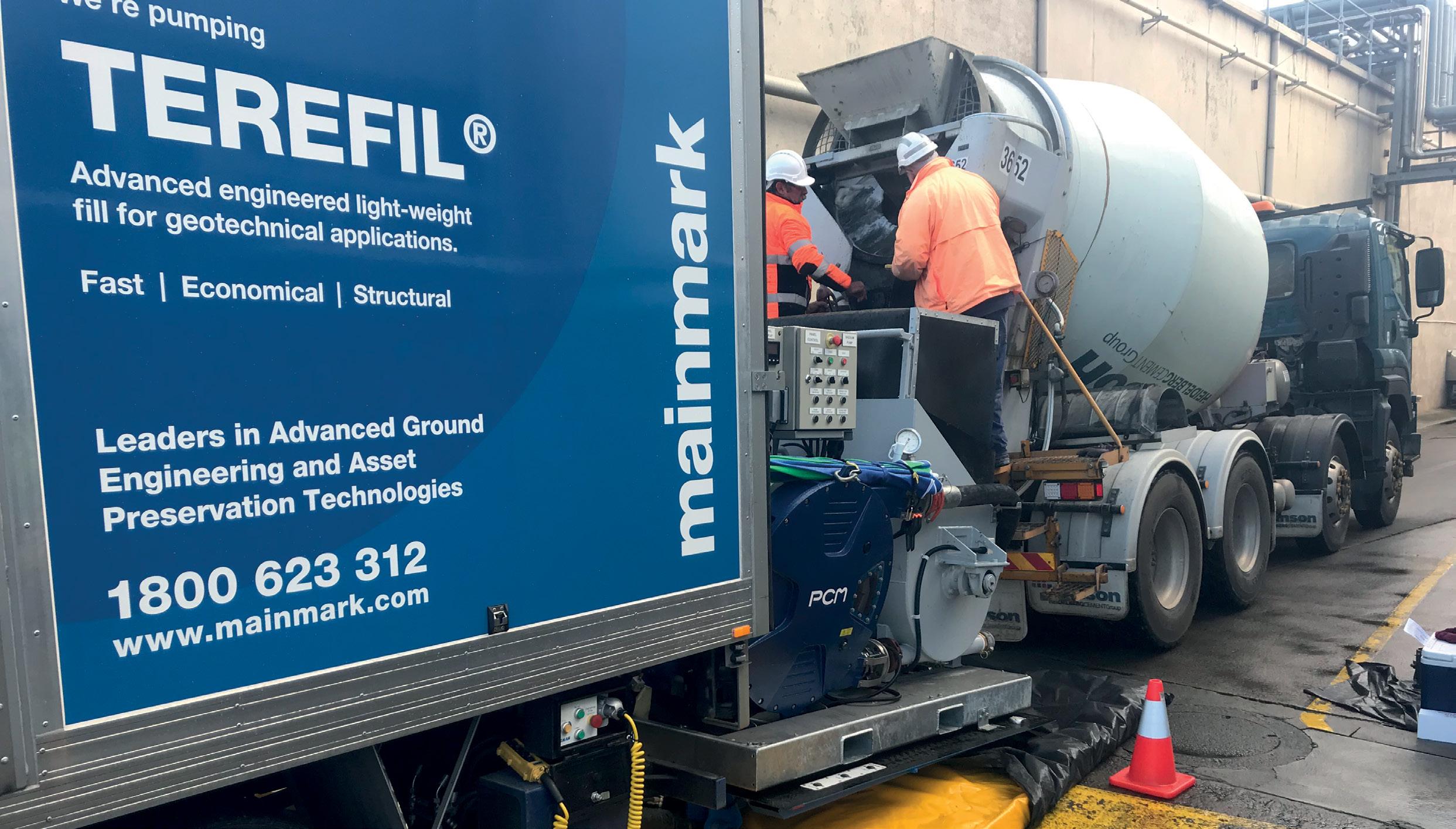
Recently, Mainmark was engaged by a local Council on the New South Wales North Coast to help safely decommission a stormwater pipe.
When the Council was upgrading its aging stormwater network, it found a reinforced concrete pipe running directly underneath a residential property. The Council sought to re-route the stormwater pipe outside the property's perimeter as part of the stormwater upgrade works.
The section of pipe beneath the home was 40m long x 375mm wide. As it was impossible to remove the pipe without demolishing the home, the pipe needed to be filled with a structural fill material before being abandoned to prevent future issues from occurring.
If the underground pipe were to deteriorate and collapse, the soil surrounding the pipe would shift, potentially leading to the formation of underground voids, in turn putting the home’s foundations at risk of subsidence. Mainmark was required to safely decommission the reinforced concrete stormwater pipe with a structurally sound and environmentally inert pipe fill solution.
Mainmark worked closely with the Council to arrange the necessary preliminary requirements, such as securing the pipe end plates and installing breathers and injection fittings before decommissioning.
Mainmark injected Terefil®, a proprietary lightweight cementitious grout, into the section of pipe that was to be abandoned. The grout was mixed to a specific density to ensure the designed mechanical properties were achieved.
Terefil® is a highly flowable cementitious material that can be easily pumped over very long distances, making it an ideal solution for the site. Terefil® contains a uniformly distributed polymer cell structure encapsulated by cementitious materials – creating an engineered, lightweight and strong product that is far more versatile than traditional bulk void fill materials.
• Can solve a wide variety of geotechnical challenges
• Creates a lightweight and strong concrete mix
• Easily pumped over very long distances
• Environmentally inert
• Low carbon footprint
• Less raw materials used, and needing to be transported to site
“The use of Terefil® allowed the Council to complete the pipe abandonment work without the need for expensive excavation or creating any disruption to the homeowner,” Mr Deller said.
“The project was successfully completed in a single day and within the Council’s budget.”
Local governments are also expected to act sustainably when carrying out maintenance or upgrade works by minimising impact on the surrounding environment and meeting wider climate goals.
Mainmark’s void filling, re-levelling and ground improvement solutions are all delivered via Mainmark's custom-built and automated equipment.
“Terefil®, for instance, is environmentally inert and has a low carbon footprint. It requires less raw material to be transported to site, reducing traffic congestion and fuel use,” Mr Deller said.
Leveraging low-impact, more sustainable technologies to repair or maintain infrastructure is one way councils can support a better quality of life in their locality.
Increasing populations will place greater demand on aging infrastructure and ensuring those assets are well maintained should be a high priority for councils.
To find out more go to https://mainmark.com/

With more than 50 years of electrical engineering experience, and as one of the pioneers in the Australian and New Zealand electric vehicle (EV) charging landscape, NHP has developed a range of quality EV charging products to suit the needs of all operations, including council and other government projects and facilities.
As the local transition to EVs accelerates, companies like NHP are leading the way – creating innovative solutions without the charging anxiety.
NHP is partnering with Delta, one of the world’s largest EV charger manufacturers, to bring high quality charging products to Australia and New Zealand.
NHP has further enhanced the Delta range to provide a number of products including charging posts, isolators, RCBOs, EV readiness distribution boards and even its revolutionary Load Management System.
NHP’s team of dedicated EV specialists and engineers will help tailor the right solution for individual projects.
To further support a project, NHP can also provide extended warranties and a bespoke service and maintenance package, which involves NHP’s factory trained technicians checking on the installation to ensure it is operating in tip-top condition.
The Delta range of EV chargers from NHP features Ethernet, Wi-Fi and SIM card connectivity, allowing connection to third-party cloud-based billing platforms via the OCPP 1.6J communications protocol.
Durable, reliable and commercial grade, the Delta DC Wallbox 25kW is one of the best selling, low level DC chargers on the market, while the all new Delta DC Wallbox 50kW will be a game changer in the EV charging space.
One of the thinnest chargers on the market at only 260mm deep, the DC Wallbox 50kW delivers fast charging without large real estate demands.
The range comes with cable lengths from 4m, which is ideal for car parks, while the optional 7m cable length is ideal for councils, utilities, heavy commercial and automotive service centres.
Air-cooled, steel cased and with an IP55/IK10 rating, the Delta DC Wallbox will operate comfortably in most weather and operating conditions and will run at full capacity up to 50°C.
One of the major benefits of the DC Wallbox is the ability to mount to a wall, allowing for cabling to run along the wall, rather than digging trenches. If no wall is available, the DC Wallbox is available with a purpose-built steel pedestal.
Publicly accessible infrastructure needs to be durable, reliable and fit for purpose and the Delta DC City Charger is designed to deliver on these fronts. Built inside a solid steel IP55/IK10 case, the DC City Charger is robust and built for longevity.
Available in three variants (50kW, 100kW and 200kW), the City Charger will deliver rapid and ultra-rapid performance. The City Charger is also applicable for rural areas, and is designed for Australia and New Zealand’s varying environments and weather conditions.
Air-cooling is used for temperature control, making the DC City Charger more reliable and easy to maintain.
NHP has found that councils and local businesses are increasingly seeing the benefits of installing EV chargers for public use.
The more EV drivers become aware that they can stop in a local area on their road trip or while going about their daily business, the more likely they will be to spend time in the area, shop at the local stores and cafes and strengthen the local economy.
Having kept the power on in homes, stadiums, hospitals, factories and many other industries for over 50 years, NHP understands the importance of reliability and up-time. Offering a wide range of service and maintenance products and extended warranties, NHP goes the extra mile to offer greater peace of mind.
To find out more, please contact your local NHP Account Representative, call 1300 647 647 or email nhpsales@nhp.com.au
NHP’s range of Delta EV chargers provides solutions to suit most applications
■ Easy installation

■ Fast and efficient performance
■ Smart connectivity for billing or department restricted access
■ Accessories available including charger posts, charging cables and upstreaming hardware
■ Two-year warranty with extension possible for up to ten years
■ NHP service and maintenance packages available
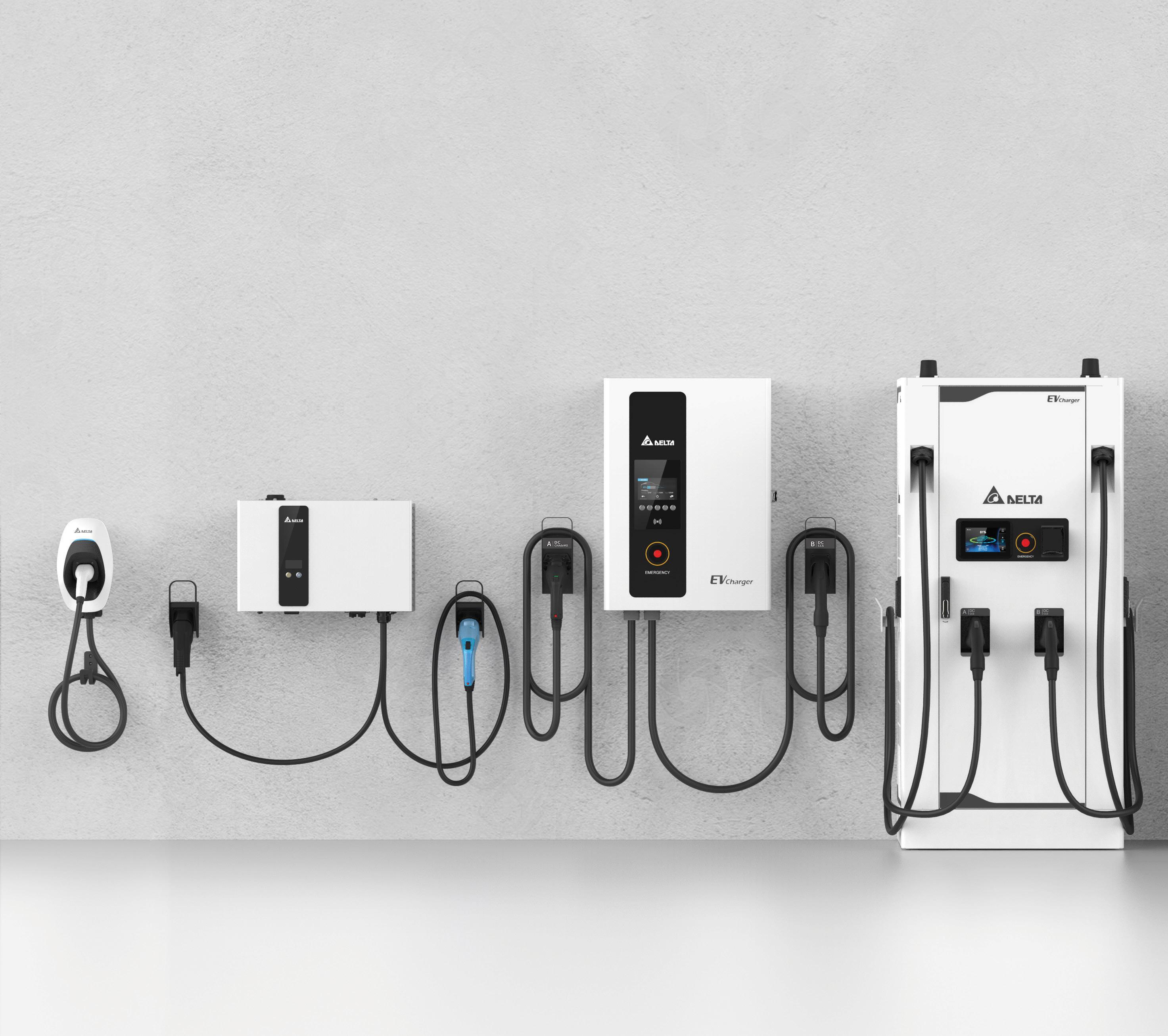
–
–
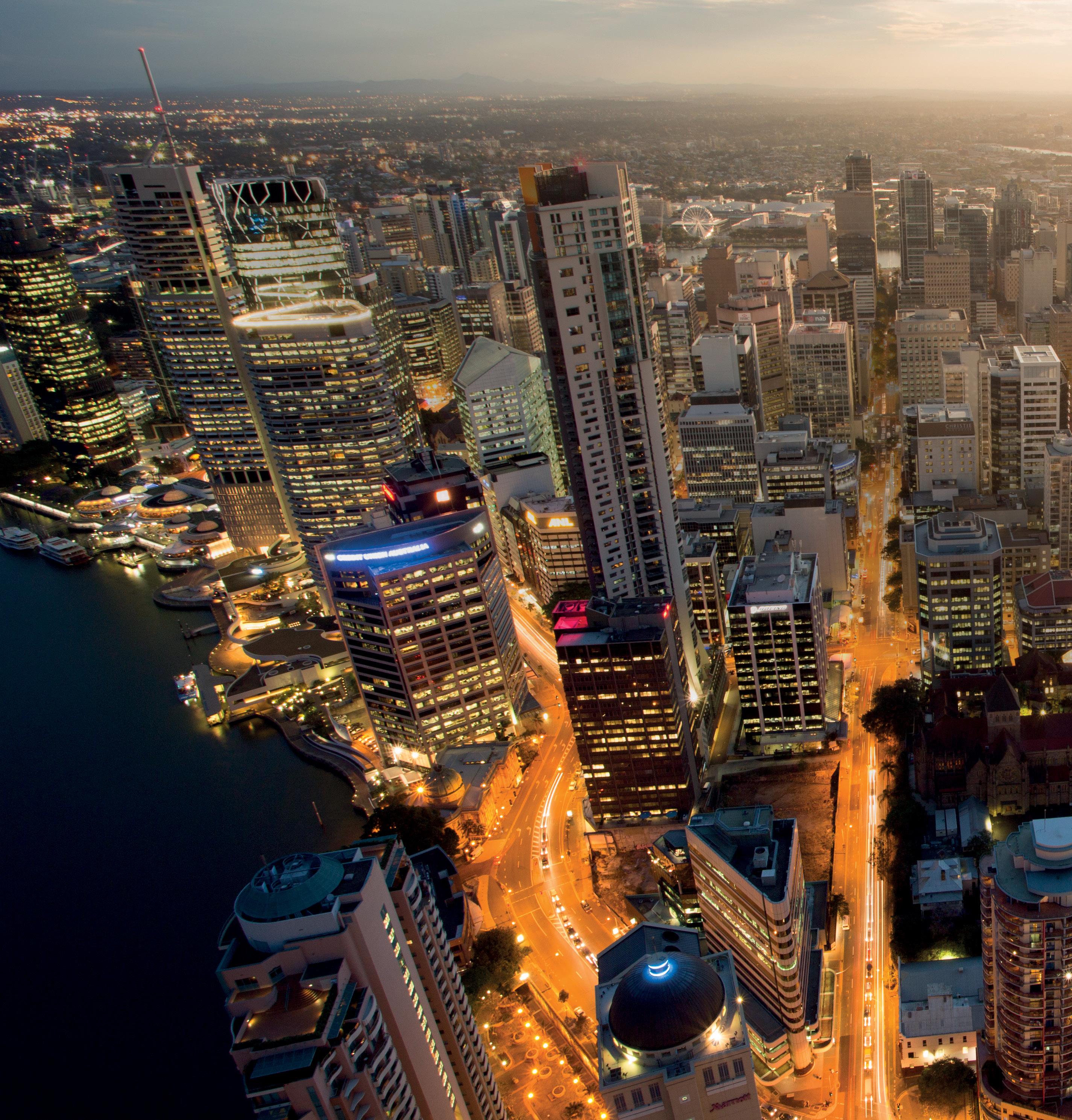
Australia is currently experiencing a record-level rental crisis, attributable to a period of incredibly low vacancy rates and rising rental prices. Many have pointed the finger at the growing number of short-term rentals as a reason behind the lack of available homes, with some councils taking action to deter or restrict their presence, amongst other initiatives to curb the wider crisis.
In recent years, cities across the country have been faced with rising rental prices and low availability of rentals, which has increased housing affordability stress and pushed more Australians into homelessness.
According to research from the Australian Housing and Urban Research Institute (AHURI), the national rental vacancy rate was at 0.9 per cent in September 2022, the lowest since April 2006 (when it was 0.8 per cent for one month). This very low vacancy rate was sustained for most of 2022, a situation unseen in the last 20 years.
The low vacancy rate has pushed up rents and as a result national combined rents for houses and apartments were the highest they have ever been in November 2022, at $542 per week.

There are a variety of factors causing the rental shortage, which have meant, to put it simply, that there are not enough homes available to rent. But what are the reasons behind this and how are councils tackling these issues?
Websites such as Airbnb, Booking.com and Stayz offer property-listers the opportunity for high returns on short-term lets, leading to a removal of properties from the long-term rental market.
The problem has a significant impact on high-demand inner city zones with large amounts of tourism appeal as well as tourism-heavy regional and coastal areas. This has led
to some states and councils taking action to stop or deter property owners from letting on the short-term market.
In some New South Wales local government areas, there are limits on the number of days that a property can be used for short-term rental accommodation. The regulations do not apply if a host is present.
Properties in the following areas are restricted to a maximum of 180 days a year:
∞ Greater Sydney region (not including the Central Coast)
∞ Ballina area
∞ Byron area
∞ Certain land in the Clarence Valley area
∞ Certain land in the Muswellbrook area
However, for one New South Wales council, the 180 day limit has not been enough to address the problem.
With more than two million Australian and international visitors each year, Byron Bay has been significantly impacted by the growth of short-term rentals through websites like Airbnb.
According to data from Inside Airbnb, there are currently 3075 short-term rentals in the Byron Shire area listed on the site. Approximately 87 per cent of those listings are entire homes or apartments.
At the same time, the cost of housing in the Byron Shire has soared in recent years, with growth outpacing other parts of regional New South Wales and Sydney.
With concerns of rising homelessness and rents in the region, Byron Shire Council is taking a strong stance against short-term rentals.
Last year, Council was set to vote on a proposal that would amend planning laws to reduce the number of days properties in certain zones could be rented out for tourism on platforms like Airbnb.
However, the New South Wales Government intervened on the proposal and sought the advice of the State’s Independent Planning Commission (IPC). In April 2023, the IPC published its recommendations, advising that limiting properties to 60 days would provide sufficient incentive for owners to put properties on the long-term rental market.
The decision is now in the hands of the State Government.
Meanwhile, other Australian councils are using different tactics to drive short-term rentals out of their communities.
Brisbane, Australia’s third-most populated city, is also facing a lack of long-term rental vacancies and rising rental prices. As the city gets closer to hosting the 2032 Olympics, the issue of housing affordability in the city is likely to become a greater concern.
Brisbane City Council has responded to the issue by introducing a new rating category, applicable to entire properties that have been offered, available or used as short-term accommodation for more than 60 days a year.
Introduced on 1 July 2022, the Transitory Accommodation rating category requires eligible owners to pay 50 per cent higher
rates than other non-owner occupied homes, meaning the average property is paying about $985 extra per year.
Brisbane Lord Mayor, Adrian Shrinner, said the new measure is aimed at both incentivising owners to return and keep properties on the long-term rental market and ensure those who use them for short-term rentals pay their fair share.
“We’re one of the first councils in Queensland to introduce this reform, however we won’t be the last,” Mayor Shrinner said.
“I would be happy if this new rating category didn’t make a single dollar. Brisbane has plenty of great hotels with many more under construction, and our suburban streets were never meant to be home to mini hotels that house different tenants every week.”
Many of these properties cause complaints from neighbours, resulting in higher compliance costs that must be paid by all Brisbane ratepayers.
“It is my hope that instead of paying extra, many owners will return these houses and apartments to the long-term rental market which will help ease our housing shortage.
“There is no silver bullet solution to housing affordability, but this is one way we can play a part at a local government level.”
More than 700 properties have been identified for this new rating category since it was introduced, but it is uncertain how much the increase is deterring property owners from renting out short-term accommodation.
Tackling Australia’s rental crisis will require more than targeting short-term rentals. Research from ANHURI found that these properties have a significant impact in specific areas, not across major cities as a whole, so what else is causing the problem?
One contributing factor is the significant increase in single person households during the pandemic, with the rate of household formation greater than the increase in new dwellings.

There is no denying that overseas migration also adds pressure on the housing and rental market. However, immigrants play an important role in contributing to Australia’s economy and helping address skills shortages. As Australia faces an aging population and declining fertility rates, overseas migration will be crucial for the country’s future.
Internal migration has also impacted the vacancy rate in rural and regional areas, as 2016 to 2021 saw a significant increase in people moving out of capital cities.
Compounding the problem are the challenges facing the construction industry, including supply chain disruptions, labour shortages and rising interest rates. As a result, a number of home building companies have collapsed, while the rate of new construction has significantly slowed down.
Multiple levels of government will need to work together to understand how the rental crisis is affecting communities and what can be done. One region where this is happening is in Western Queensland. The Queensland Government has partnered with the Western Queensland
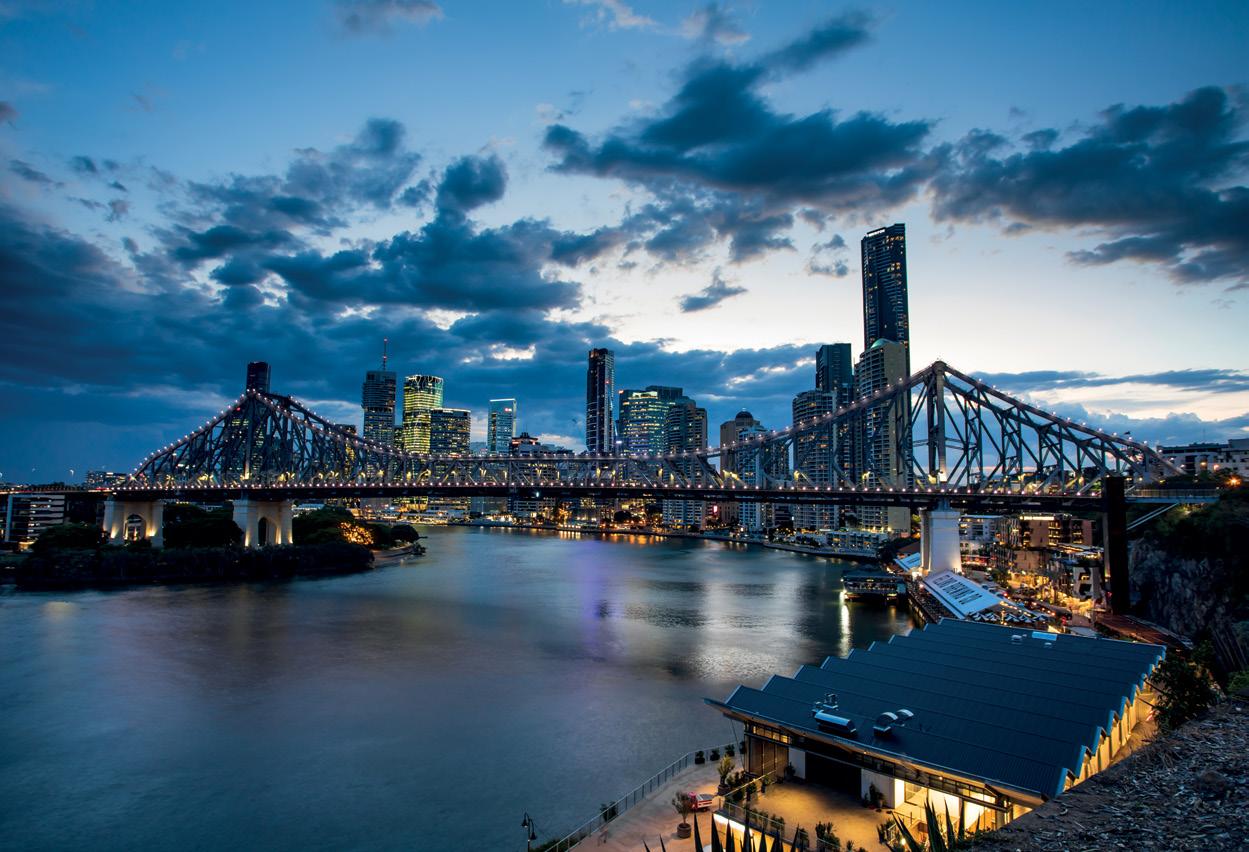
Alliance of Councils (WQAC) to develop Local Housing Action Plans for its 22 Councils.
Local Housing Action Plans are a commitment under the Queensland Housing and Homelessness Action Plan 2021-2025.
The plans are the next step towards addressing housing challenges in rural and remote communities. They will provide an assessment of housing availability, a view of the rental market, social housing, demand for aged care and emergency housing.
The $200,000 initiative is supported by the Department of State Development, Infrastructure, Local Government and Planning, and the Department of Communities and Housing.
In a 2022 statement, Queensland Deputy Premier and Minister for Local Government, Steven Miles, said the plans are an important step towards finding local housing solutions that will meet the individual needs of local communities.
“Affordable and available housing remains an issue in all corners of the state, with our rural and remote communities facing unique challenges,” Mr Miles said.
“These plans will equip councils to better respond to a range of immediate, emerging and longer-term housing challenges.
“The Western Queensland Alliance of Councils has been leading the way with its work in examining the key factors affecting housing in each of these communities.
“This gives local governments a clearer path forward to respond to housing needs and help ensure more Queenslanders have a place to call home.
“We are committed to working with councils to address housing issues and improve the liveability and economic sustainability of communities in Western Queensland.”
All action plans are set to be completed by June 2023. In late 2022, WQAC Leaders welcomed the release of the initial pilot plans.
Carpentaria Shire Council Mayor and Chair of the North West Queensland Regional Organisation of Council, Jack Bawden, said, “Getting Local Housing Action Plans off the ground means we can identify solutions sooner and coordinate
responses to the housing challenges facing rural and remote council areas.”
Mayor of Longreach Shire Council and Chair of the Remote Area Planning and Development Board, Tony Rayner, said, “The 22 councils of Western Queensland all face similar housing shortages and the best way of addressing this problem is by working together.”
The Western Queensland initiative shows how a lack of affordable housing is a major problem across the country that will require coordinated intervention with multiple government bodies.
While much of this will occur at the state and federal levels, some councils are taking unique approaches to address the issue at a local level.
Another way councils can help increase the supply of housing in their communities is by facilitating and encouraging innovative housing solutions.
In 2022, Surf Coast Shire Council announced that it would be conducting a new trial of tiny houses on wheels to address the shortage of affordable housing and worker accommodation.
Tiny houses on wheels currently do not feature in Council’s local law and their temporary use falls between the planning scheme and the camping provisions of the local law.
Considerations around regulation of mobile tiny homes will include wastewater management, building regulations, appropriate locations in consideration of bushfire risk and emergency management, vegetation removal and the impact on neighbourhood amenity.
Council resolved at its December 2022 meeting to support a trial to better understand complex issues surrounding the use of tiny houses on wheels before reaching a formal local law position.
A proposed two-year trial will allow further community consultation, development of criteria and an application, permit and monitoring process – and assessment of impact on Council resources.
Under the trial, which is likely to start this year, people will be able to apply to Surf Coast Shire Council for a permit to temporarily live in a tiny house on private property. Council will not be providing land to potential tiny house on wheel owners and they will need to make their own rental arrangements with land holders.
Ideas such as tiny homes or accessory dwelling units are novel solutions for increasing housing supply and will be dependent on local circumstances. It is just one example of Australian councils taking initiative to implement measures to alleviate the shortage.
There’s no quick fix to Australia’s rental crisis. A concerted effort from all levels of government, including local councils, is required to ensure Australians have access to secure and affordable housing in the years to come. The consequences of inaction will be growing housing affordability stress and larger numbers of Australians facing homelessness.
1. Australian Housing and Urban Research Institute. November 2022. https://www.ahuri.edu.au/research/brief/why-does-australia-have-rental-crisis-and-what-can-bedone-about-it
2. Inside Airbnb. http://insideairbnb.com/northern-rivers/?neighbourhood=BYRON%20SHIRE%20COUNCIL&filterEntireHomes=false&filterHighlyAvailable=false&filter RecentReviews=false&filterMultiListings=false
Managing water has never been more critical for Australian councils, due to droughts, significant rain events and a growing population. Box culverts are rectangular or square-shaped structures – typically made from reinforced concrete – that are used to convey water, stormwater, sewage, or irrigation water from one place to another, and can be a versatile solution for councils looking for an innovative solution to their water woes.
One of the primary benefits of using box culverts is that they can be precast, which means they can be fabricated in a controlled environment and then transported to the construction site. This allows for greater quality control and faster installation times.
Box culverts consist of several precast concrete sections that are assembled on-site to form a single, integrated structure, and they are widely used in a variety of civil engineering projects, such as roads, highways, railways, canals, and drainage systems.
They are also used when conventional drainage systems, such as ditches or pipes, are not feasible or effective due to soil conditions, traffic requirements, or environmental constraints.
1. Stormwater management – culverts are often used in stormwater management systems to help direct and control the flow of water during heavy rain events, they can be used to channel water under roadways, bridges, and other structures
2. Water crossings – culverts are used in stream crossings to allow water to flow under roads and other infrastructure while still allowing vehicular traffic to pass above, they are often used in areas with too steep terrain for a traditional bridge
3. Sewer systems –culverts are used in sewer systems to carry wastewater and sewage from one location to another, they are particularly useful in areas with high groundwater or where deep excavations are required
4. Pedestrian underpasses – culverts can also be used to create pedestrian underpasses beneath roads and highways, providing safe and easy access for pedestrians and cyclists
5. Utility tunnels – culverts can be used as utility tunnels to house underground utilities like electrical cables, fibre optic cables, and water pipes
Box culverts come in different sizes and shapes, depending on the application and the required hydraulic capacity.
Box culverts have several advantages over other drainage structures, such as their strength, durability, and ease of installation. They can withstand heavy loads and severe weather conditions, resist corrosion and erosion, and require minimal maintenance.
They can also be manufactured and transported to the site in a timely and cost-effective manner, reducing construction time and costs.
In summary, box culverts are essential components of many civil engineering projects, providing a safe and efficient means of conveying water and other fluids while minimising environmental impact and maximising project efficiency.
Civilcast is a market leader in the manufacture and supply of civil infrastructure products, and custom manufactures a range of precast box culverts.
Need more information?
Call Civilcast on 1300 012 278 to discuss your specific requirements with their in-house Engineering & Design Team. Alternatively, visit civilcast.com.au for more information.





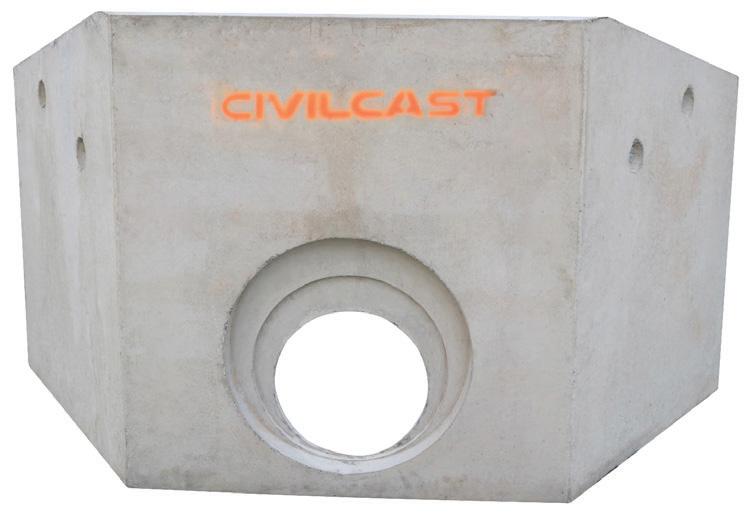


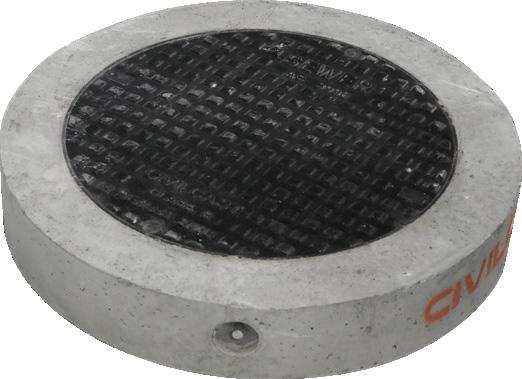

Spiral wound lining is a sustainable method of pipe maintenance, allowing water authorities and councils to renew their critical infrastructure. Interflow is an expert in this field and has been pioneering new techniques for decades.
Spiral wound lining is a trenchless technology that uses a continuous plastic strip to form liners in gravity pipelines.
This unique rehabilitation method originated in Australia and Japan during the 1980s and has been used on millions of metres of pipe across the globe. Like CIPP or slip lining, spiral wound liners provide a structural lining solution for fully deteriorated pipelines with minimal site disruption.
When it comes to Australia, spiral wound pipe technology is the most used product in the pipe renewal market. Interflow has become synonymous with the technology, having installed more than 95 per cent of all spiral wound liners across the country.
Expanda was developed in Australia by Rib Loc, Interflow’s technology partner, and released worldwide in 1990. It produces a PVC liner in intimate contact with the host pipe. To date, Interflow has lined over 1.5 million metres of pipe with the product.
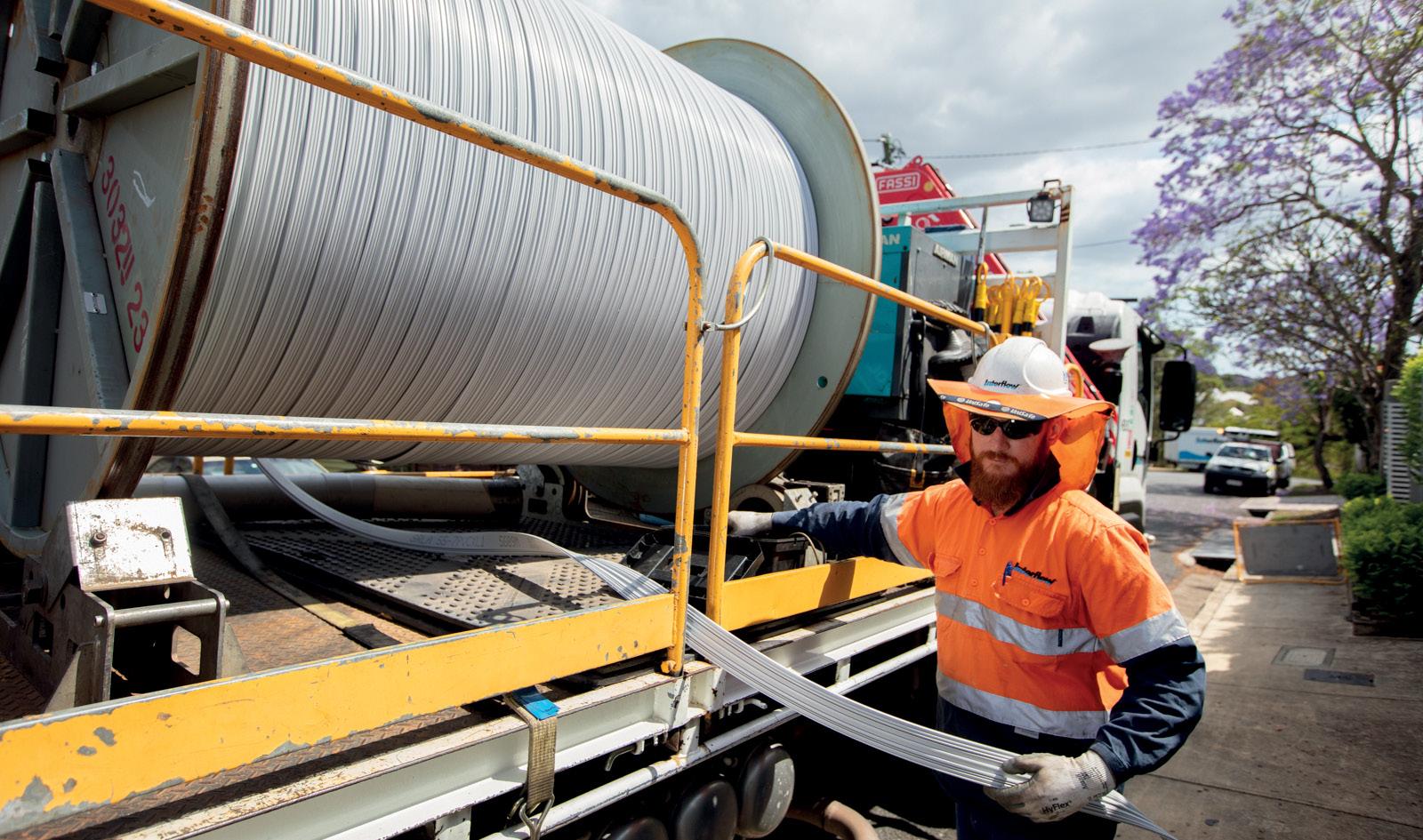
Rotaloc is a Rib Loc development for larger pipes and has been used to renew sewer and stormwater pipelines and culverts worldwide. It is installed by winding a continuous strip of interlocked PVC using a custom winding machine that can adjust the diameter of the liner as it moves along the pipeline.
Why have spiral wound pipes become so successful? What are the main benefits to the installer and client?
First, spiral wound lining is made from a ribbed structure, giving it a high strength-to-weight ratio. That means less material is needed, making it a cost-effective and sustainable solution.
Such strength saw the Victorian Department of Transport introduce steel reinforced Rotaloc for rehabilitating three road culverts under the Monash Freeway. Rotaloc was strong enough to rehabilitate the three culverts without relying on the integrity of the host pipe.
Spiral wound lining installations also tend to have small site footprints and minimise disruptions to residents.
Liners can be installed while liquids flow through pipes without bypassing the flow.
By locking strips of lining together, the installation process is entirely mechanical. There is no need for any curing or heating to prepare the lining for the pipe.
This was a suitable solution in Paraburdoo in remote Western Australia, where Interflow installed more than 2km of sewers with Expanda spiral wound liners.
Over the past 25 years, advances in technology have extended spiral wound linings’ capabilities to larger sizes and greater load-carrying capacities. It can be utilised in applications where rehabilitation by lining would otherwise have been impossible.
Investment is being made in further research and development. These results should see the possibilities extend further for trenchless structural pipeline rehabilitation.




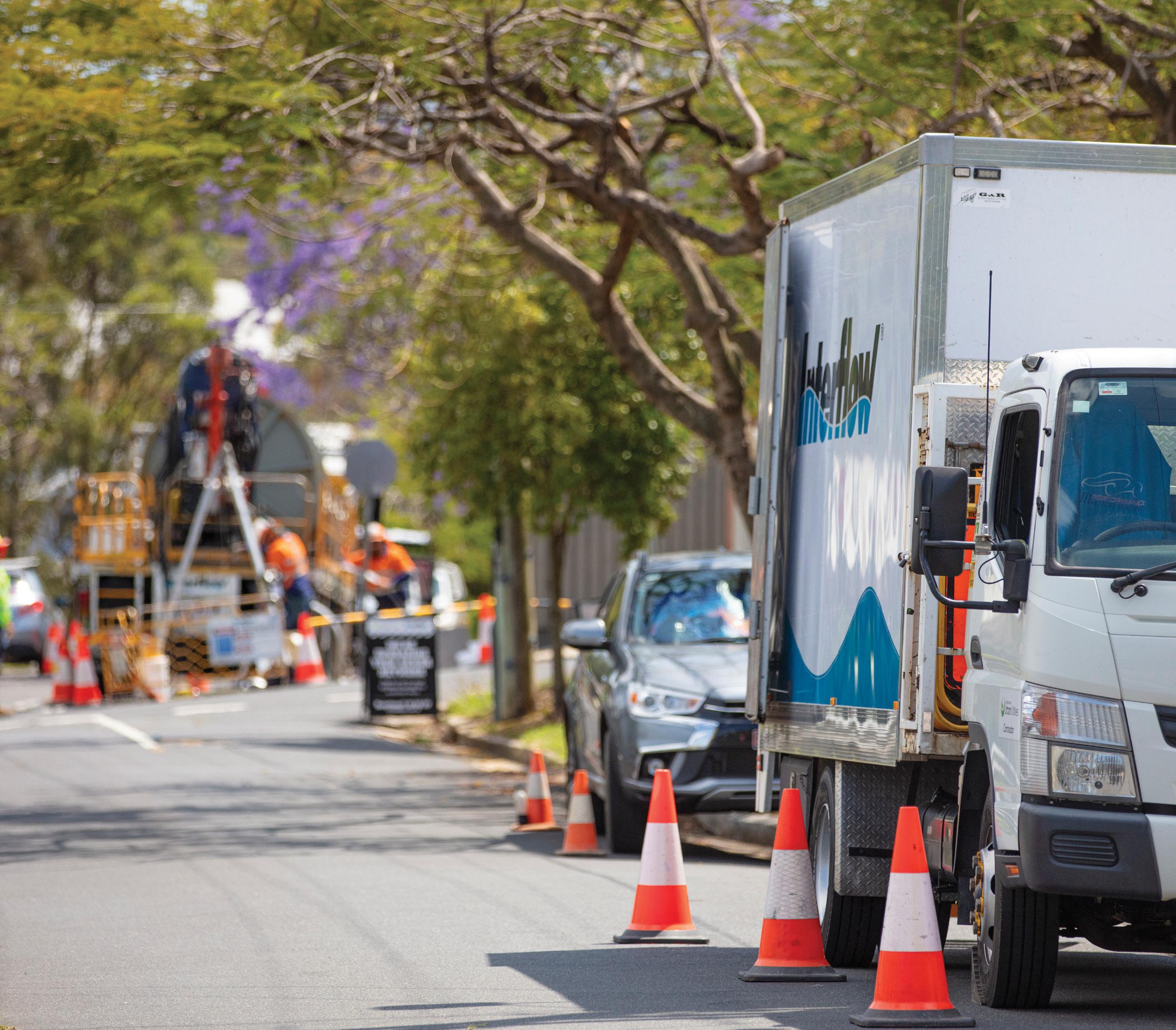



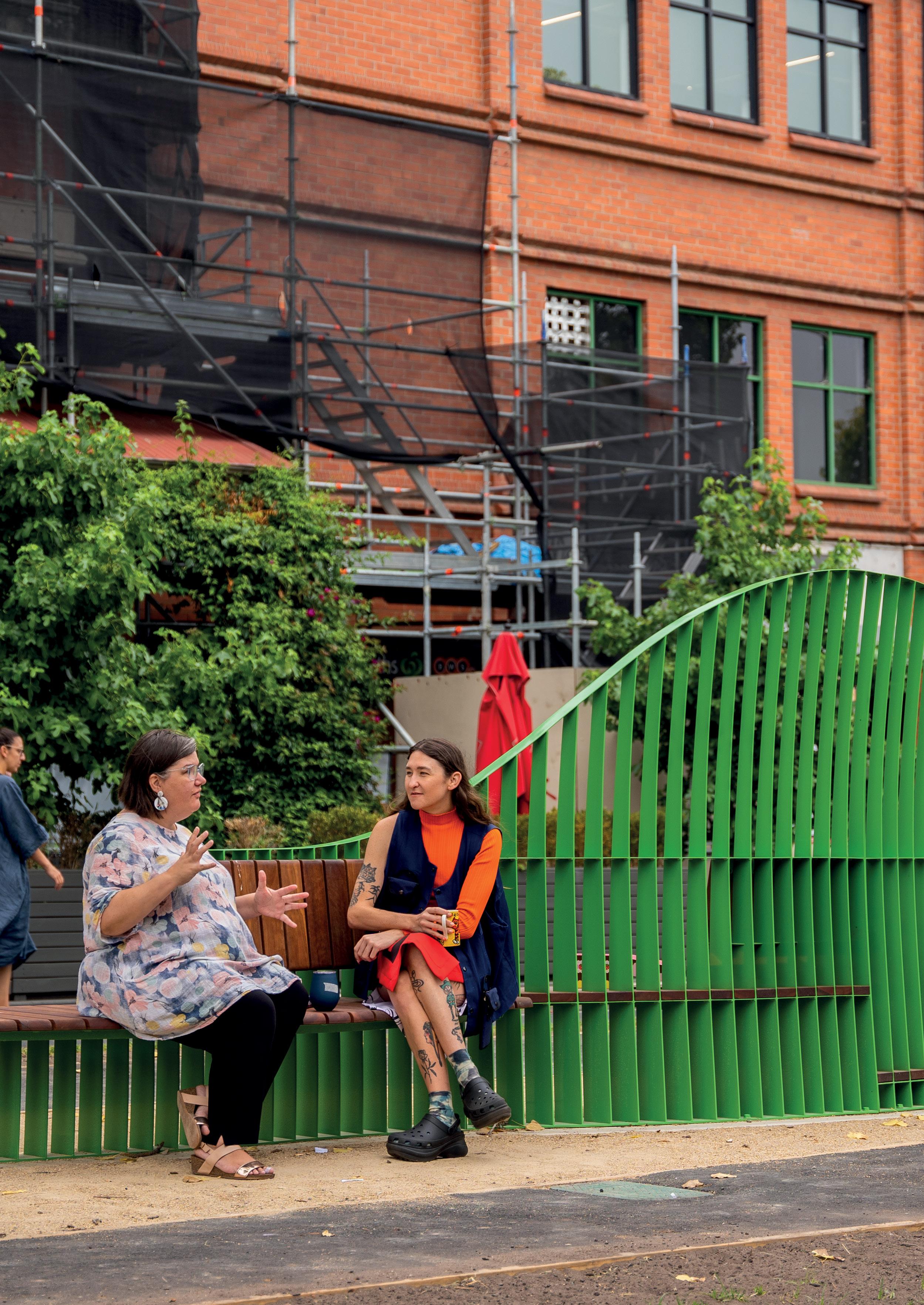
This Melbourne chair is collecting data to discover how people in the city use public spaces. By combining data and design, City of Melbourne is learning what improvements can be made to ensure these spaces continue to meet the needs of the community.
The City of Melbourne installed the data collecting Social Spaces chair on a median strip one block from Melbourne’s famous Lygon St shopping and dining district. The pilot project uses sensor data and insights to explore how public spaces can meet the needs and improve the experiences of the people who live, work, and visit the area.
A collaboration between City of Melbourne, Inhabit Place, Spark Furniture, Altometer and Rowlands Metalworks, the project brings together a multi-disciplinary team to enable the council to trial data-informed designs.
The goal of this pilot is to help understand:
∞ Whether people are using their neighbourhoods differently post pandemic
∞ How public spaces can adapt to accommodate the new needs of communities, such as making people feel safer and more socially connected
∞ How public spaces can promote social activities
∞ Whether public spaces currently reflect the local culture and diverse living situations
∞ Why some public spaces are better utilised and not others
∞ What makes urban furniture (such as seating in parks) successful and how that looks
The site at 313 Drummond Street, Carlton, was selected based on the level of pedestrian activity, opportunities for improvement (through qualitative data and observational audits), existing social activity, mobile phone and pedestrian sensor data and the opportunity that the narrow site presented (and applicability in other City of Melbourne locations). The design is made from natural timber with powder-coated green steel. There are two spots to sit, a small ‘stage’ and a leaning bench. Extra factors considered in the furniture design included: surrounding transport behaviours and the potential for positive impact, existing furniture and amenities, perceptions of safety and macroopportunities such as if the site was a thoroughfare between significant hubs.
The sensors installed are Digital Matter Yabby Edge and VivaCity Artificial Intelligence Road Survey sensor (AIRS).
A Yabby sensor, an accelerometer that senses movement, has also been installed on a nearby metal bench and is collecting comparative data.
This data allows us to understand how the use of the existing bench compares with the new Social Spaces design. These sensors are also used in other City of Melbourne projects: Argyle Square, Royal Park and at Micro-Labs.
Data collected using the AIRS sensor shows the flow of people around the chair, peaks and troughs in activity, transport modes and, most importantly, dwell time at different locations on the chair.
For instance, it will help to reveal behaviours of use that could inform the design of other spaces. This type of sensor is also installed at Melbourne’s Southbank Promenade to learn more about the different modes of transport used in this busy city thoroughfare.
Detailed information on use has been collected through observational audits in May and June as well as an ongoing community survey on the project webpage.
A real time online dashboard presents data collected from 1 February 2023 and shows user trends at both the Social Spaces design and the existing metal bench.
Data shows the new design has been used almost six times more than the original bench: approximately 4,000 times compared to 700. The new chair is being used on average 43 times per day with 1pm the busiest time and Saturday the busiest day.
By contrast, the original bench is used on average eight times a day with 11am its busiest time and Monday the busiest day.
Data also revealed the high bench for leaning, accounts for 60 per cent of all usage of the chair.
A real time data dashboard allows the community to see insights and ask questions about the data. The dashboard is shared on the project website (see link below) – hover your
cursor over different parts of the dashboard for more information.
This pilot has already provided City of Melbourne with valuable insights and reflections that will inform future projects.
Benefits of this pilot include:
∞ Testing different types of data and how they might inform design (for instance observational audits, mobile phone data, sensor data)
∞ Trialling different kinds of sensors to enable the right kind of insights (not one sensor fits all!)
∞ Exploring community engagement models and collecting community input to inform future projects
∞ Testing new typologies in the public realm that are relevant in other narrow sites like laneways
∞ Demonstrating impact of industry collaboration and multi-disciplinary collaboration within the organisation
∞ Elevating digital literacy in the community and demonstrating a commitment to transparency
∞ A blueprint for future pilots –iterative, collaborative, supported by data before and after an intervention
Implementing a design that responds directly to local user needs can add significant value to a community space. This pilot demonstrates a commitment to data-led design by being a tangible example of what can be achieved through open conversations between community and government.
Importantly, it can be a positive conduit to developing greater trust between community and government by increasing digital literacy through a better understanding of the role of technology and data in designing public spaces that improve people’s lives.
The Social Spaces Chair has become a local talking point with City of Melbourne Lord Mayor and resident, Sally Capp, observing the bench evolve from local curiosity to furniture, telling The Age; “I thought: ‘A seat is a seat is a seat’ but this has really proven that good design can exponentially increase the way that community infrastructure is used”.
With a spate of violent crime across Australia from the onset of 2023, it is more important than ever for local governments and authorities to take proactive measures to keep crime rates down.
After the COVID-19 pandemic, businesses and activities are returning to normal, and unfortunately, this also includes criminal activity. Dealing with the consequences of crime in communities can cost local governments millions of dollars and leave communities feeling unprotected.
One way to deter criminals is to set up surveillance systems to monitor public spaces and secured sites, but traditional systems can only do so much. Instead of just recording a crime as it happens, active surveillance can deter criminals from entering a restricted area, dumping waste or damaging property.
In 2021-22, there was a three per cent increase in offenders prosecuted by police in Australia, according to the Australian Bureau of Statistics (ABS). Despite this, in most states across Australia, there was an overall decrease in crime in 2021-22. Even prior to the COVID-19 pandemic, crime rates had been steadily decreasing every year.
However, break-ins at home and unlawful entry into commercial premises have been increasing over the past few years. According to the ABS, two per cent of Australian households were broken into in 2021-22 – that equates to 194,100 homes.
For certain states, unlawful entries are even exceeding levels prior to 2020. In Queensland, there has been a 13.67 per cent increase in unlawful entry and a 4.85 per cent increase in property damage between 2019 and 2022. Similarly, in the Northern Territory, crimes against property have increased by 20.51 per cent and property damage increased by 29.27 per cent in the last year.
To reverse these increasing crime rates, local governments and authorities must turn to advanced technology to help prevent theft and property damage. Setting up camera systems may deter some criminals from trying, but only
autonomous surveillance systems with active deterrence can actively respond to threats to prevent crime.
Traditional surveillance cameras can record offences taking place and that footage can be later used to prosecute offenders, but this retroactive response does little to prevent crime in the first place.
Unlike traditional systems, Spectur surveillance systems combine multiple cameras with artificial intelligence (AI) and cloud computing to offer autonomous surveillance.
Spectur autonomous surveillance systems can sense, think and act to prevent crime with cameras, sensors, AI and cloud computing working in tandem. Spectur cameras can detect movement, focus on limited areas, and operate on a schedule, all of which helps to distinguish between real threats and false alarms.
Designed for deterrence, Spectur systems can prevent unlawful entry and property damage before a potential offender has the chance to break in or scale the fence.
If a threat is detected by the system, Spectur platforms can respond in real-time to prevent offenders from breaking in or causing damage. With the assistance of AI and sensors, Spectur systems can make decisions and take action – creating a “digital fence” to stop potential intruders.
When a threat is detected, Spectur systems can respond in a variety of ways. To deter potential criminals, Spectur systems can broadcast a prerecorded message, sound an alarm, call for security guards, flash warning lights and alert asset owners immediately. On many occasions, this has been proven to make a criminal stop before committing a crime.

Spectur systems can also recognise number plates to restrict access to a site for any vehicle that is not permitted to enter, which can also be used later to identify vehicles in case criminals manage to break in.
For local governments, surveillance can help keep communities safe and protect public spaces and infrastructure from damage. Spectur systems offer technology for local governments and authorities to monitor public spaces and deter crime.
According to the Australian Institute of Criminology (AIC), the total cost of crime in Australia during 2020-21 was between $24.8 billion and $60.1 billion. For the public sector, preventing crime can not only keep communities safe, but also help save money replacing stolen goods or repairing damaged property, which can then be used on much-needed community programs and infrastructure.
Turning to autonomous surveillance could make the difference between rising and falling crime rates in many communities. With Spectur surveillance systems, local governments can keep their communities safe and keep crime rates down for years to come.
For more information on using Spectur’s smart solutions for preventing crime, call 1300 802 960 to talk to our team and find the right solution for your unique onsite challenges.
1. Australian Bureau of Statistics. “Recorded Crime - Offenders 2021-22”. 9 February 2023. https:// www.abs.gov.au/statistics/people/crime-andjustice/recorded-crime-offenders/latest-release
2. Australian Bureau of Statistics. “Crime Victimisation, Australia 2021-22”. 22 February 2023. https://www.abs.gov.au/statistics/ people/crime-and-justice/crime-victimisationaustralia/2021-22
3. Queensland Police. “Queensland Crime Statistics”. Updated 2023. https://mypolice.qld.gov.au/ queensland-crime-statistics/
4. Northern Territory Police Force. “Northern Territory Crime Statistics”. Updated February 2023. https:// www.pfes.nt.gov.au/police/community-safety/ nt-crime-statistics
5. Australian Institute of Criminology. Estimating the costs of serious and organised crime in Australia, 2020–21. 2022. https://www.aic.gov.au/sites/ default/files/2022-04/sr38_estimating_the_costs_ of_serious_and_organised_crime_v2.pdf





For remote communities, it’s hard to secure a reliable network connection with limited infrastructure. The extreme costs of setting up network connectivity means many remote councils are unable to monitor sites and implement public services. As a result, issues are often dealt with retroactively or not detected at all, councils and communities are left isolated and disconnected.
When planning and building new towns, this lack of data and communication means networks cannot adapt to the changing needs of projects – with spikes in bandwidth activity or when the demand for connectivity drops with seasonal work. Without scalability, local governments cannot be sure of the final costs for setting up temporary or permanent network infrastructure.
However, a secure and reliable connection isn’t impossible – with leading satellite technology, remote construction projects can have scalable and cost-effective connectivity.
Satellite technology offers remote areas connectivity where cabled services don't exist. When local governments are planning works or upgrading infrastructure, these projects require a scalable connection, as every region, department and project is different.
Orion Satellite Systems is a division of IPSTAR Australia, which provides internet connectivity for rural and regional Australia communities. As a leading satellite provider in Australia, Orion delivers the latest technologies and products with its team.
Orion offers a plethora of long and short term efficient solutions, such
as rental kits available for sameday dispatch for last minute, and emergency needs.
These solutions combine fibre, wireless and satellite technology, which all provide seamless connectivity. Via satellite, users can access phone, data transfer and general internet services, whether it’s sending key project information or communicating with partners and stakeholders.
For almost 20 years, Orion has provided connectivity for local governments, agencies and businesses across all parts of Australia, regardless of location. Orion is one of the only two operators that own their satellites, which means Orion takes care of everything from start to finish, from installation to support.
Non-scalable solutions will fail in remote locations as demand fluctuates, growing with development or falling during seasonal periods of construction work, causing outages which leave critical projects in the dark.
Additionally, Orion’s support team ensures local governments have assistance and regular communication throughout the process. From the beginning, Orion’s team works with clients to identify the right solution to suit their unique requirements and sets up an enhanced connection to keep remote communities growing.
Satellite technology is developing quickly, with the sector taking advantage of new low earth orbit (LEO) satellite constellations. As the name suggests, LEO satellites are located far closer to the Earth than other Geostationary (GEO) satellites, and constellations of these satellites can continuously orbit the planet, unlike fixed GEO satellites.
LEO satellites have the capability to provide minimal data transfer delays, near real-time voice communications, tracking and much more, connecting more people, businesses and communities than ever before.
This emerging technology has the potential to serve regional and rural local governments that have slow or no connectivity. For temporary sites or remote locations, Orion's satellite technologies offer connectivity that would otherwise not be available.
With Orion Satellite Systems, your local government is in safe hands, no matter the location.
This is a sponsored editorial brought to you by Orion Satellite Systems. To find out more about how satellite technology can assist local governments, go to https://orionsat.com.au/.



Councils around Australia are striving to develop more liveable cities through the integration of smart technologies to assist residents and council staff. For libraries, digital solutions are helping improve accessibility and community engagement by making sure all citizens can access valuable services and information.
Libraries play an important role in communities. They can be places to borrow items in a wide range of formats, study, get personalised tech help, listen to knowledgeable speakers, hear from local authors and learn new skills and connect with others – all of which is free for library members.
Building smart cities is about more than adopting new technology. It’s also important to make community centres such as library services more accessible and relevant for all residents.
Digital solutions can help to keep communities engaged with Council library services, with learning resources and online services available for residents no matter where they are.
In the digital age, libraries offer a range of online services. For people who are too busy during the week or cannot attend libraries due to disability or health, online services are ways for residents to utilise libraries without needing to leave their homes.
Many councils are introducing apps to help residents access library services with ease. These free-to-use apps often feature borrowing services, ebooks, digital magazines, learning resources and other information.
With over 1,600 libraries across Australia, these community facilities provide many services and resources in their physical locations, but for residents that cannot access physical branches, digital platforms are a welcome addition.

In particular, ebooks offer people with a disability or learning differences the option to read a variety of content, with customisable font settings and audio options available.
Digital libraries also offer training courses for skills development, including digital literacy for people of different ages and language backgrounds.
For one council in particular, setting up a digital library has helped ensure its library service is keeping up with the needs of its diverse community.
Logan City Council, in South East Queensland, operates nine libraries in its local government area, with more than one million people using the city’s library services yearly.
Determined to find new ways to engage the community, Council launched a free library app to ensure more people could take advantage of library resources, programs and services. Partnering with a digital solutions provider, Council launched the Logan Libraries App.
A free library membership is necessary to set up the app, but once it has been activated, there is no need for a resident to use their library membership card as there is a My Barcode feature, meaning users can manage their account, loans, and more through their devices instead.
Logan City’s free app provides access to half a million items from the library collections, which can all be accessed by residents on their smartphones or tablets.
Residents can borrow and reserve items, book a free library computer, submit print jobs or find details about local library events. Users can even scan a book’s ISBN to check if it’s available in the Logan Libraries collection and reserve it on the spot.
For families, library accounts can be linked together to see when everyone’s items are due or when reserved items are ready for collection.
The easy-to-use app provides library members with resources and services at their fingertips, offering a new way to engage with libraries in this digital age.
Since it went live in April 2023, the community has responded favourably to the Logan Libraries app with a continuous uptake in downloads.
A Logan City Council spokesperson said, “In today’s digital world, the app helps libraries be more responsive to community needs as people spend more time on their mobile devices.
“The app is a convenient, time-saving way for people on the go to interact with their library via their smartphones or tablets and to instantly do the things they like to do such as borrowing items, booking a free library computer, submitting a print job or getting details about free Logan Libraries’ events and activities.
The Council spokesperson said new features will be added to the app as they become available.
“For example, book lovers or families wishing to encourage a love of reading with their young ones will soon be able to use a reading tracker. The tracker allows personal reading targets to be set and will let users know how long they read each day and how many books they started and finished reading.”
As Logan’s libraries continue to expand their physical collections, so too will their digital collections and resources grow, making life more convenient and knowledge more accessible for all residents.
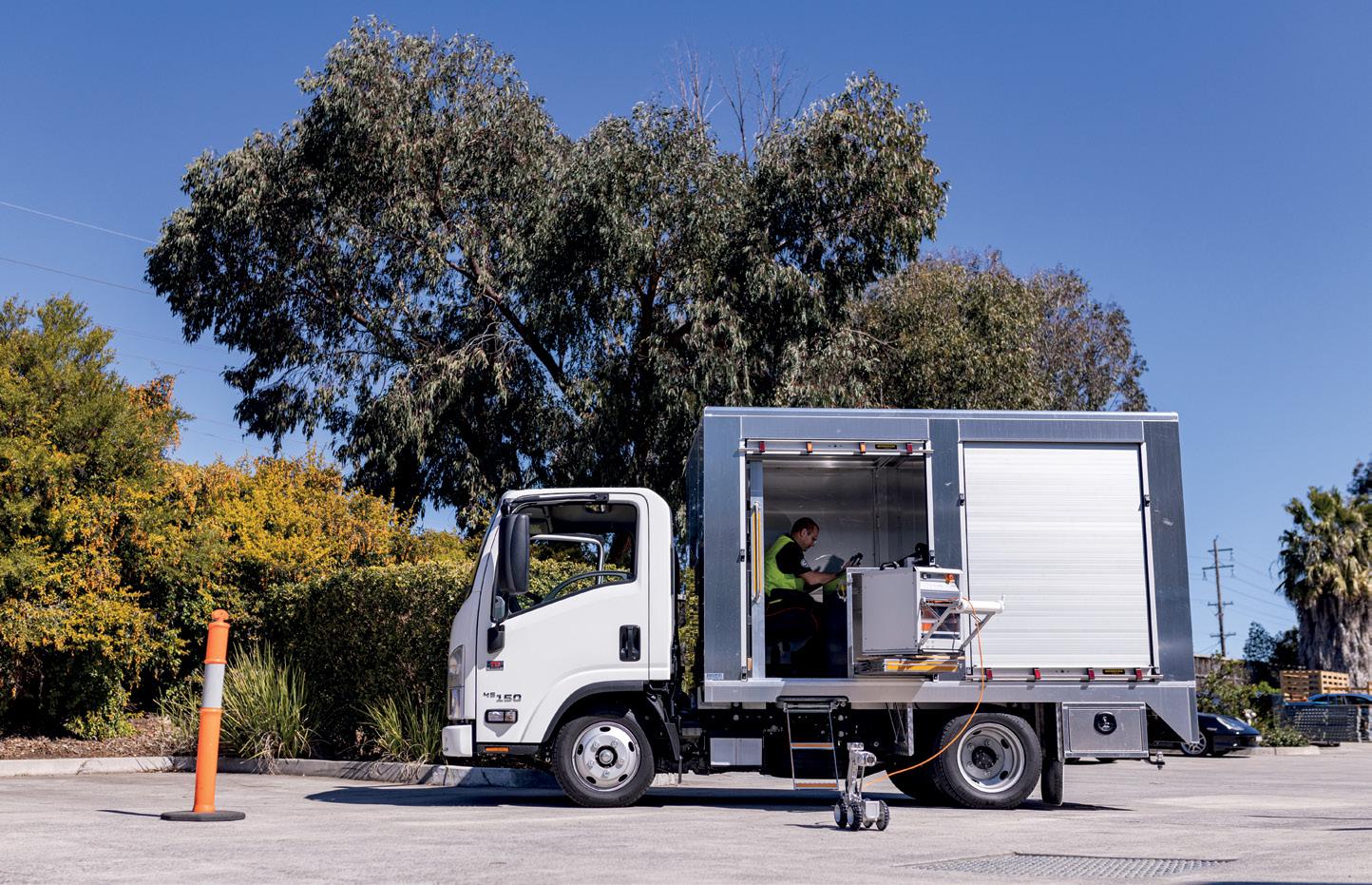
There’s no one size fits all when it comes to pipe inspection cameras, which means it’s vital for councils to know where to start when it comes to selecting the correct equipment and protecting critical pipeline assets.
Using cameras to inspect pipelines, carry out repairs, or for cleaning, is crucial for maintaining council water and wastewater assets, but as each camera is designed to suit certain pipe sizes and manhole depths it can be difficult to know which is best for each individual job.
For local governments, knowing what camera is required for routine maintenance and pipeline repairs will prevent oversights or unnecessary expenses caused by using the wrong equipment.
As Australia’s leading supplier of pipe camera technology, SECA offers a comprehensive range of CCTV inspection equipment for a variety of applications.
Push cameras are flexible push rod cameras that allow for easy manoeuvring through drains and pipes.
SECA’s push camera range includes the Miniflex and AGLIOS™ systems.
The Miniflex sewer camera has a bullet-shaped camera head and flexible element, perfectly suited for curving around right-angle bends. With its flexibility and clear image capturing, the Miniflex camera is suitable for small budgets and smaller pipes, from 32mm to at least 80mm.
Similarly, the AGILIOS™ system consists of a coiler and a flexible but reinforced push rod, with two multifunctional control panels and two types of camera heads. With a
combination of robust push rod and high mobility around bends, it is a highly flexible camera system.
This system is also ideal for small budgets and smaller pipes, 50mm to 250mm in size and 60m to 100m in length.
Crawler camera systems are inspection robots that can be remotelycontrolled to move through pipes, with a live-feed sent to a computer monitor.
From SECA’s range, the ROVION pipeline inspection system is a scalable and highly robust crawler camera. With a wide selection of inspection cameras, including axial cameras, pan and tilt head cameras, fisheye lens and rotating shaft inspection cameras, this system has a considerable range of possible applications.
The ROVION system is suitable for large budgets and medium to larger pipes, from 95mm to 2000mm in size and 200m to 500m in length.
Manhole cameras are specifically designed to go down manholes to get a clearer view of pipe channels without using regular cameras, which can be cumbersome in a tight space.
SECA’s manhole camera range includes the system and the Quickview airHD.
The Quickview airHD is a zoom survey camera with HD video to capture and assess pipelines. Once lowered into the manhole, the camera can be manually aligned and angled
over a 40 degree range using simple touchscreen controls.
This makes it perfect for medium budgets and larger pipes, from 225mm to 2000mm in size and up to 120m in length.
Nozzle video cameras have a cleaning nozzle head attached to the camera, to allow for simultaneous cleaning and inspecting.
From SECA’s range are the JetCam 40 and the JetScan.
The JetCam 40 provides cleaning and inspection capabilities, with a camera nozzle that can be curved around bending pipes to clear blockages.
Additionally, the JetScan has a video camera that can quickly capture near real-time HD footage and can be attached to any jetter above 60LPM. These cameras are perfect for small budgets and medium pipes, from 150mm to 1,000mm in size.
SECA also provides a turnkey solution for inspection vehicles, with customised CCTV vehicle builds that are tailored to suit individual requirements, such as vehicle size, system configuration, load capacities, storage requirements and more.
Whether a camera needs to be put down a manhole or bend around a curved pipe, SECA’s range has a camera for every situation.
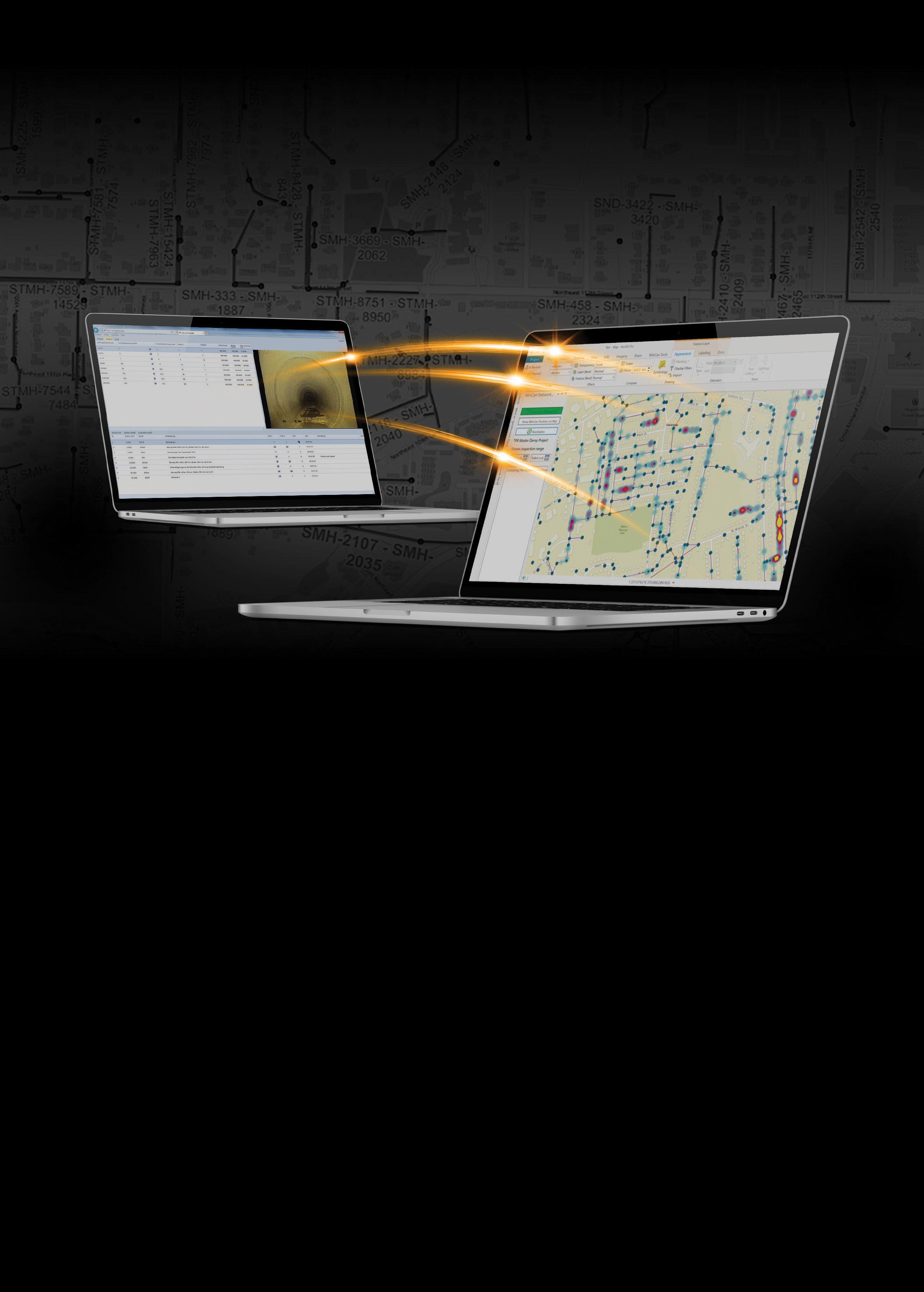
As we drive towards a sustainable future, it's important to consider what's next. Is it cuttingedge technology, smart transport initiatives, or simply going green through electrification? Whatever the answer, the bottom line is to adapt, evolve and, most importantly, innovate.
With the push towards a more sustainable and eco-friendly society, many cities and towns are looking for ways to encourage electric vehicles (EV) in their community and to do their bit towards reducing their community's carbon emissions.
Some ways a council can reduce its carbon footprint include installing solar and battery storage on community buildings, rolling out electric fleets for council vehicles or installing public EV charging stations.
Council leadership can also play a big part in encouraging the public, homeowners and business owners to get on board by providing education on solar and energy storage, electrification, and electric vehicle technology – and providing or promoting incentives to support this take-up.
However, the solution isn't limited to shifting people to buying EV, there must be adequate infrastructure in place to support them.
This includes encouraging people to install an EV charger in their home and supporting local businesses to install public charging stations, whether AC
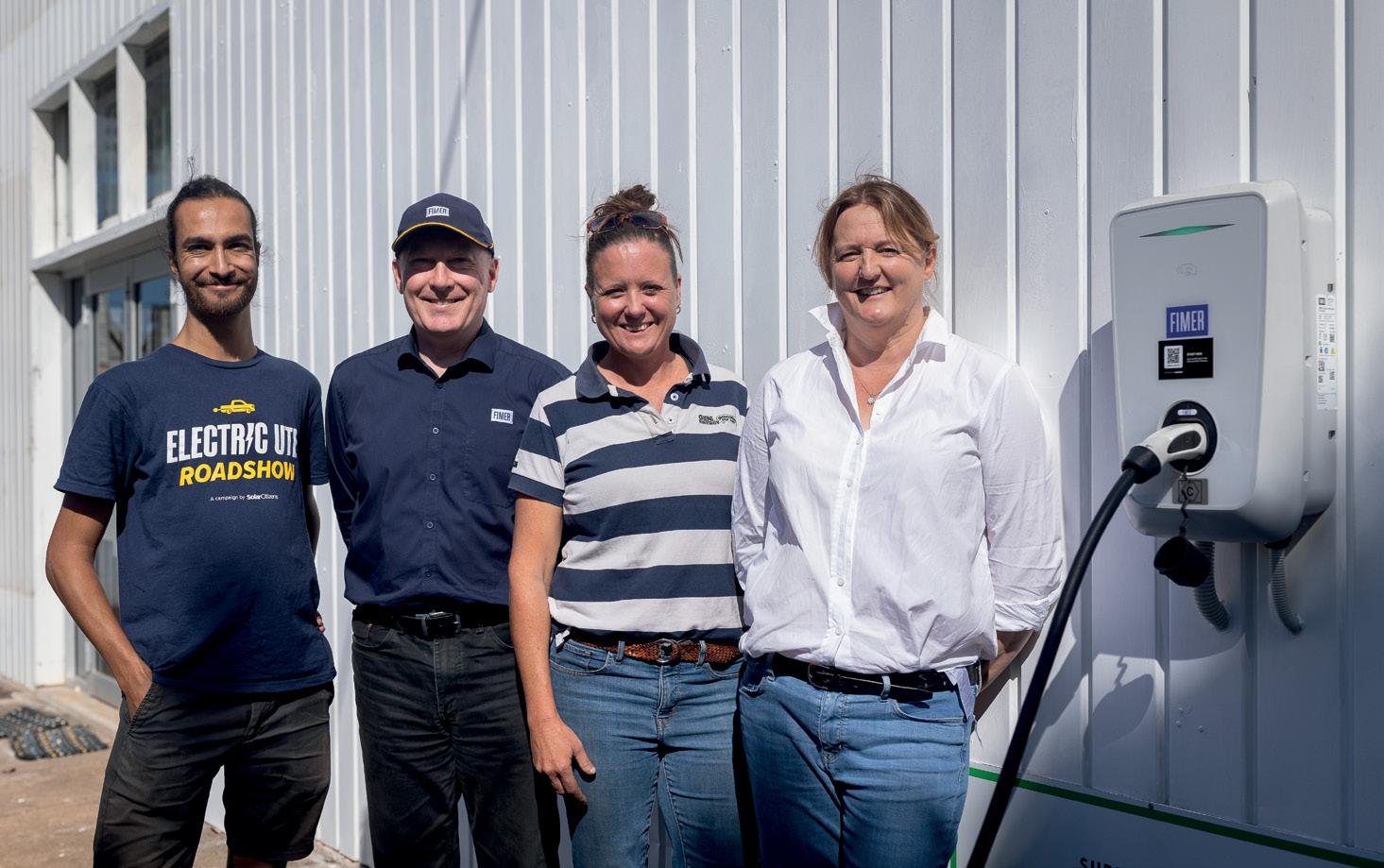
Stations, like FIMER's FLEXA AC Wallbox or Station, or fast DC Charging stations like FIMER's ELECTRA DC Station.
Having this infrastructure in every city (regardless of its size) in Australia will help alleviate people's range anxiety – so they have the confidence to go wherever they need and not run out of charge.
Installation and management of an EV charger is straightforward. The main consideration is to ensure that the related electrical infrastructure has sufficient capacity to provide the necessary power.
There are specialist consultants and integrators that can help councils, businesses and homeowners discuss their charging requirements, not only to choose the right EV charger, but also the electrical distribution infrastructure needed to power the charger – as this can be a significant cost.
There are also many Federal and State Government initiatives and grants available to provide financial support for investing in installing an EV charger or other electrification and energy efficiency projects.
Another way councils can help drive this electrification change forward is to assist and encourage local community groups to help push this change with the public.
An example of this is in Narrabri, New South Wales, when Geni.Energy – a not-for-profit organisation championing clean energy living within the Narrabri community – applied to win a FIMER FLEXA AC wallbox charging station for their community and was successful.
FIMER was proud to support not-forprofit organisations looking to make the world a greener place.
The charger was launched officially in May 2023 and is the second public EV charging station available for members of the public to use in the area.
To coincide with the launch, Geni.Energy organised the Solar Citizens Electric Ute Roadshow to visit Narrabri. Their goal is to drive around regional Australia, showcasing the benefits of electric vehicles and the power of electrification.
FIMER is one of the largest solar manufacturers globally and manufactures its string inverters and electric vehicle chargers in Italy.
Since 2017, FIMER has over 55,000 units installed worldwide and launched its electric vehicle charger range in Australia in 2022.
To find out more, go to https://www.fimer.com/anz

Since 2017, we have supplied more than 54,000 charging stations around the world and partnered with the main players in the industry. We have developed AC and DC charging platforms designed to meet the diverse needs of users, who are seeking solutions for private, public and commercial use.
Our FIMER FLEXA AC Wallbox, FIMER FLEXA AC Station and FIMER ELECTRA (Fast) DC Station, are all easy to install and will provide an efficient, reliable and safe charge every time.
Learn more: fimer.com/charging-electric-vehicles

The Macedon Ranges in Central Victoria is renowned for its natural beauty, rural landscapes and iconic landmarks, including Hanging Rock and Mount Macedon. This is why the community is passionate about addressing climate change and doing what they can to preserve the natural environment for future generations.
Macedon Ranges Shire Council is proactively leading the community to a sustainable future by declaring a Climate Emergency, working with communities to develop a shire-wide Climate Emergency Response Plan, and implementing award-winning waste management initiatives.
In March 2021, Macedon Ranges Shire Council joined more than 30 councils in Victoria and 100 across Australia to declare a Climate Emergency. The declaration recognised the urgent need to address the causes and impacts of climate change across all aspects of Council’s operations and in its work with the community.
Macedon Ranges Shire Council’s Mayor, Cr Annette Death, said the declaration led to Council committing within its Council Plan 2021-2031 to lessen the severity of climate change through actions that enable Council and the community to reduce greenhouse gas emissions.
“We recognised this as a key area needing urgent attention and how important it was to our community,” Mayor Death said.
“As part of our Council Plan, we set about identifying initiatives within Council and the wider community that would be impactful to achieving positive inroads in regards to climate action.”
In December 2022, Council adopted its Counting Down to Zero plan, targeting net-zero emissions by 30 June 2030 and outlining key actions to reduce, avoid or offset the Council’s
existing emissions while influencing key stakeholders to do the same.
To date, Council has taken a range of steps to reduce greenhouse gas emissions, including purchasing 100 per cent renewable electricity, the installation of rooftop solar, converting street lights to energy-efficient LEDs, and transitioning Council fleet passenger vehicles to hybrid and electric vehicles.
Plans are also underway to replace gas boilers at Council’s aquatic centres with electric heat pumps as part of a broader aim to “get off gas” at all council facilities.
Council has also facilitated the development of local community climate action plans across seven townships in the shire under a program called Cool Changes.
Each township’s plan takes a customised approach and empowers local residents to address climate change in a way that best suits their circumstances, further encouraging climate action initiatives at a grassroots level.
Earlier this year, Council launched Cool-ER Changes to develop a shire-wide Climate Emergency Response Plan for both Council and the community, and to mark the next step in the journey to a better climate future
“Cool-ER Changes aims to develop a universal action plan for the shire. It addresses climate action more broadly by looking at all aspects of our life as impacted by climate change, including our connection to nature, rural land management,
future-proofing community sport, the liveability of our homes and low carbon energy and transport,” Mayor Death said.
“It brings together actions identified in the individual plans developed by each township through the Cool Changes program and considers them part of the bigger picture for our region.”
The plan is informed by a number of themed workshops delving into discussions on topics including healthy ecosystems, renewable energy, waste management and responses to natural disasters.
“The workshops provide the opportunity for community members, stakeholder agencies and Council representatives from across the shire to come together and collaborate on a holistic plan for the region,” Mayor Death said.
“We have seen an exchange of ideas and experiences and enthusiastic discussions about accelerating action over the next few years.”
A draft plan will be prepared and placed on public consultation for wider community feedback later in 2023, before a final version is adopted by Council, signalling a commitment to its implementation over the next few years.
Macedon Ranges Shire Council has also been extremely proactive in the resource recovery space, implementing initiatives that challenge traditional waste management methods and complement the broader climate action plan.
Macedon Ranges Shire Council was one of the first councils in Victoria to introduce the four bin waste and recycling system in February 2020. The household kerbside service consists of four colour-coded bins for residents to sort their waste into: yellow for recycling; green for FOGO – food and garden organics; red for general waste; and purple for glass only.
Each bin also includes infographics to identify what waste goes where. Since its implementation, it has seen a diversion of 74 per cent, some of the highest diversion rates in Victoria.
The initiative was also awarded Most Outstanding WARR (Waste and Resource Recovery) Project in the regional category at the Waste and Innovation Recycling Awards 2022.
The Victorian Government announced last year that it would roll out the four-bin service in all council areas across the state by 2030.
“We were an early adopter of the four-bin system compared to other LGAs, and our residents adapted and embraced the concept quite quickly, leading to its success,” Mayor Death said.
“Our community is very passionate about recycling and doing what they can to help the environment, and they are very willing to try new things in this area which has enabled us to implement and trial a range of new initiatives.”
These initiatives include:
∞ Launching a kerbside soft plastics recycling program trial in the township of Romsey
∞ Introducing a reusable nappy, sanitary and incontinence product rebate pilot program to encourage the community to access affordable reusable options
∞ Delivering reusable cloth nappy workshops to help educate families and reduce about 3.5 million disposable nappies sent to landfill each year in the shire
∞ Phasing out single-use plastics across all Council operations and facilities and introducing a single-use plastics policy
∞ Implementing the four-bin system at Hanging Rock Reserve, a major tourist destination for the Macedon Ranges, to encourage visitors to think about how they dispose of waste
∞ Collecting polystyrene at the resource recovery facilities for recycling, and soon to introduce textile recycling.
∞ Working with RMIT University and industry on combining biochar into roads and footpaths to increase longevity
Waste from Council’s kerbside collections and resource recovery centres is repurposed in various ways, including converting glass into road base materials and turning FOGO material into Australian Standard compost, which is available at cost to the community.
Mayor Death said Council would continue to prioritise proactive ways to manage waste and implement initiatives to take action on climate change at a local level and more broadly.
“Every little bit helps – we need to do as much as we can right now to mitigate the effects of climate change and provide a better future for generations to come,” Mayor Death said.
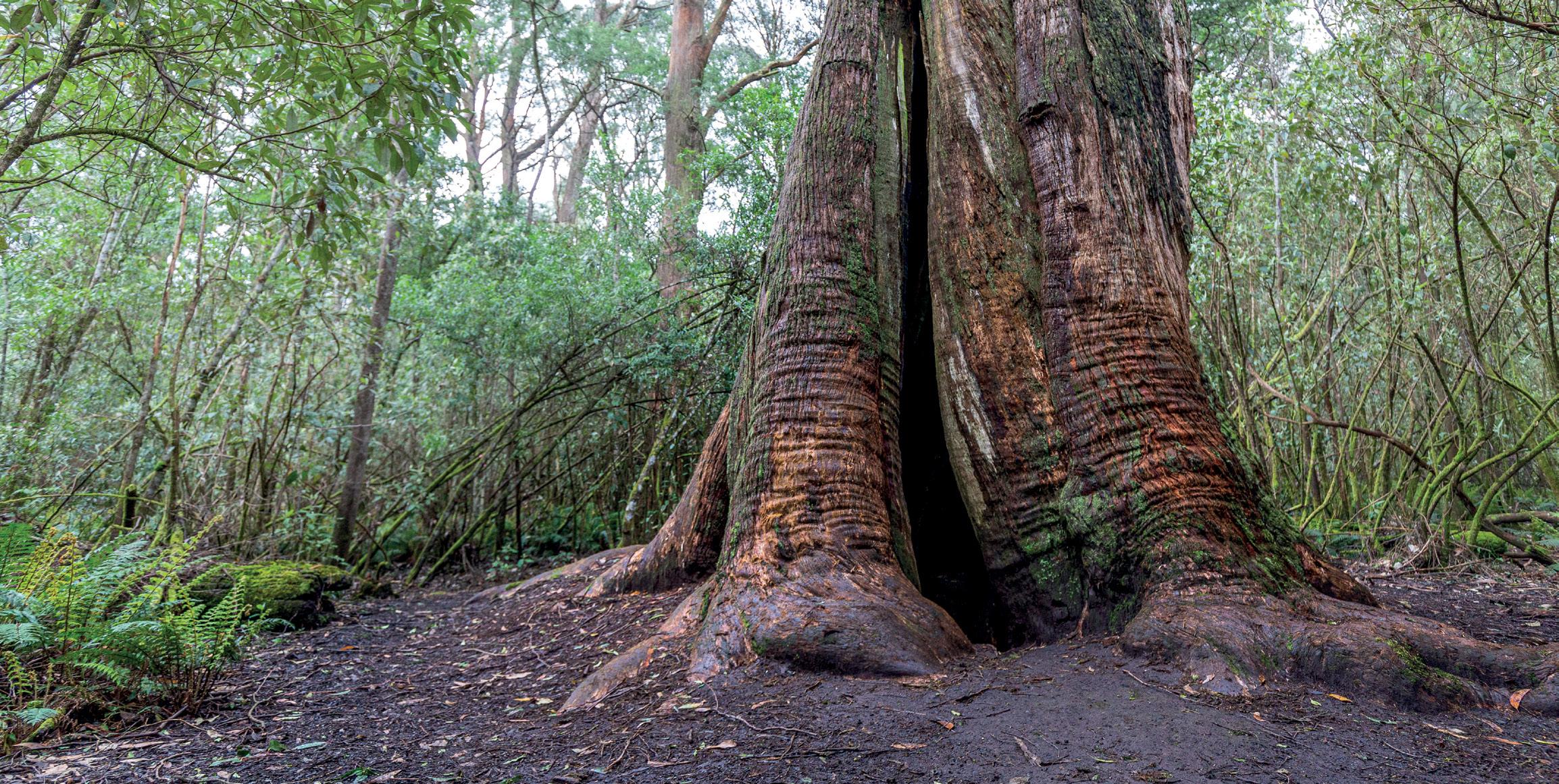
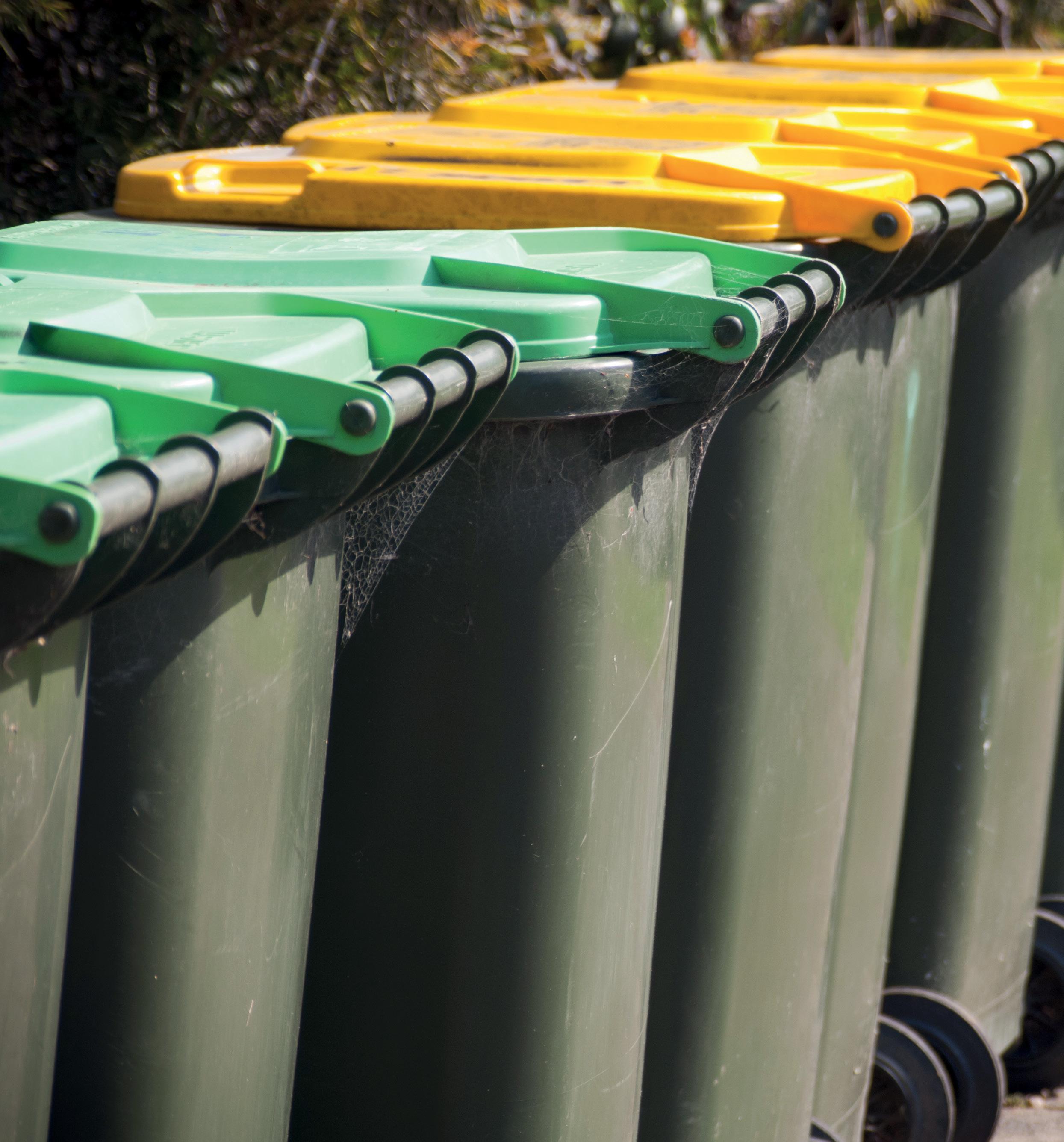
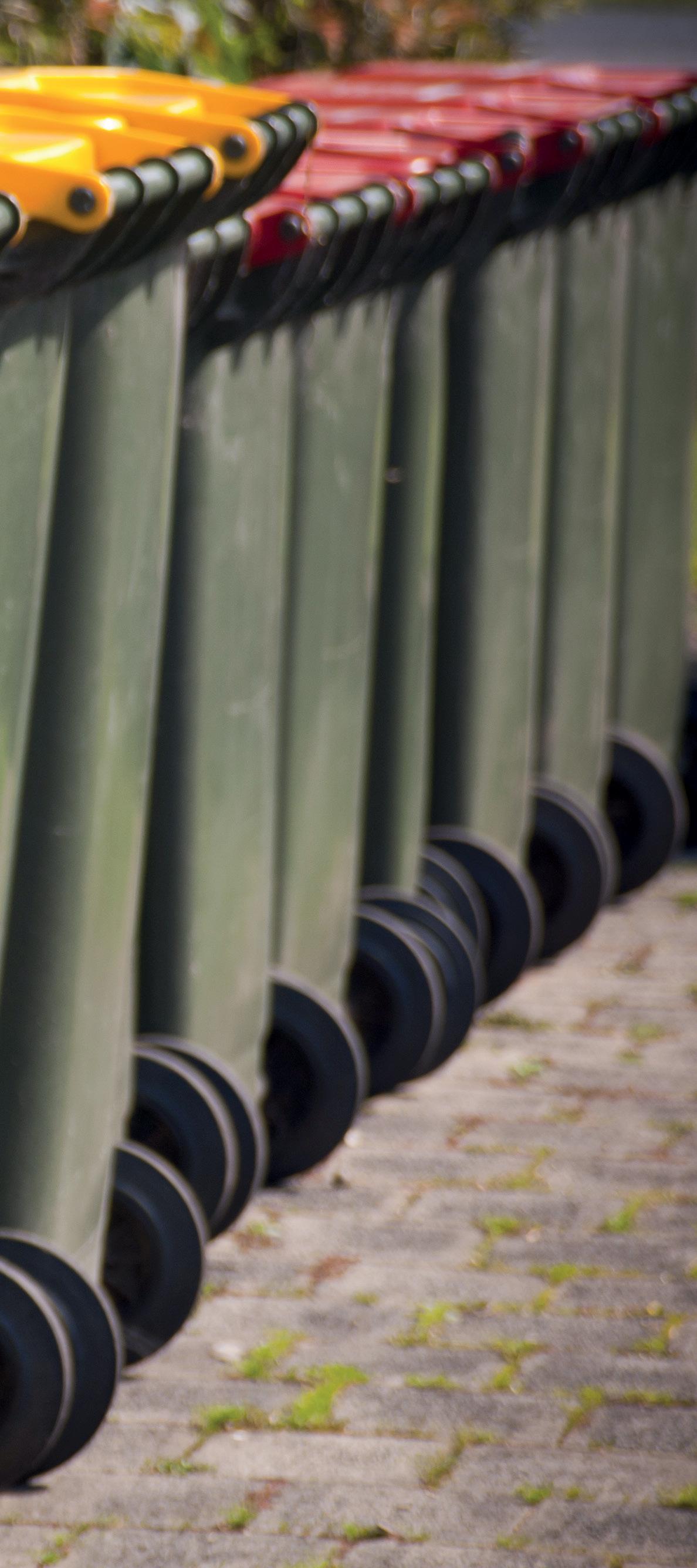 By Stephanie Nestor, Assistant Editor, Council Magazine
By Stephanie Nestor, Assistant Editor, Council Magazine
As 2030 approaches, councils are working to make sure Australia halves the amount of food and organic waste sent to landfill, but with the same old challenges getting in the way, there is still a lot to learn.
Since the original release of the National Waste Policy Action Plan in 2019, councils around Australia have been trialling and setting up food organics and waste organics (FOGO) waste collection services for residents to halve the amount of organic waste being sent to landfill by 2030.
While many of these programs have been successful, councils have inevitably run into challenges and obstacles that have slowed down green bin roll-outs.
Whether it’s navigating the unique requirements of highrise buildings or finding a waste processing facility, local governments have hit various roadblocks along the way.
But all these challenges are proving to be learning opportunities on the journey to reducing waste.
Nation-wide Australia has 537 councils, with 234 of them offering FOGO services as of May 2023.
While the target has been set by the Federal Government, for local governments, that number will not approach 100 per cent unless cost and infrastructure problems are resolved.
Since Council Magazine’s previous FOGO update, councils are still tackling the same four challenges:
1. Providing services for high-rise apartments
2. Garnering community support and engagement
3. Accessing waste processing facilities
4. Reducing organic waste contamination
Despite these challenges, more councils are finding ways to set up FOGO waste collection services.
For example, last year, the City of Port Phillip had not figured out a strategy for offering FOGO services to residents in highrise buildings, but as of January 2023, the City has adopted a hybrid approach – some residents will have kerbside pick-up bins, while others will have communal drop-off points.
Another example is Manningham City Council, which previously could not roll-out FOGO services because there were no available waste processing facilities, but Council has since announced it will be introducing services as of July 2023.
With the clock ticking closer to 2030, it’s not only important for more waste processing infrastructure to be built, or for more funding to help set up FOGO waste collection trials, it’s also vital that councils learn from each other’s successes and failures to understand what it takes to keep the green bins rolling.
Here are five councils from around the country that are tackling these challenges and providing successful FOGO roll-outs.
In Queensland, FOGO bin roll-outs have been slow, with only eight of the 78 local governments implementing services so far. However, the councils with services are making significant strides and setting an example for the whole state.
One in particular, Lockyer Valley Regional Council, has managed to convert 400t of organic waste into soil conditioner.
With a $320,000 grant from the Queensland Government, Council was able to roll-out over 1,000 green bins to trial collection frequency, waste processing infrastructure and community engagement. As a result, Council set up its own temporary composting facility to process the organic waste using forced aeration, turning it into soil conditioner.
This not only meant Council diverted hundreds of tonnes of food and organic waste from landfill, saving on costs and emissions from landfill pits and sites, but also were able to recycle the waste. The soil conditioner went on to be used for community gardens, childcare centres and schools in the region.
This trial ended up saving Council 768t3 of carbon emissions.
Additionally, visible results of the trial in local public spaces helped to promote community awareness and support for Council’s FOGO initiative. It initiated a behavioural change in the community to understand that FOGO collection services are about more than just diverting waste – it can also recycle and reuse waste to be used in the community.
In 2022, City of Melbourne was struggling to set up FOGO services for high-rise apartments, with many buildings inaccessible for trucks and waste disposal personnel, and concerns from residents about the odour from large food waste bins.
With over 80 per cent of residents living in high-rise buildings in the City of Melbourne and organic waste making up over 45 per cent of waste from apartments, it was important Council’s FOGO collection services made allowances for high-density housing.
As of February 2023, the City of Melbourne is running a pilot program to trial FOGO collection for six high-rise buildings for 12 months. These buildings were selected through expression of interest, with the six chosen eager to set up services.
The pilot is designed to suit the unique needs of each building to test tailored approaches and understand what strategies work for which circumstances. All the buildings selected were six or more storeys high, making this a leading pilot program that can offer insight for other councils around metropolitan areas.
The pilot program is also trialling how Council can convert the organic waste into fertiliser to use in Melbourne’s parks and gardens, hopefully creating a circular economy.
Also striving to create a circular economy for its community, Greater Bendigo City Council is taking steps to ensure less of the city’s waste ends up in landfill and can actually be recycled.
In September 2022, Council entered into a service agreement to establish a FOGO processing and recirculation facility. With the Eaglehawk Landfill just outside of Bendigo expected to reach capacity later in 2023, Council is
endeavouring to develop new circular economy solutions to manage its waste and resources.
In partnership with Western Composting Technology, a new facility will be established next to the Bendigo Livestock Exchange in Huntly on Council-owned land. The facility will be privately owned and operated by Western Composting Technology.
It is expected this recirculation facility will process 20,000t of FOGO waste each year initially, with a maximum capacity of 30,000t and capacity to increase demand if necessary. At maximum capacity, the facility will help reduce Bendigo’s emissions by 16.3 per cent.
Additionally, the facility will mean Council doesn’t need to transport its organic waste out of the region to be processed, saving costs while allowing Council to reuse the waste as compost. This is a particular problem for regional areas, with councils often being forced to move waste facilities closer to metropolitan areas for processing, which becomes too costly in the long-run.
With a local processing facility, Council can ensure there will be more than enough capacity for the city to not only process FOGO waste but also see it reused in the community.
In Tasmania, the City of Launceston offers a voluntary kerbside FOGO collection service for residents, but has temporarily suspended collecting compostable packaging from events in the local area, with concerns about contamination.
Many events around Australia, including in Launceston, have begun using compostable packaging for food items, yet this packaging often cannot be processed at recycling facilities because it’s made of mixed materials.
Compostable packaging may contain per-fluorinated and poly-flourinated alkyl substances (PFAS). PFAS are not biodegradable and don't dissolve in water, so while the rest of the packaging might disappear, these synthetic materials still remain – meaning they contaminate water and soil, and are toxic to wildlife.
As a result, compostable packaging processed alongside organic waste will contaminate recycled material and it will no longer be safe to use. With the long-term effects of PFAS exposure on humans still being studied, many countries have already elected to reduce the use of these substances in manufacturing.
In order for the compost material produced from recycled FOGO waste to be safe for humans and the environment, the City of Launceston will wait until new national standards regarding PFAS are established before processing compostable packaging at events.
While it may seem like a step backwards by removing FOGO bins from events in Launceston, this decision by Council will ensure the recycled compost material is uncontaminated and FOGO waste collected from public events can be reused alongside organics collected from households.
In South Australia, 59 per cent of local governments have introduced FOGO waste collection services. With many residents eager for their councils to offer more recycling options, one South Australian Council is listening to the community to know when is the best time for bin collections.
The City of Victor Harbor on the Fleurieu Peninsula trialled weekly kerbside collection for green and yellow bins during the peak Summer holiday period. From December 2022 to January 2023, Council doubled the collection of green and yellow bins, while moving general waste bin collection to every fortnight, to encourage more recycling during Summer.
Prior to the change, the extra collection was expected to recycle almost 75 per cent of all waste collected from households.
As of February 2023, the change in bin collections meant Council’s waste diversion rate improved from 56 to 70 per cent.
Compared to the 2021/22 Summer period, this change meant that landfill was reduced by 23 per cent, with FOGO waste increasing by 60 per cent and general recycling by 16 per cent.
There were similar results for neighbouring councils, District Council of Yankalilla, Alexandria Council and Kangaroo Island Council, with over 20 per cent reduction in waste being sent to landfill.
While some residents found the temporary change confusing, the community had a positive reaction to the collection schedule, with some residents requesting FOGO collection for rural properties in a desire to recycle more.
Bin collections have since returned to the regular schedule, with the green and yellow bins being collected every alternating fortnight. Even though many councils around Australia have already introduced weekly green bin collections, for some areas, bin collection schedules can be tailored to account for peak periods, which will encourage recycling without putting a strain on local government resources.
With more councils implementing FOGO waste collection services, many local governments are considering the next steps to reaching the 2030 target.
On top of halving the amount of organic waste sent to landfill, the National Waste Policy Action Plan also includes targets to recover 80 per cent of waste and significantly increase the use of recycled material in industry and government.
To meet these targets, it will take more than just setting up FOGO waste collection services.
For Victoria, councils will be required to set up a four-bin system, with the fourth bin being for glass recyclables. While some regions already have glass recycling, the Victorian Government has decided to separate glass from regular recyclables in order to be able to recycle glass bottles and other items, which often interfere with recycling other materials such as paper, cardboard and cans.
Another project for councils are waste drop-off points for residents who don’t have kerbside collections for FOGO waste or glass.
From 1 November 2023, Victorians will be able to get back 10 cents on glass bottles and drink cans if they drop-off
these recyclables at collection points. These collection points will be spread across metropolitan and regional areas.
This container deposit scheme is already being offered in other states, with billions of drink containers returned each year in New South Wales alone.
Additionally there is also the problem of dealing with soft plastics, which are not easy to recycle because they are often contaminated with food or are made up of mixed plastics that cannot be separated. While organisations have collected soft plastics from supermarkets in the past, these soft plastics were often stockpiled in warehouses or ended up in landfill.
There are many more avenues to consider as the clock ticks closer to 2030. Councils are in a unique position to trial methods, make mistakes, learn from the community and discover better strategies that will lead the country into a

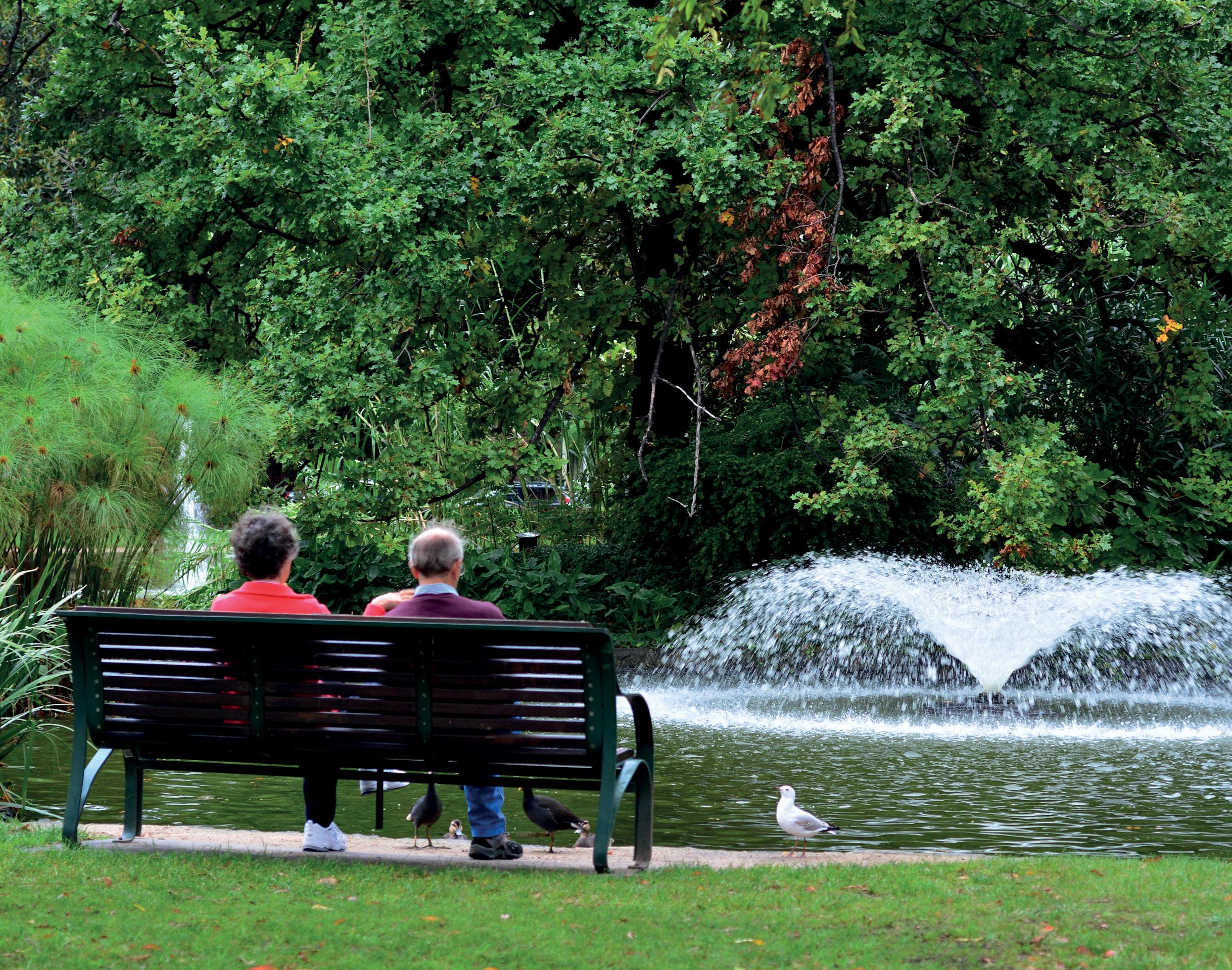
Local governments have a responsibility to ensure public facilities and communities are safe for people living with dementia. Here Council Magazine unpacks why these initiatives are so important, highlighting the efforts of two Australian Councils in creating dementia-friendly communities.
Dementia is an umbrella term used to describe over 100 neurological conditions which cause significant cognitive and functional disability. Dementia is more than memory loss, it can impair perception, executive function, facial recognition, motor function and more.
More than two thirds of aged care residents have moderate to severe cognitive impairment, while 66 per cent of people with dementia are thought to be living in the community.
However, Dementia Australia’s Dementia-Friendly Communities National Manager, Belinda Curtis, said that research shows that many Australians still lack awareness and understanding about dementia.
“This can have widespread repercussions,” Ms Curtis said.
“It may result in people with dementia, their family and carers experiencing stigma and discrimination in a wide range of settings from home, community and retail spaces to the health care sector.”
As the majority of people with dementia live in the community, every council in Australia will come into contact with people who have dementia, their families or carers. These individuals may be paying rates, having their rubbish collected, working in local businesses or using council services.
“Local governments play a critical role in encouraging inclusivity, respecting the rights of people with dementia and facilitating access to the services, supports, activities and spaces to which every Australian is entitled,” Ms Curtis said.
“People living with dementia who are supported to live well in the community are more likely to stay in their homes longer and are less likely to enter residential aged care prematurely.”
Ms Curtis said it is important that local governments make all of their programs and services inclusive and accessible to people with dementia.
“Consultations with people living with dementia, their families and carers is a good place to start to uncover which services and programs are most impactful for them.”
National and international experience shows that successful dementia-friendly communities also typically include consultation with the broader population of the local community, service providers, businesses and council staff.
Other steps may include establishing a local alliance of individuals willing to champion change or creating an action plan with achievable, measurable goals for change, regardless of whether they are small and specific, or big and systemic.
Dementia-friendly communities might focus on creating social, sporting or community groups that self-define as welcoming people with dementia or volunteer or paid employment opportunities for people with dementia.
There may also be informal community events or activities where people feel welcomed and accepted and are able to remain socially active.

Creating dementia-friendly communities can also involve utilising dementia-friendly design principles in public spaces. This could mean ensuring furniture is unambiguous, using high-contrast colours for clarity, maintaining consistency in lighting levels, clear signage and the inclusion of ‘quiet spaces’.
The City of Melbourne, in partnership with Dementia Australia, has been working towards making the Kathleen Syme Library and Community Centre dementia-friendly.
Applying these principles in the planned activity rooms, access areas and toilets has improved access and participation for people with dementia.
Some of the changes have included:
∞ Flooring that is a contrasting colour to the furniture and walls
∞ Room signage that includes colour contrast text and symbols
∞ Acoustic ceiling tiles to absorb sound within the interior
∞ A non-patterned floor covering
∞ High quality lighting to limit dark shadows
∞ A coloured toilet seat that contrasts with the toilet
∞ A sensory garden with scented plants with tactile foliage and flowers

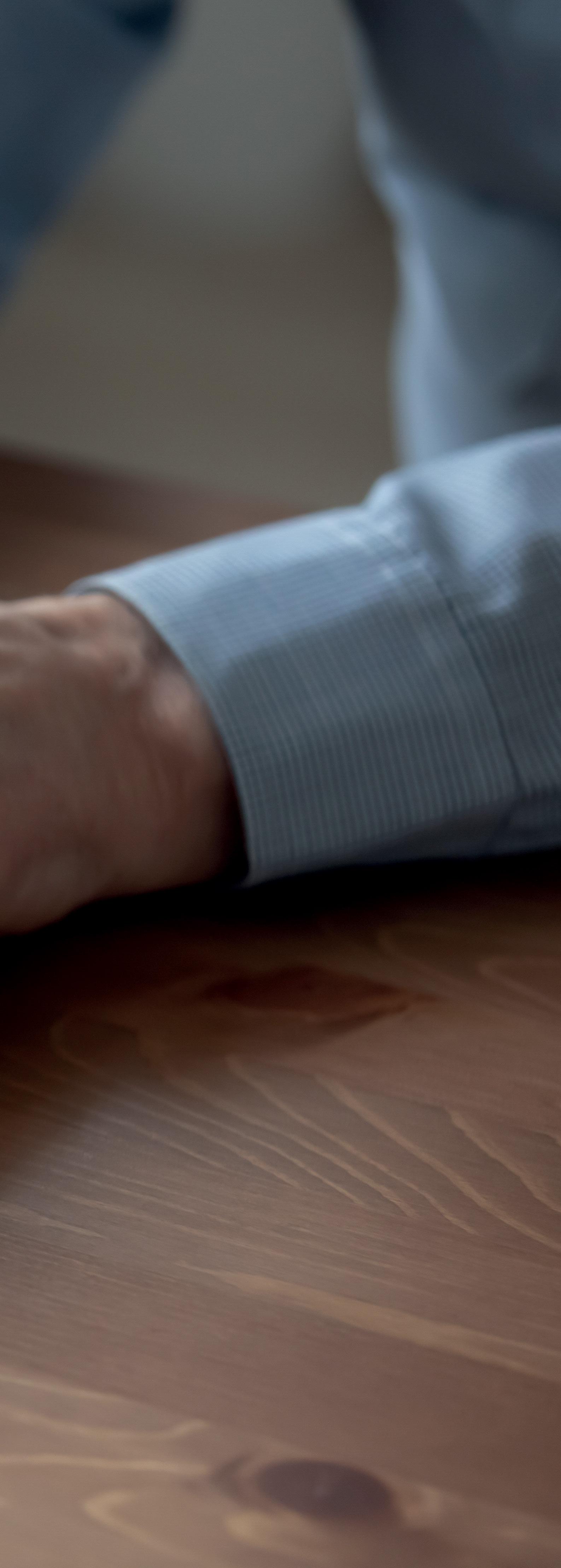
It is estimated that there are over 8,000 people living with dementia within the Northern Beaches, with 70 per cent living in their homes and the community. By the year 2058, it is projected that the prevalence of dementia in the LGA will increase by approximately 150 per cent.
Northern Beaches Mayor, Sue Heins, said, “This means dementia is likely to have a bigger impact on our area as the proportion of residents aged 65+ is greater than other parts of Sydney.
“We want the Northern Beaches to be a place where people with dementia can continue to participate fully in community life.”
Council signed a Dementia-Friendly Statement of Commitment with Dementia Australia in May 2021 and worked closely with the Northern Beaches Dementia Alliance and Advisory Group to develop Council’s Dementia-Friendly Organisation Plan.
To date, as part of this plan, Council has supported the Northern Beaches Dementia Alliance to host information sessions and workshops about dementia, including creating a “how to communicate well with people living with dementia” information card that was widely distributed to local businesses, and helped set up a website that has local information for residents about services and programs.
Ms Curtis said that building positive attitudes towards people with dementia involves raising community awareness, and at the same time reducing the stigma and discrimination that people with dementia often experience.
The easiest and most effective way to do this is through free staff and public education.
Dementia Australia offers online and face-to-face programs that are designed to raise awareness among staff and community members. It also provides professional dementia education for customer-facing staff as part of its Centre for Dementia Learning.
As part of its Dementia Friendly Organisation plan, Northern Beaches Council now has 700 staff trained in Dementia Australia’s ‘Become a Dementia Friend’ module. This module is now included in the new starter induction for all new employees and will be continued to be rolled out to increase dementia awareness among staff. Further face-to-face dementia-friendly training was provided to 104 customer facing staff.
Council has also conducted an audit of identified priority Council facilities with recommendations on how to make these spaces more dementia friendly.
The Northern Beaches libraries team has been working hard to ensure its libraries are Dementia Friendly spaces. Mona Vale is the LGA’s Dementia Friendly flagship library, featuring a dementia-friendly collection and dementia-friendly space.
Council was involved in delivering a Dementia Expo at Dee Why RSL on 4 May 2023. Hosted by the Northern Beaches Dementia Alliance, the event sought to connect the public to support services and programs in the local area.
While no two dementia-friendly communities will look the same, in a broad sense, they are places in which a person with dementia is supported to live a high-quality life with meaning, purpose and value. Local governments can take inspiration from some of the initiatives that have been implemented in Australia to develop their own approaches for creating inclusive communities that don’t leave those with dementia behind.
Environmentally friendly, affordable and convenient, it’s no wonder that e-scooters and e-bikes have taken off in cities around the world. Sunshine Coast Council is the latest adopter, partnering with e-scooter operator, Neuron Mobility, to safely trial the trendy transportation throughout the city – aiming to improve mobility and reduce road congestion.

On 8 June 2023, Sunshine Coast Council and Neuron Mobility launched an 18 month trial that will see a gradual rollout of 400 of Neuron’s distinctive orange e-scooters and up to 75 e-bikes throughout a 13km² riding area across Maroochydore and Mooloolaba.
Neuron Mobility works closely with a range of councils across Australia to improve mobility by designing shared e-scooter and e-bike programs.
Tim Morris, Neuron Mobility Regional Manager, said the Sunshine Coast trial will benefit both locals and visitors by creating a car-free way to get around the coast.
“Here on the Sunshine Coast, traffic congestion as well as the congestion for parking spaces is a real challenge in the local community,” Mr Morris said.

“Whether you're a visitor for the day, staying for an extended period or a local here on the coast, we think that e-scooters and e-bikes will give people a way to get around the area without needing to rely on using their own car.
“We're hoping the program will really make a significant reduction in local traffic congestion as well as carbon emissions by getting people to switch over to a more sustainable mode of transport.”
There are obvious environmental benefits to electric modes of transport, as they produce little to no direct emissions, create minimal pollution and deliver greater energy efficiency.
However, with the increasing presence of e-scooters and e-bikes
in communities, many have voiced concerns over their safety.
“Neuron is focused on making sure the program is designed to be safe both for riders, particularly riders of e-scooters, but also for the rest of the community as well,” Mr Morris said.
The company’s high-visibility “safetyorange” e-scooters and e-bikes are fitted with safety features including an app-controlled helmet lock, voice guidance, a ‘follow my ride’ feature, an emergency button and topple detection. New riders are required to agree to a list of riding rules before they are allowed to take their first trip.
Neuron’s e-bikes and e-scooters are also equipped with advanced geofencing technology that controls where they’re ridden and how fast they can travel in certain areas.

“Along the Sunshine Coast, there's a lot of really great shared paths, but we know that the shared path mix can be quite busy with pedestrians, dog walkers, people in wheelchairs and people with prams, so it can be quite a congested space,” Mr Morris said.
“So we've got what we call a low speed zone in place all along the shared path, so that will limit the e-scooters to a maximum of 12km per hour, which is in line with the Queensland regulations for personal mobility devices.”
Areas that are unsuitable for e-scooters are defined as no-ride zones.
Mr Morris said that when it comes to safety, it is key to work closely with the local council, which knows the area well and understands how communities use these public spaces.
“Here on the Sunshine Coast, we've worked very closely with Council to make sure that we've got the right parameters in place for the trial,” Mr Morris said.
“That begins with choosing the right area and looking at the infrastructure that's available in the area – such as looking at the quality of the footpaths, the shared paths, if there's bike lanes – to make sure that there is actually going to be suitable infrastructure for e-scooters and e-bikes to use.
“We've started with the Sunshine Coast in the area across Mooloolaba, Alex Heads, Cotton Tree and Maroochydore, which really is the key visitor and commercial precinct here on the Sunshine Coast.
“Getting the area right is absolutely important, and then within the area, it's looking at the specific risks that are involved in different locations.”
This also means ensuring that e-scooters and e-bikes are parked in designated places and do not obstruct other members of the community.
“We know that if e-scooters and e-bikes are not parked correctly, it can cause an obstruction for other users of the paths, particularly pedestrians, persons with disability or parents with prams, so we've worked closely with the council to actually identify designated parking spots.
“Rather than being able to park anywhere and everywhere, people will be required here on the Sunshine Coast to actually park in designated locations that have been approved by the council.
“We are really hoping that it will alleviate a lot of the concerns around parking and really making sure that people are parking in correct locations, and we've got some really smart technology to help ensure that people do park in the correct locations.”
Geofencing will work in conjunction with Neuron’s new
augmented reality Parking Assistant technology to ensure bikes and scooters are parked in one of the designated parking stations located across the city.
To coincide with the launch, Neuron and the Australian Road Safety Foundation (ARSF) teamed up to promote rider safety, hosting a number of ScootSafe events.
Mr Morris said it was a great opportunity to engage with the local community.
“There were lots of people that hadn’t ridden e-scooters before and wanted a bit of a hands-on tutorial to understand how they work and how to ride them safely,” Mr Morris said.
“A lot of people just wanted some general information, to know how the program works, where they can be parked, how fast they can be ridden, and a little bit about how much they cost as well.”
Neuron also deployed safety ambassadors on the ground at key times of the day over the launch period.
“I would certainly encourage councils that are considering how e-scooters and e-bikes can fit within their community to speak with one of the operators,” Mr Morris said.
“I would also suggest that councils reach out to other councils that have been through the journey before, so they can really understand those learnings and design the program to be right for their community.”
E-scooters and e-bikes are just one way councils can be part of the shift towards more sustainable transport options.

As Australia progresses towards its net-zero targets, governments must contend with the issue of waste piling up in landfills and polluting the air with greenhouse gases. Employing circular waste management solutions, such as Energy from Waste (EfW) programs, can drastically reduce emissions and conserve natural resources – all the while generating renewable energy.
In October 2022, Maroondah City Council broke new ground by becoming the first Victorian council to contract the supply of municipal solid waste to a thermal Energy from Waste (EfW) facility.
EfW, also known as Waste to Energy (WtE), refers to treatment technologies which derive the energy value from waste and turn it into electricity, biogas, heating or fuel.
EfW consortium partners Opal, Veolia and Masdar Tribe Australia (MTA) are responsible for the development, construction and operation of the Maryvale EfW facility, to be located adjacent to Opal’s Maryvale paper mill in the Latrobe Valley.
Maryvale Mill is a major generator of base load renewable energy in Victoria, through the production of black liquor biofuel from its pulping process. The EfW facility will further complement the mill's use of alternative energy sources. EfW plants that produce both steam and electricity deliver Combined Heat and Power (CHP) for much higher energy efficiency than stand-alone electricity generation.
The Maryvale EfW facility will apply ‘moving grate’ technology that creates energy from the controlled combustion of non-hazardous waste materials that would otherwise go to landfill. The energy generated is base load power which is required to run Opal Australian Paper’s manufacturing plant.
Maroondah City Council CEO, Steve Kozlowski, said, “Reliable and proven technology was a core part of Maroondah City Council’s evaluation process, which required a demonstrated track record for efficiency and reliability.
“Using moving grate technology utilised in over 90 per cent of European thermal facilities, like that used for the Maryvale EfW facility, was considered a significantly positive aspect.”
Sending waste to an EfW facility instead of landfill avoids methane emissions. It is estimated that the facility will achieve a net reduction of 270,000t per annum in greenhouse gas emissions, equivalent to removing 50,000 cars from the road annually.

Mr Kozlowski said the facility “provides an essential source of renewable, sustainable energy and is a vital link in the waste management chain”.
With numerous local government areas in and around the Melbourne and Gippsland regions, the Maryvale EfW facility is


engaging in multiple council procurement processes to secure sufficient residual municipal waste volumes.
Up to 325,000t of non-recyclable residual waste from Councils and businesses will be used to produce energy for the Maryvale Mill, resulting in a net benefit of enough gas and electricity to power over 50,000 homes on Victoria’s energy network.

Maroondah City Council will send roughly 20,000t of non-recyclable household general waste to the Maryvale EfW facility per annum.
A spokesperson for the EfW consortium said, “The decision of Maroondah City Council to commit its non-recyclable residual waste to the Maryvale EfW facility is testament to its environmental leadership and vision in sustainable resource recovery.
“It is a positive signal to other Victorian Councils that they too can embrace a circular economy solution for residual waste that reduces their reliance on landfill, maximises materials recovery for reuse and complements other resource recovery initiatives, such as recycling and organics processing.”
A sustainable approach to waste is one of the eight outcomes in Maroondah’s long-term vision for 2040. Council has already made significant progress in sustainability and was certified Carbon Neutral by Climate Active in March 2021 for its operations as a public statutory body.
Council has also developed its own Waste, Litter & Resource Recovery Strategy 2020-2030, which encourages these innovative ways to deal with waste in the future.
“The strategy ensures Council continues to focus on more sustainable waste and recycling methods, with the main
objective to reduce the amount of waste going to landfill,” Mr Kozlowski said. Given this strategy is in place, Mr Kozlowski said that partnering with Opal, Veolia and MTA was the logical choice.
“With 24,861t of recycling and green waste diverted from landfill in 2021/22, Maroondah households are leading the way with waste reduction and currently create less landfill waste than the average Melbourne household.”
Mr Kozlowski said being able to supply non-recyclable municipal solid waste to the new EfW facility will help Council exceed its strategic target to halve waste to landfill by 2030.
“This will create a more resilient waste and recycling system, ensuring our reliance on landfill is minimised as the finite capacity of Victorian landfills diminishes in coming years,” Mr Kozlowski said.
Opal has undertaken a range of consultation processes with the community throughout the planning and development of the EfW plant at Maryvale, including focus groups, establishing an information centre for locals to visit, and publishing regular advertisements in local news to provide information on the project.
As of February 2023, Opal has conducted more than 300 community and stakeholder engagement activities and engaged surrounding councils as well as community and business groups.
Maroondah City Council also consulted its community and received widespread support for its EfW program.
Mr Kozlowski said people are quite engaged with waste reduction and recycling, in particular following the recent introduction of a food organics and garden organics (FOGO) service.
“Consultation to develop Council’s ten year Waste, Litter & Resource Recovery Strategy 2020-2030 showed that the Maroondah community continues to be supportive of practical changes which reduce our environmental impact whilst contributing to a circular economy.”
For other Australian councils looking to implement similar programs, there will be a myriad of factors to consider.
“It will be dependent on the particular region and their individual circumstances,” Mr Kozlowski said.
“Maroondah made its decision in the belief that the Maryvale EfW facility can deliver a cost-competitive residual waste solution, and supports the development of EfW facilities in appropriate locations as a superior environmental solution to landfill for residual waste.”
Organic waste sent to landfill produces a significant amount of methane gas that harms the planet. By diverting waste from landfills through EfW programs, councils can turn waste into a resource for generating sustainable energy, reducing emissions and creating better environmental outcomes.
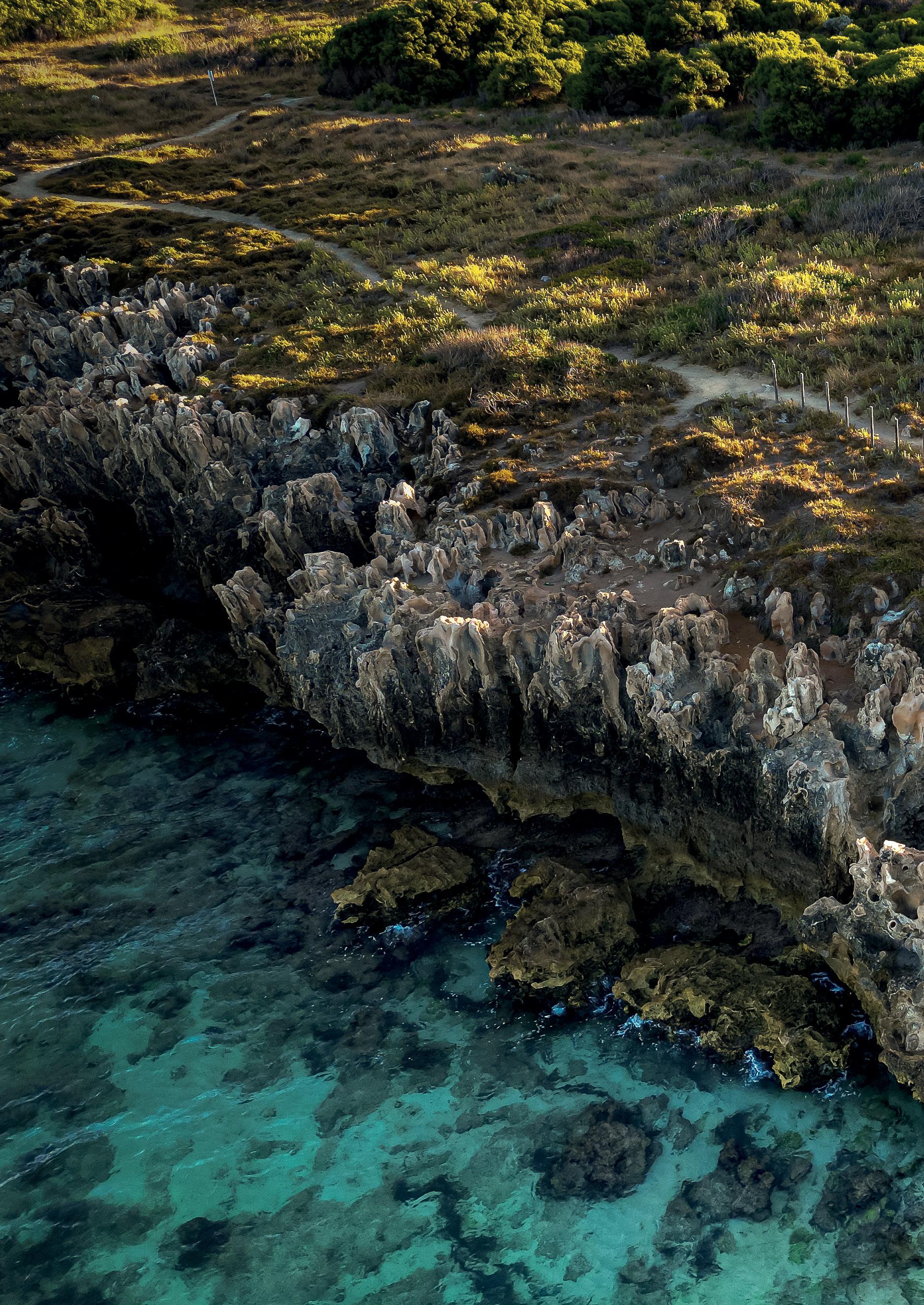
Each edition of Council Magazine we choose one local government from across Australia to shine a spotlight on. Whether it’s new infrastructure, an innovative technology project, a leading sustainability initiative or a community connection, we want to highlight the best of our local governments and share some valuable knowledge to other place makers across our nation. This edition, we spoke to the City of Cockburn in Western Australia to discuss its incoming opportunity to break traditions and build a unique, blue economy.

On the coast of Western Australia, the City of Cockburn is brimming with opportunities, abundant natural resources and well-planned infrastructure – and alongside these features the region’s blue economy is set to continue booming, all thanks to a new international deal.
The United Nations refers to the blue economy as the sustainable use of ocean resources for economic growth, improved livelihoods, and jobs, while preserving the health of the ocean ecosystem.
The City of Cockburn said a blue economy is an obvious focus for Australia impacting sectors such as tourism, fishing, maritime, port, and navy defence industries for hundreds of local governments across the country.
In 2022, anticipating further spending in defence and maritime industries, Council formed a Blue Economy Advisory Group, which now has over 30 members who meet quarterly, reflecting and advising on the growing blue economy in the region.
Members of the advisory group include the Australian Defence Force’s Office of Defence Industry Support (ODIS), the Department of Jobs, Tourism, Science and Innovation, The University of Western Australia, Curtin University, the Australian Defence Industry Network, the Henderson Alliance and large local operators including BAE Systems, Austal, Civmec and Luerssen Australia.
In March 2023 Prime Minister, Anthony Albanese, announced the AUKUS deal was signed, with the goal of acquiring nuclearpowered submarines in partnership with the UK and US.
The AUKUS agreement stated that it has a key aim to “build a future made in Australia, by Australians, with record investments in defence, skills, jobs and infrastructure”.
The City of Cockburn is already well-established to make this future a reality due to its continued support of, and growth, of its blue economy businesses.


City of Cockburn Executive of Corporate Affairs, Victoria Green, who is responsible for economic development, said the City was incredibly proud to “walk the walk” in partnering with its community to “identify innovative ways to support Cockburn’s vibrancy and economic diversity, and sustain that well into the future”.
“Helping our business community establish networks to responsibly identify and develop the blue economy is a no-brainer,” Ms Green said.
“This is how local government can help foster and grow healthy, passionate communities where people want to work, live and invest. It’s great for our future.”
Cockburn’s blue beaches are not only a fantastic destination for locals and tourists. The local coastal suburb of Henderson is also home to Australia’s largest marine industry; a $15 billion cluster of maritime infrastructure – the Australian Marine Complex (AMC), where demands of the AUKUS will be supported.
“The City has had a long association with the Australian Defence Force as the AMC is one of only two locations suitable for naval shipbuilding in Australia,” Ms Green said.
“The AMC and surrounds is a world-class centre of excellence for manufacturing, fabrication, assembly, maintenance, and technology development, servicing the defence, marine, oil and gas, and resource industries.”
Prior to the AUKUS announcement, the operators in Henderson had already forecasted $2.7 billion of additional investment in shipbuilding infrastructure. But now, with the AUKUS submarine pathway announced, Ms Green said Cockburn is “poised to become a major national and global
centre for blue economy industries, especially shipbuilding and maritime defence”.
Part of the forecasted growth includes: construction or upgrades for 70 defence vessels, along with $45 billion in shipbuilding orders in Western Australia by 2040. This will create 4,500 additional ship construction jobs in the state by 2030.
“This puts Cockburn Council in a unique position,” Ms Green said.
“Our City is advocating on behalf of its industrial and commercial stakeholders and residents, to champion infrastructure investment that will enable Henderson to meet the challenges ahead, and consolidate its role.”
With major investment ahead for the region, the expanding blue economy will be supporting significant job opportunities.
“At its peak, it is expected that building and sustaining US, UK and sovereign nuclear-powered submarines will create up to 8,500 direct jobs in the industrial workforce,” Ms Green said.
With forward planning a clear focus for Council, it has been consulting with the local blue economy-focused businesses, training organisations, and major defence, shipbuilding and maritime industry stakeholders, to identify ways to leverage future projects and job opportunities.
“It’s an exciting time in Cockburn’s history and we’re acting to take advantage of this once-in-a-lifetime opportunity,” Ms Green said.
Ms Green explained Council’s plan for a Council-driven marine and defence innovation hub positioned near the Henderson shipbuilding precinct, how it is gaining momentum and why it could have huge implications for the future of the region and its workforce.
“The Cockburn Blue Innovation Hub would connect up to 40 blue economy-focused businesses with major maritime and defence and research organisations under one roof,” Ms Green said.
“The proposed accelerator hub is designed to foster local supply chain capability and capacity.
“A vital part of this will be to find solutions for an estimated shortage of 1,000 workers and a critical deficit of specific trades and technical skills in Cockburn, as well as to bolster the significant local supply chain requirements.
This future planning is also where its Blue Economy Advisory Group is utilised. The group is working to highlight the infrastructure, road improvements, renewable energy operators and investment needed to not only grow the local blue economy, but help the region meet the demands of the AUKUS deal.
“The City is also working with ODIS to help local small to medium enterprises join the defence supply chain and secure long-term contracts, gain exposure to new markets, and become a part of this growth sector,” Ms Green said.
“We’ve hosted an ODIS breakfast briefing session where local SMEs were able to hear about defence opportunities and how to take advantage of them by using a helpful online Defence Business Readiness Tool.”
Ms Green said councils are at the heart of communities, acting in its best interests through providing or supporting basic, vital services and that it can extend past traditional local government expectations of rates, roads and rubbish.
“We can help create wealth for our residents who will benefit from infrastructure investment, further training and employment, as local government takes on an active advocacy role to make representations to State and Federal government for increased investment in these areas.
“We believe helping attract prosperity into our City forms part of those actions to better guarantee a viable future for Cockburn and the more than 122,000 residents that live across our 24 suburbs.
“We can go into bat for our business community to help it foster sustainable practices, and focusing on the resources within our community – like the ocean – the blue economy is an opportunity that can’t be ignored.”



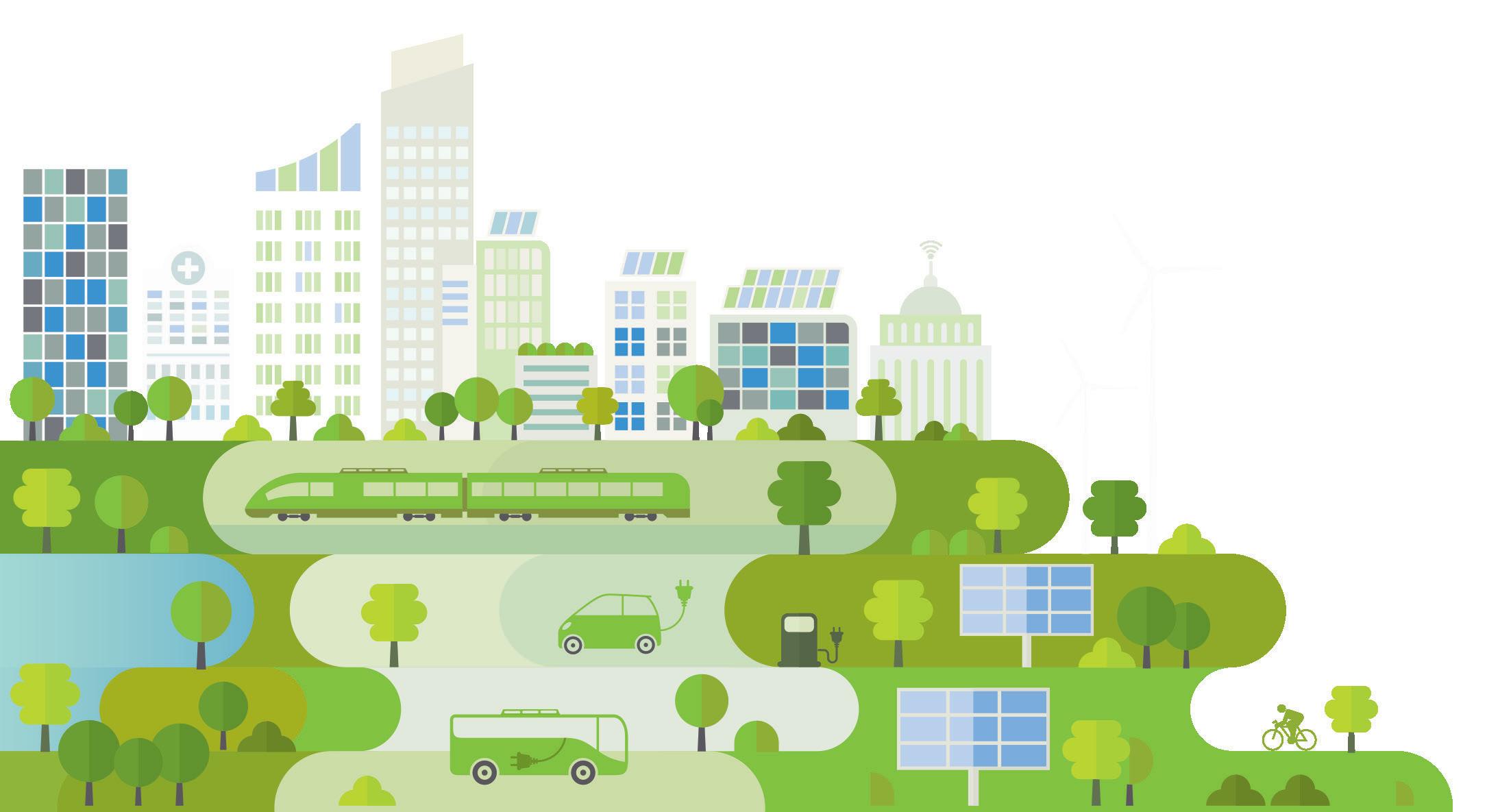

With a Hustler on your team, grounds maintenance is a walk in the park. Rear discharge options available for safe mowing in public spaces.

Put Hustler to the test with your team. Scan to find out more and book an on-site demonstration.